dress
body covering
Introduction
also called apparel or attire
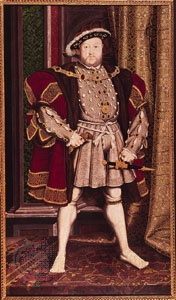 clothing and accessories for the human body. The variety of dress is immense. The style that a particular individual selects is often linked to his sex, age, socioeconomic status, culture, geographic area, and historical era.
clothing and accessories for the human body. The variety of dress is immense. The style that a particular individual selects is often linked to his sex, age, socioeconomic status, culture, geographic area, and historical era.This article considers the chronological development of fashionable dress and decoration—that is, the attire selected and adopted by the leading members of a society. This reflects the fact that in any group of people—whether constituting a small community or a great nation—it is usually those with wealth and power who influence, and even dictate, fashions to other members. The discussion does not concentrate solely on apparel but also covers, as appropriate, certain aspects of hairdressing, jewelry, and the use of cosmetics (cosmetic). In addition, the nature and purposes of dress and some of the specific social, political, economic, geographic, and technological factors influencing changes in fashion are treated. Not treated here are specialized attire, including ecclesiastical dress; military dress; academic, trade, or professional dress; and the national or regional costumes of peasant or indigenous peoples.
The history of Middle (Middle East, ancient) Eastern and Western dress
Ancient Egypt (Egypt, ancient)
Modern knowledge of ancient Egyptian (Egypt, ancient) dress derives from the ample evidence to be seen in the wealth of wall and sarcophagus paintings, in sculpture, and in ceramics; few actual garments have survived. Such illustrative material is depicted clearly and colourfully, but care must be taken in interpreting the designs too literally, partly because the art is frequently stylized but also because the artists were bound by tradition and their representation of dress often lagged far behind the actual changes of fashion.
The chief textile to have been preserved is linen, which has been found in graves from the Neolithic Period. The growing of flax, from which linen is made, dates from very early times; the Egyptians believed that the gods were clothed in linen before they came to earth. wool was more rarely employed, and sericulture, the raising of silkworms, had not yet extended as far west as Egypt.
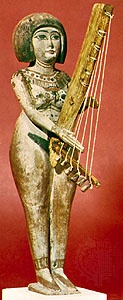 The technique of using mordants (mordant dye), any of several chemicals used to bind dyes (dye) to cloth, was slow to come to Egypt, so most garments were white. Instead, colour was provided by jewelry, in which semiprecious stones were widely incorporated. Among the most common types, the characteristic deep, decorative collar, worn by both sexes, was introduced early. These brightly hued bands were made of embroidered (embroidery) and beaded (beadwork) materials and set around the neck and shoulders either on bare skin or on top of a white cape or gown. In some depictions the collar is clearly the major, if not the only, item of apparel worn.
The technique of using mordants (mordant dye), any of several chemicals used to bind dyes (dye) to cloth, was slow to come to Egypt, so most garments were white. Instead, colour was provided by jewelry, in which semiprecious stones were widely incorporated. Among the most common types, the characteristic deep, decorative collar, worn by both sexes, was introduced early. These brightly hued bands were made of embroidered (embroidery) and beaded (beadwork) materials and set around the neck and shoulders either on bare skin or on top of a white cape or gown. In some depictions the collar is clearly the major, if not the only, item of apparel worn.During the most distant era, dress for both sexes was confined to loincloths (loincloth), a vest or shirt, capes, and robes. Skins of various animals were utilized. These were sometimes simply raw hides (hide), which have survived only rarely, but the Egyptians became skilled at curing the skins to become leather by the tawing method—that is, by the use of alum or salt. Tawing yields a white, stiff leather that may be dyed (dye) various colours (colour). Later they adopted the tanning method, employing oak galls for the purpose. Leather was used widely in dress for footwear, belts, and straps.
During the 3,000 years of the ancient Egyptian culture, costume changed comparatively little and very slowly. It generally emphasized a draped style of dress, the garments consisting of pieces of material held in place around the body by knots tied in the fabric and by belts, sashes, and collars. Little sewing was needed, being confined generally to side seams and, in later years, to armholes. This draped type of dress conformed to that of other civilizations in the Mediterranean and Middle Eastern region, such as Greece, Rome, and Mesopotamia, but differed from the styles of Persia, northern India, and China, where people wore more fitted, sewn garments based upon coats, tunics (tunic), and trousers.
 Over the years the style of these garments slowly evolved and became more complex; a greater number were worn either in combination with or on top of one another. During the Old Kingdom (Egypt, ancient) (its capital at Memphis), which lasted until about 2130 BCE, dress was simple. Men wore a short skirt tied at the waist or held there by a belt. As time passed, the skirt became pleated or gathered. Important people wore in addition a decorative coloured pendant hanging in front from the waist belt and a shoulder cape or corselet partly covering their bare torso. A sheathlike gown was typical of feminine attire. This encased the body from the ankles to just below the breasts and was held up by decorative shoulder straps. Woolen (wool) cloaks were worn for warmth by men and women.
Over the years the style of these garments slowly evolved and became more complex; a greater number were worn either in combination with or on top of one another. During the Old Kingdom (Egypt, ancient) (its capital at Memphis), which lasted until about 2130 BCE, dress was simple. Men wore a short skirt tied at the waist or held there by a belt. As time passed, the skirt became pleated or gathered. Important people wore in addition a decorative coloured pendant hanging in front from the waist belt and a shoulder cape or corselet partly covering their bare torso. A sheathlike gown was typical of feminine attire. This encased the body from the ankles to just below the breasts and was held up by decorative shoulder straps. Woolen (wool) cloaks were worn for warmth by men and women.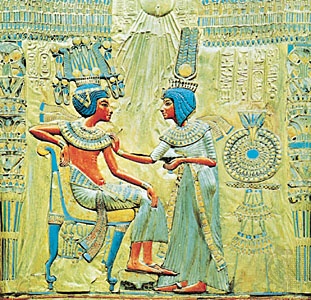 Under the Middle Kingdom (Egypt, ancient) (its capital at Thebes), which prospered until about 1630 BCE, the masculine skirt could be hip- or ankle-length. More material was now used, making the garment fuller, such fullness being concentrated in the centre front; and the pendants became more elaborate and ornamental. A cape might be draped around the shoulders and knotted on the chest. Late in the period a double skirt was introduced; alternatively, a triangular loincloth might be worn under a skirt.
Under the Middle Kingdom (Egypt, ancient) (its capital at Thebes), which prospered until about 1630 BCE, the masculine skirt could be hip- or ankle-length. More material was now used, making the garment fuller, such fullness being concentrated in the centre front; and the pendants became more elaborate and ornamental. A cape might be draped around the shoulders and knotted on the chest. Late in the period a double skirt was introduced; alternatively, a triangular loincloth might be worn under a skirt.The most elaborate dress for both sexes was to be seen under the New Kingdom (Egypt, ancient) from about 1539 BCE until the Egyptians were conquered by the Assyrians (671 BCE), the Persians (525 BCE), Alexander the Great (332 BCE), and finally Rome (30 BCE). During these later years Egyptian dress was strongly influenced by that of the conquerors. New Kingdom dress was more complex than theretofore. The garments were of similar type but were composed of larger pieces of material; draping became more complicated and ornamentation richer. A robe or gown was now worn by important persons of both sexes. It consisted of a piece of fabric measuring 5 by 4 feet (1.5 by 1.2 metres) that was draped and held in place by pins and a waist belt, creating wide, elbow-length sleeves. There were many ways of draping the material, but with most methods all the pleats and folds seemed to be gathered around a single point at the waist. The cape, decorative collar, skirt, and pendant girdle also continued to be worn. Foci of bright colour were provided by the deep collar and pendant apron. Embroidered and carved ornamental motifs included especially the lotus flower, the papyrus bundle, birds in flight, and many geometric forms. Sacred emblems such as the scarab beetle and the asp were worn by priests and royalty.
Children (childhood) were dressed, as in most of the history of costume everywhere, as miniature versions of their parents, although they are often depicted wearing little at all—not surprising considering the climate of Egypt. Servants also were almost naked, as were labourers in the fields, who are depicted clad only in a loincloth.
Heavy wigs (wig) or a padding of false hair (hairdressing), worn by men and women alike, are known from an early period. They served not only as an adornment but also to protect the wearer's head from the burning rays of the Sun, thus in a way acting as hats (hat). Semicircular kerchiefs, tied by the corners at the nape of the neck under the hair, were sometimes worn to protect the wig on a dusty day. Wigs were dressed in many different ways, each characteristic of a given period; generally speaking, the hair became longer and the arrangement of curls and braids—set with beeswax—more complicated as time went on.
The earliest records indicate that Egyptian men grew hair on their chins. They might frizz, dye, or use henna on this beard, and sometimes they plaited it with interwoven gold thread. Later, a metal false beard, or postiche, which was a sign of sovereignty, was worn by royalty. This was held in place by a ribbon tied over the head and attached to a gold chin strap, a fashion existing from about 3000 to 1580 BCE.
Many people went barefoot, especially indoors, but people of rank are depicted outdoors in sandals (sandal) made from palm leaves, papyrus, or leather.
Cosmetics (cosmetic) were extensively applied by both sexes, and considerable knowledge of their use is available because of the Egyptian custom of burying comforts and luxuries with the dead. Examples of the cosmetics used and of the means of making, applying, and keeping them may be seen in museums, especially in Cairo and London. The Egyptians applied rouge to their cheeks, red ointment to their lips, and henna to their nails and feet, and ladies traced the veins on their temples and breasts with blue paint, tipping their nipples with gold. The chief focus of makeup was the eye, where a green eye shadow (made from powdered malachite) and a black or gray eyeliner was applied; the latter substance, called kohl, was manufactured from, among other materials, powdered antimony, carbon, and oxide of copper.
Mesopotamia (Mesopotamia, history of)
 Ancient Mesopotamia (Mesopotamia, history of) was situated in the area of land that is defined by the great Tigris and Euphrates river system (Tigris-Euphrates river system) and that is contained within modern Iraq. Several important cultures arose there, their empires waxing and waning successively as well as overlapping in time. Among the most prominent were the empires of Sumeria (Sumer), Akkad, Assyria, and Babylonia.
Ancient Mesopotamia (Mesopotamia, history of) was situated in the area of land that is defined by the great Tigris and Euphrates river system (Tigris-Euphrates river system) and that is contained within modern Iraq. Several important cultures arose there, their empires waxing and waning successively as well as overlapping in time. Among the most prominent were the empires of Sumeria (Sumer), Akkad, Assyria, and Babylonia.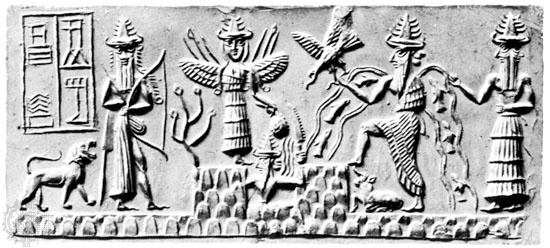 The Sumerian civilization was established before 4000 BCE and reached a high level of culture between 2700 and 2350 BCE. In early times both sexes wore sheepskin skirts with the skin turned inside and the wool combed into decorative tufts. These wraparound skirts were pinned in place and extended from the waist to the knees or, for more important persons, to the ankles. The upper part of the torso was bare or clothed by another sheepskin cloaking the shoulders. From about 2500 BCE a woven woolen fabric replaced the sheepskin, but the tufted effect was retained, either by sewing tufts onto the garment or by weaving loops into the fabric. Named kaunakes by the Greeks, this tufted fabric is shown in all the sculptures and mosaics of the period, as, for example, in the art from the excavations at Ur exhibited in the British Museum in London. At this time, also, long cloaks were worn, and materials for garments and head coverings included felted wool and leather.
The Sumerian civilization was established before 4000 BCE and reached a high level of culture between 2700 and 2350 BCE. In early times both sexes wore sheepskin skirts with the skin turned inside and the wool combed into decorative tufts. These wraparound skirts were pinned in place and extended from the waist to the knees or, for more important persons, to the ankles. The upper part of the torso was bare or clothed by another sheepskin cloaking the shoulders. From about 2500 BCE a woven woolen fabric replaced the sheepskin, but the tufted effect was retained, either by sewing tufts onto the garment or by weaving loops into the fabric. Named kaunakes by the Greeks, this tufted fabric is shown in all the sculptures and mosaics of the period, as, for example, in the art from the excavations at Ur exhibited in the British Museum in London. At this time, also, long cloaks were worn, and materials for garments and head coverings included felted wool and leather.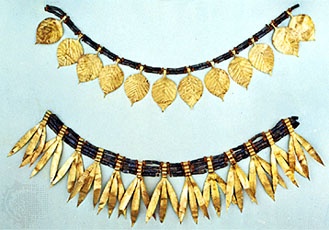 Both sexes seem to have often worn large wigs, as in ancient Egypt. Metalworking was of a high standard, as may be seen in the elaborate golden jewelry, which was encrusted with semiprecious stones and worn by both sexes. Brooches (brooch), earrings (earring), hair ornaments, and neck chains have all been found.
Both sexes seem to have often worn large wigs, as in ancient Egypt. Metalworking was of a high standard, as may be seen in the elaborate golden jewelry, which was encrusted with semiprecious stones and worn by both sexes. Brooches (brooch), earrings (earring), hair ornaments, and neck chains have all been found.A different style of dress is evident in Mesopotamian sculptures dating after about 2370 BCE. Both men and women were clothed in a large piece of material—most commonly of wool, though later also of linen—draped around the body over a skirt. This garment, similar to a shawl, was characteristically edged with tassels or fringe. The draping varied, but, for men at least, the fabric was arranged so that the fullness was at the rear, leaving the right, or sword, arm free. This newer form of dress had originated from farther north and east and was adopted by the Semitic people of Akkad under Sargon (the dynasty founded by Sargon lasted from c. 2334 to c. 2193 BCE) and by the revitalized Sumerian culture in the years 2110–2010 BCE.
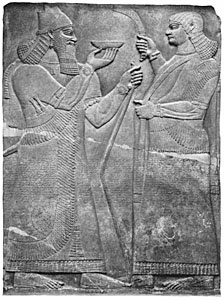 The dress worn in Mesopotamia by the Babylonians (Babylonia) (2105–1240 BCE) and the Assyrians (Assyria) (1200–540 BCE) evolved into a more sophisticated version of Sumerian and Akkadian styles. Ample evidence of this more elaborate draped costume can be seen in the large relief sculptures of the age. There were two basic garments for both sexes: the tunic and the shawl, each cut from one piece of material. The knee- or ankle-length tunic had short sleeves and a round neckline. Over it were draped one or more shawls of differing proportions and sizes but all generally fringed or tasseled. Broad belts held the shawls in position. Wool was the most frequently used material, in bright or strong colours. Decoration was rich, in allover patterns or in borders, carried out in embroidery or by printing. Motifs were chiefly geometric. Women wore a short skirt as underwear, men a loincloth. Footwear for both sexes was made from fabric or soft leather in the form of sandals or boots.
The dress worn in Mesopotamia by the Babylonians (Babylonia) (2105–1240 BCE) and the Assyrians (Assyria) (1200–540 BCE) evolved into a more sophisticated version of Sumerian and Akkadian styles. Ample evidence of this more elaborate draped costume can be seen in the large relief sculptures of the age. There were two basic garments for both sexes: the tunic and the shawl, each cut from one piece of material. The knee- or ankle-length tunic had short sleeves and a round neckline. Over it were draped one or more shawls of differing proportions and sizes but all generally fringed or tasseled. Broad belts held the shawls in position. Wool was the most frequently used material, in bright or strong colours. Decoration was rich, in allover patterns or in borders, carried out in embroidery or by printing. Motifs were chiefly geometric. Women wore a short skirt as underwear, men a loincloth. Footwear for both sexes was made from fabric or soft leather in the form of sandals or boots. Care of the coiffure was very important for men and women among both the Assyrians and the Babylonians. The hair was grown long and carefully curled and ringleted, with false hair added if needed. Perfumes (perfume), oils, and black dye were used on the hair. Men grew long, carefully tended curled beards. A band of metal or fabric encircled the brow, or a woolen, felt, or leather cap shaped like a fez was worn. The royal headdress resembled a pleated crown or a mitre and had dependent lappets at the rear. Jeweled ornamentation to the costume was rich and heavy and of high quality.
Care of the coiffure was very important for men and women among both the Assyrians and the Babylonians. The hair was grown long and carefully curled and ringleted, with false hair added if needed. Perfumes (perfume), oils, and black dye were used on the hair. Men grew long, carefully tended curled beards. A band of metal or fabric encircled the brow, or a woolen, felt, or leather cap shaped like a fez was worn. The royal headdress resembled a pleated crown or a mitre and had dependent lappets at the rear. Jeweled ornamentation to the costume was rich and heavy and of high quality.The Aegean (Aegean civilizations): Minoan (Minoan civilization) and Mycenaean dress
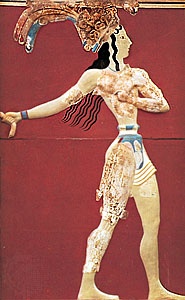 The Aegean region—and in particular the island of Crete, which was inhabited from about 6000 BCE—can be considered the cradle of western European culture. Settlers came to Crete from areas farther east, including Anatolia, North Africa, Syria, and Palestine. By 2500 BCE the Cretan civilization was becoming established. As a maritime people with extensive trade in the Mediterranean and the Middle East, the Cretans were influenced by many sources. They created a society and a dress style of their own, one dissimilar from the earlier styles of Egypt and the later styles of Greece.
The Aegean region—and in particular the island of Crete, which was inhabited from about 6000 BCE—can be considered the cradle of western European culture. Settlers came to Crete from areas farther east, including Anatolia, North Africa, Syria, and Palestine. By 2500 BCE the Cretan civilization was becoming established. As a maritime people with extensive trade in the Mediterranean and the Middle East, the Cretans were influenced by many sources. They created a society and a dress style of their own, one dissimilar from the earlier styles of Egypt and the later styles of Greece.The greatest and most prosperous years were from 1750 to 1400 BCE; this was the time of the building of the great palaces, notably the complex at Knossos, from where the remains of coloured frescoes (fresco painting), painted vases, and sculpture in marble, terra-cotta, and coloured ceramics have been excavated. Even finer and more complete frescoes have been preserved from the excavations of the Minoan (Minoan civilization) city on the island of Thera (Thíra), an island largely destroyed in the cataclysmic volcanic eruption of about 1500 BCE.
Cretan dress is characterized by its vivid colouring, elegance, and sophistication. It is also notable for the gaiety of feminine attire, typical of a society where women—unlike in Classical Greece—are depicted side-by-side with men, apparently taking part in all the activities of life and not relegated to the domestic background. Men's garments were few. Chief of these was a loincloth of wool, leather, or linen, tightly belted at the waist and arranged as a short, elaborately decorated skirt. The belt was drawn tight to accentuate the slender waist. By 1750 BCE women were wearing a long bell-shaped skirt, often in a series of flounces, over a loincloth; with this, they wore a bolero-like jacket that had elbow-length sleeves but was open in front, leaving the breasts bare. In the later period a bodice was worn, constricting the upper torso but accentuating the full, bare breasts above. Such clothing may have been associated with priestesses or goddesses rather than ordinary women, however.
The Cretans liked bright colours, and their dress was vividly embroidered and decorated. The hair of both sexes was worn long, looped and braided and dressed with jewels, pearls (pearl), and ribbons. The Cretans bathed frequently, oiling their bodies afterward. Men were generally clean-shaven. Outdoors both sexes wore sandals or shoes (shoe). In winter calf-length boots were adopted, and short woolen, fur-lined cloaks were fastened by pins around the shoulders.
With the collapse of the Minoan civilization in Crete about 1400 BCE, a new culture arose on the mainland in the Peloponnese, notably in the maritime principalities of Mycenae, Tiryns, and Pylos. As the frescoes from the palace of Tiryns illustrate, the costume was similar but richer still.
Ancient Greece (ancient Greek civilization)
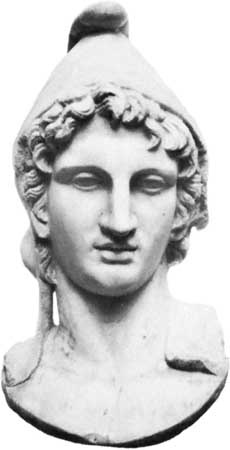 ancient Greek civilization is customarily classified into three segments. Up to about 500 BCE is described as the Archaic period. This was the time when the several different civilizations of mainland and island Greece, Anatolia, and North Africa coexisted, the arts and costume of each influencing the others. The Dorians (Dorian) had invaded the Minoan kingdoms in Crete and the Peloponnese from about 1200 BCE. They were a northern race from Illyria and a less technologically developed society than the Minoans. Modern knowledge of their dress is imperfect, but it seems to have been simple. Woolen cloth, made from the flocks of local sheep, was employed. It was cut into squares of fabric and then pinned on the shoulders and bound around the body. The influence from Anatolia, where the inland climate was more severe, introduced hooded cloaks, banded leg coverings, and Phrygian caps (Phrygian cap) with a point on top.
ancient Greek civilization is customarily classified into three segments. Up to about 500 BCE is described as the Archaic period. This was the time when the several different civilizations of mainland and island Greece, Anatolia, and North Africa coexisted, the arts and costume of each influencing the others. The Dorians (Dorian) had invaded the Minoan kingdoms in Crete and the Peloponnese from about 1200 BCE. They were a northern race from Illyria and a less technologically developed society than the Minoans. Modern knowledge of their dress is imperfect, but it seems to have been simple. Woolen cloth, made from the flocks of local sheep, was employed. It was cut into squares of fabric and then pinned on the shoulders and bound around the body. The influence from Anatolia, where the inland climate was more severe, introduced hooded cloaks, banded leg coverings, and Phrygian caps (Phrygian cap) with a point on top.A later Archaic culture, the Ionian, then established itself in Greece. The Ionians developed a higher-quality textile industry, producing finer materials in wool and linen that were more suited to a draped style of dress. In the 8th and 7th centuries BCE the Ionians developed an extensive trading economy around the Mediterranean region from Gaul in the west to Libya in the east.
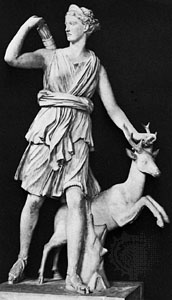 The 5th and 4th centuries BCE were the years of the great Classical period, the time when a very simple but highly sophisticated and superb quality of work was achieved. Greek literature, architecture (Western architecture), and sculpture (Western sculpture) were particularly fine. This was the case with costume as well, the designs of which can be studied in detail from painted vases (Greek pottery) and sculpture. Classical Greek dress was a draped style, one in which there was little sewing. The garments for men and women were similar, consisting of oblong pieces of fabric in different sizes and materials, draped in various ways and held in place by ribbons and decorative pins. The dress was a totally natural one; there was no constriction and no padding. The simplicity of the dress was offset by the myriad ways of wearing it, a sophistication achieved by personal expression of the wearer.
The 5th and 4th centuries BCE were the years of the great Classical period, the time when a very simple but highly sophisticated and superb quality of work was achieved. Greek literature, architecture (Western architecture), and sculpture (Western sculpture) were particularly fine. This was the case with costume as well, the designs of which can be studied in detail from painted vases (Greek pottery) and sculpture. Classical Greek dress was a draped style, one in which there was little sewing. The garments for men and women were similar, consisting of oblong pieces of fabric in different sizes and materials, draped in various ways and held in place by ribbons and decorative pins. The dress was a totally natural one; there was no constriction and no padding. The simplicity of the dress was offset by the myriad ways of wearing it, a sophistication achieved by personal expression of the wearer.As time passed and finer materials (mostly linen) were produced, a further variety in draping was created by pleating, a treatment particularly in use for feminine wear. The pieces of material were set into pleats, soaked in a thin starch solution, twisted and tied at the ends, then left in the sun to dry. This gave a greater permanence to the pleating.
The subject of colour in Greek dress is a difficult one. Neither sculpture nor vases (which are in black, red, and white) provide information. For a long time it was believed that the dress was largely white, and the reintroduction of the “Greek” style in Regency England and Directoire France presumed this from the marble sculpture. It is known, however, that buildings and ornament were painted in bright colours, and literary sources report colour being employed. Decoration was most often by the Classical ornament forms seen in architecture: the fret (key) pattern, flowers such as honeysuckle in running anthemion patterns, circles (paterae), and stripes.
The Hellenistic Age of Greek culture, dating from 323 BCE and lasting until Greece became part of the Roman Empire in 30 BCE, was a wealthier time, reflecting the wider boundaries of the Greek world resulting from the conquests of Alexander the Great. To the fine linens available in costume were added cotton from India and silk from China; thus the draped mode became more varied and elaborate.

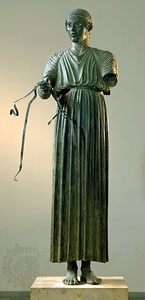 From Classical times the chief garment was the chiton, a type of tunic made from one or two pieces of material hanging back and front, pinned on one or both shoulders, and girded. For men the chiton was usually knee-length and seamed up one or both sides. An ankle-length version was worn by women and for more formal wear by men. The simplest type of chiton was sleeveless, but later a sleeved version was made possible by using a much wider piece of material pinned at intervals at shoulder level, creating an elbow-length wide sleeve. A variation on the chiton style for both sexes was achieved by wearing a double girdle, one at waist level and one around the hips, the material being bloused out in between. The peplos was an additional garment worn by women. Made of one or two pieces of fabric, it hung from the shoulder pins to above or below the waist girdle. Alternatively, women used a longer piece of the chiton material and folded it over in front to hang in a similar manner.
From Classical times the chief garment was the chiton, a type of tunic made from one or two pieces of material hanging back and front, pinned on one or both shoulders, and girded. For men the chiton was usually knee-length and seamed up one or both sides. An ankle-length version was worn by women and for more formal wear by men. The simplest type of chiton was sleeveless, but later a sleeved version was made possible by using a much wider piece of material pinned at intervals at shoulder level, creating an elbow-length wide sleeve. A variation on the chiton style for both sexes was achieved by wearing a double girdle, one at waist level and one around the hips, the material being bloused out in between. The peplos was an additional garment worn by women. Made of one or two pieces of fabric, it hung from the shoulder pins to above or below the waist girdle. Alternatively, women used a longer piece of the chiton material and folded it over in front to hang in a similar manner. There were two chief forms of cloak or wrap. The smaller one—the chlamys—was of dark wool and was worn pinned on one shoulder, usually leaving the right arm free. The larger wrap was the himation, worn by both sexes. Draped in many different ways, it covered the body and could be drawn up over the head. In sculpture, philosophers and statesmen are commonly depicted wearing the himation.
There were two chief forms of cloak or wrap. The smaller one—the chlamys—was of dark wool and was worn pinned on one shoulder, usually leaving the right arm free. The larger wrap was the himation, worn by both sexes. Draped in many different ways, it covered the body and could be drawn up over the head. In sculpture, philosophers and statesmen are commonly depicted wearing the himation.Knowledge of underwear is limited. Literary sources tell of a linen girdle and a band to delineate the breasts. Men wore a loincloth.
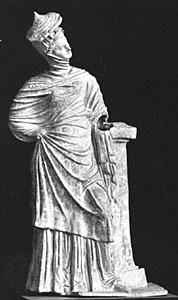 Men's hair was long in the early years, but later it was cut short and carefully curled. bleach was often used to make the hair fashionably blond; perfumes and pomades were applied. Beards were common until the time of Alexander. Most men were bareheaded, a hat being reserved for bad weather. There was a low-crowned, broad-brimmed style—the petasos—and a brimless cap, the pilos. Women's hair was long; it was usually curled and waved on the forehead and sides and drawn to a chignon at the nape. Many women wore wigs of different shades and decorated their coiffure with flowers, jewels, and fillets. They draped the head with the cloak and, in the Hellenistic period, sometimes perched a straw hat on top.
Men's hair was long in the early years, but later it was cut short and carefully curled. bleach was often used to make the hair fashionably blond; perfumes and pomades were applied. Beards were common until the time of Alexander. Most men were bareheaded, a hat being reserved for bad weather. There was a low-crowned, broad-brimmed style—the petasos—and a brimless cap, the pilos. Women's hair was long; it was usually curled and waved on the forehead and sides and drawn to a chignon at the nape. Many women wore wigs of different shades and decorated their coiffure with flowers, jewels, and fillets. They draped the head with the cloak and, in the Hellenistic period, sometimes perched a straw hat on top.Both sexes went barefoot indoors but outside wore leather sandals. Men also wore boots, which were laced up the front and might be fur-lined.
Greek jewelry was very fine and was, especially in the later centuries, worn in abundance. Both sexes used perfume, and women employed extensive makeup to give brilliance to their eyes, lashes, and cheeks.
Etruria
 Cultural development came later to Italy than to the Aegean area. The Greeks colonized southern Italy and Sicily from the later 7th century BCE, but it was the Etruscans (Etruscan) who introduced a high standard of civilization, in the previous century, to the central region of the peninsula. They called themselves the Rasenna, though in Latin they were known as the Etrusci or Tusci. It is believed that they may have emigrated from Anatolia or possibly from farther east. They quickly developed their culture in their new land, and, soon after 700 BCE, they were living in an urban society capable of a high standard of building and visual arts. In dress, as in the other applied arts, they drew their inspiration and knowledge from a mixture of sources, chiefly Greek and Middle Eastern.
Cultural development came later to Italy than to the Aegean area. The Greeks colonized southern Italy and Sicily from the later 7th century BCE, but it was the Etruscans (Etruscan) who introduced a high standard of civilization, in the previous century, to the central region of the peninsula. They called themselves the Rasenna, though in Latin they were known as the Etrusci or Tusci. It is believed that they may have emigrated from Anatolia or possibly from farther east. They quickly developed their culture in their new land, and, soon after 700 BCE, they were living in an urban society capable of a high standard of building and visual arts. In dress, as in the other applied arts, they drew their inspiration and knowledge from a mixture of sources, chiefly Greek and Middle Eastern.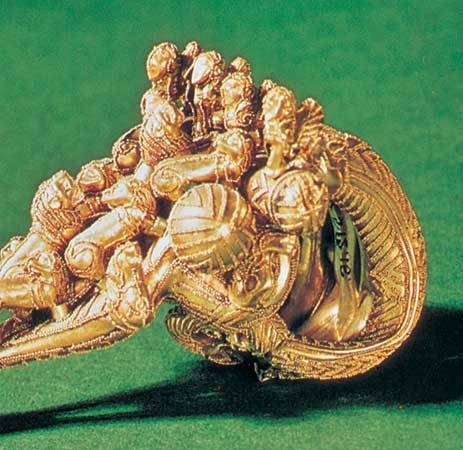 The Etruscans also had a close affinity of dress with the Minoans, with sewn and fitted garments, bright colouring, rich decoration, and an abundance of beautiful jewelry, especially in gold. Nevertheless, Etruscan dress, for both sexes, demonstrates a marriage between East and West, blending Eastern features from Egypt, Syria, and Crete with a later Ionian-style draped attire probably derived from the contemporary Greek colonists in southern Italy. Thus, Etruscans can be seen wearing both draped, pinned tunics and fitted, sewn ones, or such Greek styles as the chlamys, himation, or chiton in conjunction with footwear with Middle Eastern-style turned-up toes. Some Etruscan garments presaged later styles; for example, the tebenna, a semicircular mantle, was an early version of the Roman toga, and a decorative collar derived from Egypt anticipated a later Byzantine version.
The Etruscans also had a close affinity of dress with the Minoans, with sewn and fitted garments, bright colouring, rich decoration, and an abundance of beautiful jewelry, especially in gold. Nevertheless, Etruscan dress, for both sexes, demonstrates a marriage between East and West, blending Eastern features from Egypt, Syria, and Crete with a later Ionian-style draped attire probably derived from the contemporary Greek colonists in southern Italy. Thus, Etruscans can be seen wearing both draped, pinned tunics and fitted, sewn ones, or such Greek styles as the chlamys, himation, or chiton in conjunction with footwear with Middle Eastern-style turned-up toes. Some Etruscan garments presaged later styles; for example, the tebenna, a semicircular mantle, was an early version of the Roman toga, and a decorative collar derived from Egypt anticipated a later Byzantine version.Ancient Rome
The civilization of ancient Rome spanned more than a thousand years, from the traditional founding of the walled city in the mid-8th century BCE to the final collapse of the western part of the empire in 476 CE. Until the 3rd century BCE the Romans derived their culture from the Greeks and the Etruscans but after this gradually began to develop their own civilization and to expand their influence, taking over territory after territory—first that of the Etruscans, then Sicily, Carthage and North Africa, Greece, and Egypt. They went on to found the great Roman Empire, which by the 2nd century CE extended from Spain to the Black Sea and from Britain to Egypt.
The history of Roman dress is paralleled by that of Roman arts and architecture (Western architecture). They inherited many ideas from the Greeks, but, as the empire extended its borders and incorporated peoples of different customs, climates, and religions, matters of style became more complex. In costume, as in art, the trend was toward a more ornate, richly coloured, more varied, and, especially in the later days of the empire, very luxurious attire. Roman dress also reflected a distinct division of social class, with certain colours, fabrics, and styles reserved for citizens and important personages.
With the expansion of the empire, wider trading (international trade) was made possible. This increased the availability of more varied and elegant fabrics. Cotton from India and silks from East Asia were accessible to the wealthy, enriched by high-quality embroidered edging and fringing. Elagabalus (218–222 CE) was the first Roman emperor to wear silk. Later, looms (loom) were set up to weave silk, but China retained control of sericulture, exporting only silk thread or fabric, both of which were expensive.
The art of dyeing and knowledge of the use of mordants was now more extensive. The famous dye of the Classical world was Tyrian purple, so called because its centre of production was in the twin cities of Tyre and Sidon (now in Lebanon). The dye was obtained from small glands in the mollusk purpura and was costly owing to the small size of the source material. Thus, the wearing of Tyrian purple was reserved for a few; although the name Purpura gave rise to the word purple, the colour would be described today as something between red and purple. Under the empire, production sites were established in Crete, Sicily, and Anatolia. At Taranto in southern Italy a hill survives that is composed entirely of the shells of the Purpura mollusk.
 The garment for which Rome is most famous is the toga. A large piece of material wrapped around the masculine body as a cloak, the toga served a similar function as the Greek himation, although the fabric was of quite a different shape. Under the empire, the toga acquired a special distinction because of its unique and complex method of draping and because, as a note of rank, its wearing was restricted to Roman citizens. The toga was not rectangular in shape like the himation but was a segment of a circle, measuring about 18 feet (5.5 metres) along the chord of the segment and about 5.5 feet (1.7 metres) at its widest point. It was made of wool and so was very heavy. To drape it, about five feet of the straight edge of the fabric was placed against the centre front of the body from ground level upward. The rest of the material was then thrown over the left shoulder and passed around the back, under the right arm, and once again over the left shoulder and arm. The right arm was therefore left free. The material could be pouched in front as well as drawn up over the head. Certain patterns and colours were worn by specific members of society.
The garment for which Rome is most famous is the toga. A large piece of material wrapped around the masculine body as a cloak, the toga served a similar function as the Greek himation, although the fabric was of quite a different shape. Under the empire, the toga acquired a special distinction because of its unique and complex method of draping and because, as a note of rank, its wearing was restricted to Roman citizens. The toga was not rectangular in shape like the himation but was a segment of a circle, measuring about 18 feet (5.5 metres) along the chord of the segment and about 5.5 feet (1.7 metres) at its widest point. It was made of wool and so was very heavy. To drape it, about five feet of the straight edge of the fabric was placed against the centre front of the body from ground level upward. The rest of the material was then thrown over the left shoulder and passed around the back, under the right arm, and once again over the left shoulder and arm. The right arm was therefore left free. The material could be pouched in front as well as drawn up over the head. Certain patterns and colours were worn by specific members of society.The basic masculine garment was like the chiton; it was called a tunica (tunic). Colours differentiated the social classes—white for the upper classes, natural or brown for others. Longer tunicas were worn for important occasions. About 190 CE the dalmatic was introduced from Dalmatia. This was a looser, ungirded style of tunic with wide sleeves.
 Feminine dress was very like the Greek, with the Roman woman's version of the chiton called a stola. As time passed, women took to wearing several garments one on top of the other, while the garments themselves were made of finer fabrics and were more lavishly decorated. The feminine cloak, the palla, resembled the Greek himation.
Feminine dress was very like the Greek, with the Roman woman's version of the chiton called a stola. As time passed, women took to wearing several garments one on top of the other, while the garments themselves were made of finer fabrics and were more lavishly decorated. The feminine cloak, the palla, resembled the Greek himation.Underwear for both sexes consisted of a loincloth—like briefs—and women also wore a breastband—the mamillare. Footwear was based upon the Greek but was more varied. Apart from sandals, several styles of shoe and boot existed.
Face powder, rouge, eye shadow, and eyeliner were lavishly applied by upper-class women, who also attached beauty patches to their faces. Wigs and hair switches were commonly worn, and certain colours of hair were fashionable; for example, during the Gallic and Teutonic campaigns, blonde wigs made from the hair of captured slaves were in vogue.
Ancient nonclassical Europe
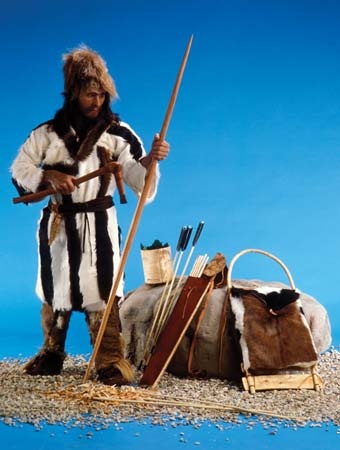 Animal furs (fur) and hides (hide) made up the chief garments during the European Stone Age. They would be held to the body by a thong belt and by pins at the shoulder. Later such skins were pierced with awls and sewn together with cordage to give a closer fit. Finds from tombs and living sites dating to the Upper Paleolithic Period (c. 38,000–c. 8,000 BCE) indicate that people had a fair knowledge of dressing skins, weaving, and sewing. No garments have survived the oldest part of the Upper Paleolithic, but archaeologists have recovered artifacts such as boxwood and bone combs, delicate bone needles, reindeer horn buttons and plaques, and decorative items such as necklaces and armlets of beads, amber, and ivory. Discoveries from more recent eras, such as that of the Iceman, (Iceman) or Ötzi (c. 3300 BCE), have provided more information.
Animal furs (fur) and hides (hide) made up the chief garments during the European Stone Age. They would be held to the body by a thong belt and by pins at the shoulder. Later such skins were pierced with awls and sewn together with cordage to give a closer fit. Finds from tombs and living sites dating to the Upper Paleolithic Period (c. 38,000–c. 8,000 BCE) indicate that people had a fair knowledge of dressing skins, weaving, and sewing. No garments have survived the oldest part of the Upper Paleolithic, but archaeologists have recovered artifacts such as boxwood and bone combs, delicate bone needles, reindeer horn buttons and plaques, and decorative items such as necklaces and armlets of beads, amber, and ivory. Discoveries from more recent eras, such as that of the Iceman, (Iceman) or Ötzi (c. 3300 BCE), have provided more information.The advent of the Bronze Age varies in time and expression from one part of Europe to another. The art of bronze working came to Italy from the Middle East and then spread westward to Britain and Scandinavia. During the years 1500–600 BCE the arts of spinning and weaving were further developed; simple natural dyes were used; and decoration was by embroidery, fringing, and plaiting.
In Denmark, the northern Netherlands, and Germany the practice of burying people in peat bogs has preserved a number of actual, almost complete, Bronze Age garments. Most of the garments are woolen or leather items that were maintained in remarkable condition in oak log coffins. They include large semicircular cloaks, felt caps, tunics with leather straps and belts, and, for women, jackets and skirts with ornamental belts and hair ornaments. Many of these are on display in the National Museum in Copenhagen and the Schleswig-Holstein Museum of Prehistory and Early History in Germany.
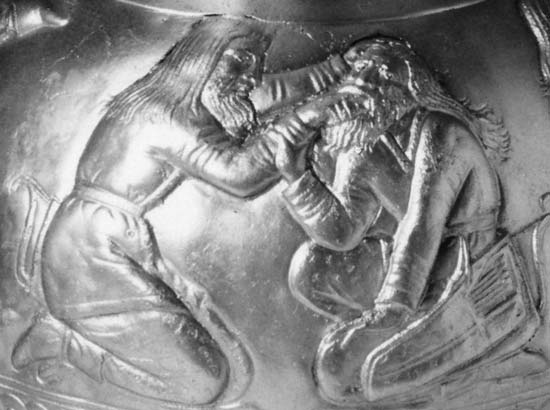 A different type of dress was worn by the nomadic peoples who lived on the Steppe (Steppe, the), a grassy plain that stretches from Hungary to Manchuria. Such groups, which included the Scythians (Scythian), Cimmerians (Cimmerian), and Sarmatians (Sarmatian), traveled immense distances on horseback. Their attire being suited to their way of life, both sexes wore similar garments consisting of a woolen tunic over a shirt and wide trousers. These garments were worn in layers one on top of another; they were fairly close-fitting but loose enough for comfort and for the practical needs of hours spent on horseback. Short boots were pulled up over the trouser bottoms and tied in place. These peoples also wore leather belts around their waists, and felted woolen caps kept their heads warm. Around 600 BCE the Scythians lived in the region around the Black Sea and then gradually moved westward to Romania, Hungary, and Germany. Excavation of their burial sites in the Dnieper valley and near Simferopol, both in Ukraine, and in the Balkans has yielded both actual garments and a wealth of relief sculpture, vases, and plaques that illustrate Scythian dress.
A different type of dress was worn by the nomadic peoples who lived on the Steppe (Steppe, the), a grassy plain that stretches from Hungary to Manchuria. Such groups, which included the Scythians (Scythian), Cimmerians (Cimmerian), and Sarmatians (Sarmatian), traveled immense distances on horseback. Their attire being suited to their way of life, both sexes wore similar garments consisting of a woolen tunic over a shirt and wide trousers. These garments were worn in layers one on top of another; they were fairly close-fitting but loose enough for comfort and for the practical needs of hours spent on horseback. Short boots were pulled up over the trouser bottoms and tied in place. These peoples also wore leather belts around their waists, and felted woolen caps kept their heads warm. Around 600 BCE the Scythians lived in the region around the Black Sea and then gradually moved westward to Romania, Hungary, and Germany. Excavation of their burial sites in the Dnieper valley and near Simferopol, both in Ukraine, and in the Balkans has yielded both actual garments and a wealth of relief sculpture, vases, and plaques that illustrate Scythian dress.The 6th-century-BCE Hallstatt culture of the Bavarian and Bohemian areas had an advanced lifestyle for its time. Finds from this early phase of the Iron Age, however, are chiefly weapons (weapon) and jewelry. In the 4th century BCE the Celts (Celt) from central Europe, or at least some of their styles and methods of manufacture, moved into Italy and thence on to Britain, Ireland, and Spain. Finds of the Celtic culture, which consist largely of jewelry, toilet articles, and ornaments, illustrate both the high Celtic standard of craftsmanship, especially in metal, and the individual character of their design. Museums in many countries—notably Italy, Spain, Portugal, Ireland, and Britain—display a wealth of such work.
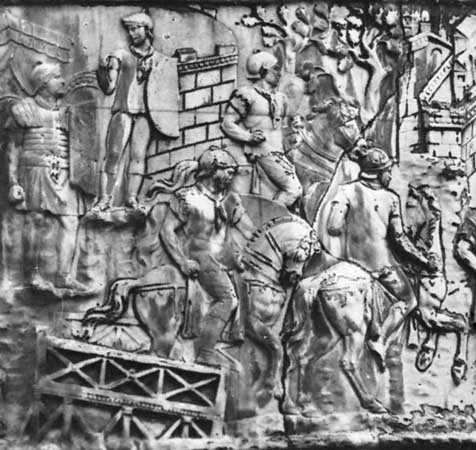 Roman influence on the dress of the northern and western countries of the empire was strong until the early 5th century CE. This was to a certain extent, however, a two-way influence since, in the colder northern areas, the Romans found the indigenous dress styles of belted tunics (tunic) with trousers or leg-banding more suitable than their own Classical tunica and bare legs. Useful evidence of local attire in Britain, Gaul, and Germany is graphically illustrated on Trajan's Column and that of Marcus Aurelius, both in Rome. This evidence is reinforced by the written accounts of Roman historians such as Cornelius Tacitus (Tacitus) of the 1st century CE and Sidonius Apollinaris of the later years.
Roman influence on the dress of the northern and western countries of the empire was strong until the early 5th century CE. This was to a certain extent, however, a two-way influence since, in the colder northern areas, the Romans found the indigenous dress styles of belted tunics (tunic) with trousers or leg-banding more suitable than their own Classical tunica and bare legs. Useful evidence of local attire in Britain, Gaul, and Germany is graphically illustrated on Trajan's Column and that of Marcus Aurelius, both in Rome. This evidence is reinforced by the written accounts of Roman historians such as Cornelius Tacitus (Tacitus) of the 1st century CE and Sidonius Apollinaris of the later years.The pre-Columbian (pre-Columbian civilizations) Americas
At the time of their first encounter with European explorers, the American Indian population was composed of societies of many levels of social and economic complexity. Cultural groups extended from the Eskimo (Inuit and Yupik/Yupiit) of the Arctic circle to the Maya, Aztec, and Inca of Central and South America. With such immense climatic variation, the Americas were home to a wide variety of dress.
Native Americans (American Indian)
 Cloth was rarely made in the region north of the Rio Grande, although many cultures there made finely woven baskets. The California Indians (California Indian) and the Northwest Coast Indians (Northwest Coast Indian) also wove capes and hats from plant fibres.
Cloth was rarely made in the region north of the Rio Grande, although many cultures there made finely woven baskets. The California Indians (California Indian) and the Northwest Coast Indians (Northwest Coast Indian) also wove capes and hats from plant fibres.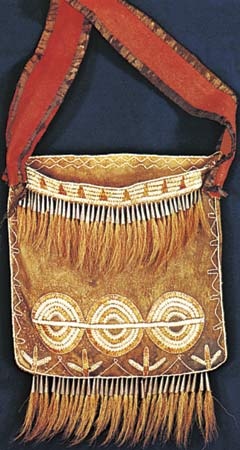 Most people wore clothing made from the tanned (tanning) or chamois skins of local animals, such as deer, elk, buffalo, moose, beaver, otter, wolf, fox, and squirrel. Native Americans (Native American) employed animal oils, particularly those found in the brains of the animal, to produce a softly textured material that they then dyed in brilliant colours. They often made use of the entire skin, adapting the garment to the shape of the animal and wearing it draped and sewn only minimally; the legs, paws, and tail were left attached and hung down as decoration. Two skins were often used for a woman's dress or man's tunic, one back and one front. Like other groups with little to no metalworking, Native Americans pierced the edges of skins with bone or stone awls and then threaded the edges together with animal sinew or fibre cordage. Decoration was by porcupine-quill embroidery (quillwork), the quills being softened by chewing or simmering and then dyed. Garments were also decorated by fringed edging.
Most people wore clothing made from the tanned (tanning) or chamois skins of local animals, such as deer, elk, buffalo, moose, beaver, otter, wolf, fox, and squirrel. Native Americans (Native American) employed animal oils, particularly those found in the brains of the animal, to produce a softly textured material that they then dyed in brilliant colours. They often made use of the entire skin, adapting the garment to the shape of the animal and wearing it draped and sewn only minimally; the legs, paws, and tail were left attached and hung down as decoration. Two skins were often used for a woman's dress or man's tunic, one back and one front. Like other groups with little to no metalworking, Native Americans pierced the edges of skins with bone or stone awls and then threaded the edges together with animal sinew or fibre cordage. Decoration was by porcupine-quill embroidery (quillwork), the quills being softened by chewing or simmering and then dyed. Garments were also decorated by fringed edging.Depending upon local conditions, men might wear a breechclout and women a short skirt. In warm, dry climates shirts were often optional, while in wetter regions a cloak or poncho might be added. In cooler areas men typically wore a loose hip-length tunic and thigh-length leggings, the latter tied to the waistband of the breechclout. Women typically wore a long dress and short leggings.
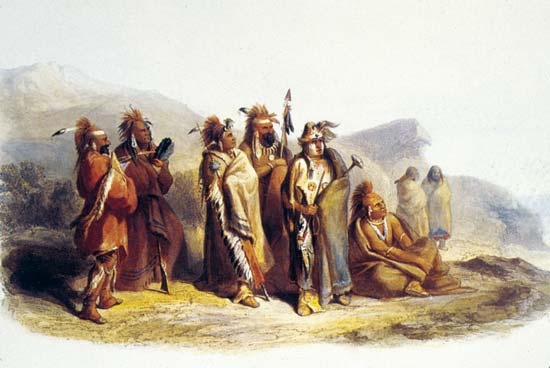 Hair was carefully tended by both sexes. For the men there were many, varied styles; in some areas hair was grown long and plaited, in others it was worn loose. Some styles were dramatic, consisting of, for example, a ridge of hair sticking up along the crown of the head, extending from the forehead back, with the remainder of the head shaved. (This style was revived in punk coiffures of more modern times when it was called the Mohawk or Mohican.) Animal hair and feathers (feather) were added to many hairstyles. An important form of regalia was a feathered headdress, which sometimes included buffalo horns, ermine tails, and quillwork. Women's hair was generally worn long, either loose, plaited, or held in place by a headband.
Hair was carefully tended by both sexes. For the men there were many, varied styles; in some areas hair was grown long and plaited, in others it was worn loose. Some styles were dramatic, consisting of, for example, a ridge of hair sticking up along the crown of the head, extending from the forehead back, with the remainder of the head shaved. (This style was revived in punk coiffures of more modern times when it was called the Mohawk or Mohican.) Animal hair and feathers (feather) were added to many hairstyles. An important form of regalia was a feathered headdress, which sometimes included buffalo horns, ermine tails, and quillwork. Women's hair was generally worn long, either loose, plaited, or held in place by a headband.The moccasin was the traditional shoe. It was made from one or two pieces of soft leather, which enclosed the foot, with no added heel. It was seamed to an inset decorative piece on top of the instep. The leather was then folded over at the back.
Facial and body hair was often plucked out with tweezers, and both face and hair were painted. Red pigment was frequently used to paint the body. Both sexes tattooed (tattoo) their bodies, sometimes all over, and some continue this tradition today; bright red and black were the colours most often used for this.
The Eskimo
 The clothing of the Eskimo (Inuit and Yupik/Yupiit) and Aleut was adapted to the Arctic cold and had much in common with that worn in the Siberian Arctic. This clothing was made from animal skins, but because of the climate it was sewn and tailored to the body to keep out the wind. The fur or pelt of the animal was retained, and garments were often worn fur side in. Thread was of animal sinew, awls for piercing the skin were generally stone, and needles were of bone or ivory. The Eskimo used all available animal skins: polar bear, deer, caribou reindeer, antelope, dog, and fox. They also used birds—the skin for clothing and the feathers as decoration. Sealskin was ideal for boots, which were made with the fur turned inward. Seal gut was used to make waterproof outer garments for those who ventured onto the sea.
The clothing of the Eskimo (Inuit and Yupik/Yupiit) and Aleut was adapted to the Arctic cold and had much in common with that worn in the Siberian Arctic. This clothing was made from animal skins, but because of the climate it was sewn and tailored to the body to keep out the wind. The fur or pelt of the animal was retained, and garments were often worn fur side in. Thread was of animal sinew, awls for piercing the skin were generally stone, and needles were of bone or ivory. The Eskimo used all available animal skins: polar bear, deer, caribou reindeer, antelope, dog, and fox. They also used birds—the skin for clothing and the feathers as decoration. Sealskin was ideal for boots, which were made with the fur turned inward. Seal gut was used to make waterproof outer garments for those who ventured onto the sea.Both sexes wore the same type of garments: a hooded tunic or coat, trousers, and boots. The hooded tunic was variously named in different areas. Two of these—the parka of the Aleutian Islands and the anorak of Greenland—have become essential items of modern dress.
The Aztec, the Maya, and the Inca
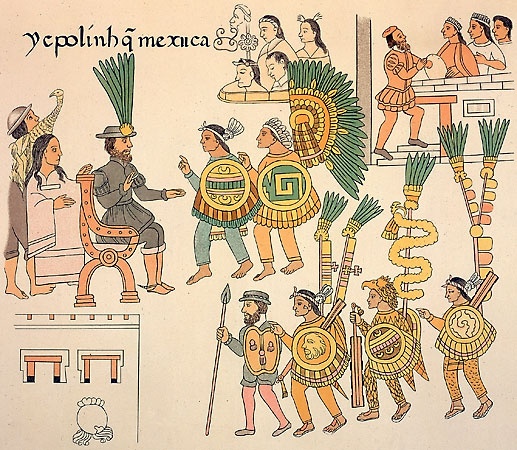 In Central (Central America) and South America (South American Indian) lived the Aztec, the Maya, and the Inca. The Aztec settled in Mexico about the 12th century. Their capital city, Tenochtitlán, which they established in the 14th century, was on the present-day site of Mexico City. The men wore loincloths, the women tunics and skirts, all made from woven cotton fabric. Ornamental cloaks were worn as garments of rank. The decoration of Aztec costume was chiefly by exotic plumes, but fur also was used. The Aztec elite wore a great deal of jewelry, mainly of gold.
In Central (Central America) and South America (South American Indian) lived the Aztec, the Maya, and the Inca. The Aztec settled in Mexico about the 12th century. Their capital city, Tenochtitlán, which they established in the 14th century, was on the present-day site of Mexico City. The men wore loincloths, the women tunics and skirts, all made from woven cotton fabric. Ornamental cloaks were worn as garments of rank. The decoration of Aztec costume was chiefly by exotic plumes, but fur also was used. The Aztec elite wore a great deal of jewelry, mainly of gold. The Maya came to Guatemala about 800 BCE and spread into the Yucatán Peninsula. Their culture flourished chiefly between 250 and 900 CE. They also wore few garments: a loincloth for men and a cloak when needed; a loose sleeveless dress or blouse and skirt for women. Cotton and sisal were cultivated; women were responsible for spinning and weaving these fibres. The Maya also developed a method of tie-dyeing the yarn and of weaving patterns using bright colours for dyes. Embroidery also was practiced.
The Maya came to Guatemala about 800 BCE and spread into the Yucatán Peninsula. Their culture flourished chiefly between 250 and 900 CE. They also wore few garments: a loincloth for men and a cloak when needed; a loose sleeveless dress or blouse and skirt for women. Cotton and sisal were cultivated; women were responsible for spinning and weaving these fibres. The Maya also developed a method of tie-dyeing the yarn and of weaving patterns using bright colours for dyes. Embroidery also was practiced.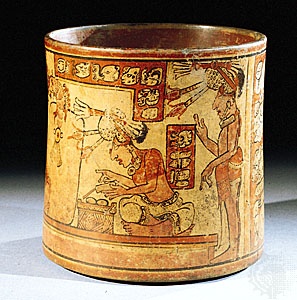 Cotton fabrics were mainly reserved for upper-class wear, as were beautifully decorated leather belts and sandals. For the ordinary people, tapa—a cloth derived from tree bark, as in Polynesia—was made. An important part of Mayan decoration was provided by feathers from birds of brilliant plumage, which were skillfully incorporated into the weaving processes. The feathers were also widely used in the ornamentation of headdresses. The long, iridescent tail feathers of the quetzal, a member of the trogon family of birds, were especially prized, as they were in Aztec dress.
Cotton fabrics were mainly reserved for upper-class wear, as were beautifully decorated leather belts and sandals. For the ordinary people, tapa—a cloth derived from tree bark, as in Polynesia—was made. An important part of Mayan decoration was provided by feathers from birds of brilliant plumage, which were skillfully incorporated into the weaving processes. The feathers were also widely used in the ornamentation of headdresses. The long, iridescent tail feathers of the quetzal, a member of the trogon family of birds, were especially prized, as they were in Aztec dress.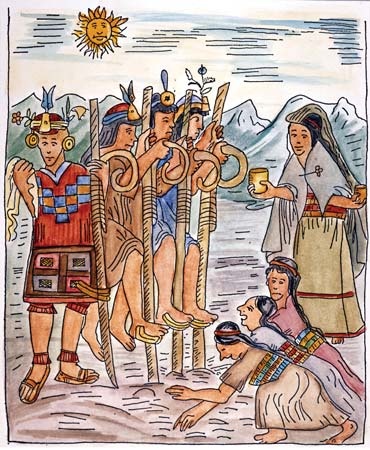 The Inca came from the valley of Cuzco in the high mountains of Peru. During the 15th century they established a powerful empire of several million people in what are now Peru, Bolivia, and Ecuador, and extending into parts of Argentina and Chile. Their attire was brightly coloured and decorated by feathers—indeed some of their fine cloaks were made entirely of feathers woven into a cotton fabric base. They kept herds of llamas (llama) for wool and hunted other animals, such as the chinchilla, for their fur. Nonetheless, Inca garments were simple in construction: a basic loincloth for both sexes and, over this, a short tunic for men and an ankle-length dress for women. The poncho was the most usual cloak. People went barefoot or wore sandals. They also frequently went bareheaded or, in bad weather, adopted a woolen cap or turban.
The Inca came from the valley of Cuzco in the high mountains of Peru. During the 15th century they established a powerful empire of several million people in what are now Peru, Bolivia, and Ecuador, and extending into parts of Argentina and Chile. Their attire was brightly coloured and decorated by feathers—indeed some of their fine cloaks were made entirely of feathers woven into a cotton fabric base. They kept herds of llamas (llama) for wool and hunted other animals, such as the chinchilla, for their fur. Nonetheless, Inca garments were simple in construction: a basic loincloth for both sexes and, over this, a short tunic for men and an ankle-length dress for women. The poncho was the most usual cloak. People went barefoot or wore sandals. They also frequently went bareheaded or, in bad weather, adopted a woolen cap or turban.The Middle East (Middle East, ancient) from the 6th century
The style of costume worn throughout the Middle East has been remarkably constant for centuries. This is partly because it has evolved as one suited to the climate, serving as a protection against heat, dust, and blazing sunshine. The wearing of traditional clothing has also been accepted and supported by many Muslim (Islām) countries.
The traditional garments of the Middle East are loose-fitting and cover or even envelop much of the body. The names of these garments vary from country to country, but the similarity between them is clear. Likewise the materials from which they were, and still are, made vary according to what is available. In general, linen, cotton, and wool are the norm, but the well-to-do have always worn garments made from rich fabrics with a silk base. Several of the most famous of these materials originated in this area, including baldachin, the richly decorated fabric with a warp of gold thread and a weft of silk, named after the city of Baghdad, and damask, named after Damascus (in Syria), the source of this richly patterned silk fabric.
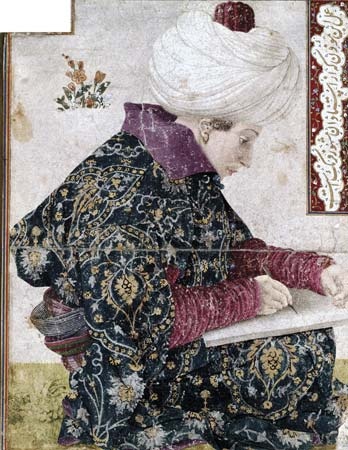 A number of the traditional garments were originally derived from ancient cultures in the region, particularly from Persia (Iran) and farther east in India, Mongolia, and Asian (Asia) Russia. The caftan is one such example. It is an open, coatlike garment, termed in ancient Persia a candys or kandys. Also worn extensively in the cooler climates of Mongolia and China, the style extended westward to become, eventually, the fashionable dolman of the late Ottoman Empire.
A number of the traditional garments were originally derived from ancient cultures in the region, particularly from Persia (Iran) and farther east in India, Mongolia, and Asian (Asia) Russia. The caftan is one such example. It is an open, coatlike garment, termed in ancient Persia a candys or kandys. Also worn extensively in the cooler climates of Mongolia and China, the style extended westward to become, eventually, the fashionable dolman of the late Ottoman Empire.The spread of the characteristic costume of the Middle East was due in large part to the spread of Arab peoples and cultures. The people of the Arabian Desert were by the 6th century CE leading a stable, rural life in the border areas of Yemen, Syria, and Iraq; in the interior region they were largely Bedouin nomads raising camel herds for a living. By 750 CE the Arab empire extended from Spain and Morocco in the west to the Caspian Sea and the Indus River in the east. The chief garments worn at that time were a loose shirt, chemise, or robe; a draped cloak; wide, baggy trousers; and a head cloth or turban. Similar versions of these may still be seen on the streets of Cairo, Istanbul, or Damascus.
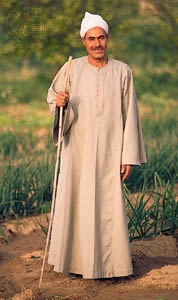 The simple basic garment for both sexes was a loose, long shirt, chemise, or tunic, which often had long sleeves. Over this men wore a robe or mantle of various types. The aba (ʿabāʾ or abaya) was of ancient origin and is mentioned in the Bible as the attire of Hebrew prophets. It was traditionally made of heavy cream-coloured wool decorated with brightly coloured stripes or embroidery. A voluminous outer gown still worn throughout the Middle East in the Arab world is the jellaba, known as the jellabah in Tunisia, a jubbeh in Syria, a gallibiya in Egypt, or a dishdasha in Algeria. The garment generally has wide, long sleeves, and the long skirt may be slit up the sides; some styles are open in front like a coat or caftan.
The simple basic garment for both sexes was a loose, long shirt, chemise, or tunic, which often had long sleeves. Over this men wore a robe or mantle of various types. The aba (ʿabāʾ or abaya) was of ancient origin and is mentioned in the Bible as the attire of Hebrew prophets. It was traditionally made of heavy cream-coloured wool decorated with brightly coloured stripes or embroidery. A voluminous outer gown still worn throughout the Middle East in the Arab world is the jellaba, known as the jellabah in Tunisia, a jubbeh in Syria, a gallibiya in Egypt, or a dishdasha in Algeria. The garment generally has wide, long sleeves, and the long skirt may be slit up the sides; some styles are open in front like a coat or caftan.Outer gowns or cloaks sometimes incorporated head coverings. These included the haik, which was an oblong piece of material (generally striped) that the Arabs used to wrap around their bodies and heads for day or night wear; the material measured about 18 feet by 6 feet (5.5 by 1.8 metres). A similar mantle was the burnous, a hooded garment also used for warmth day or night.
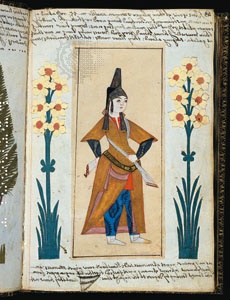 The loose, baggy trousers traditional to the Middle East, as well as to the Balkans and Anatolia, are still widely worn by both sexes. The garment is believed to have originated in Persia, and it is presumed that the Arabs saw it there when they invaded that country in the 7th century. The trousers, called chalvar, chalwar, or ṣalvar according to the country where they were worn, measured about 3 yards (2.75 metres) across at the waist and were drawn tight by cords. The full, leg portion was tied at each ankle. A broad sash then encircled the waist, on top of the chalvar. Worn in this way the garment was ideal for working in the fields because it allowed freedom of movement and protected the lumbar region of the spine, especially while bending, from chills. For centuries the garment has also been adopted by men in the fighting forces. Cotton is the usual material for working attire, but fashionable ladies wear a chalvar made from a brocade or silk fabric over linen drawers.
The loose, baggy trousers traditional to the Middle East, as well as to the Balkans and Anatolia, are still widely worn by both sexes. The garment is believed to have originated in Persia, and it is presumed that the Arabs saw it there when they invaded that country in the 7th century. The trousers, called chalvar, chalwar, or ṣalvar according to the country where they were worn, measured about 3 yards (2.75 metres) across at the waist and were drawn tight by cords. The full, leg portion was tied at each ankle. A broad sash then encircled the waist, on top of the chalvar. Worn in this way the garment was ideal for working in the fields because it allowed freedom of movement and protected the lumbar region of the spine, especially while bending, from chills. For centuries the garment has also been adopted by men in the fighting forces. Cotton is the usual material for working attire, but fashionable ladies wear a chalvar made from a brocade or silk fabric over linen drawers.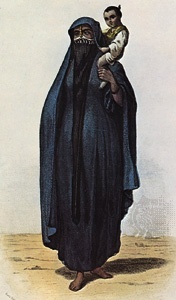 The tradition for women to cover themselves from head to toe and veil (purdah) their faces when they go out in public is an old one, predating Islam in Persia, Syria, and Anatolia. The Qurʾān provides instructions giving guidance on this matter but not a strict ruling. However, some modern regimes have insisted on the strict veiling of women in public. The enveloping cloaks worn by women for this purpose are similar to one another and often incorporate a mesh panel through which women may peer at the world outside. The most common names for this garment are burka, chador, chādar, chadri, çarşaf, and tcharchaf.
The tradition for women to cover themselves from head to toe and veil (purdah) their faces when they go out in public is an old one, predating Islam in Persia, Syria, and Anatolia. The Qurʾān provides instructions giving guidance on this matter but not a strict ruling. However, some modern regimes have insisted on the strict veiling of women in public. The enveloping cloaks worn by women for this purpose are similar to one another and often incorporate a mesh panel through which women may peer at the world outside. The most common names for this garment are burka, chador, chādar, chadri, çarşaf, and tcharchaf. The characteristic masculine Arab headdress has been the kaffiyeh. It is still worn today, although it may now accompany a business suit. Basically, the kaffiyeh is a square of cotton, linen, wool, or silk, either plain or patterned, that is folded into a triangle and placed upon the head so that one point falls on to each shoulder and the third down the back. It is held in place on the head by the agal (igal, egal), a corded band decorated with beads or metallic threads.
The characteristic masculine Arab headdress has been the kaffiyeh. It is still worn today, although it may now accompany a business suit. Basically, the kaffiyeh is a square of cotton, linen, wool, or silk, either plain or patterned, that is folded into a triangle and placed upon the head so that one point falls on to each shoulder and the third down the back. It is held in place on the head by the agal (igal, egal), a corded band decorated with beads or metallic threads.Footwear was in the form of sandals, shoes, or boots, with the toes slightly turned up. Women traditionally wore decorative wooden pattens called kub-kobs to walk about in muddy unpaved streets.
The Byzantine Empire
In 324 CE the Roman emperor Constantine I decided to rebuild the great city at Byzantium, then a Greek centre. The city was sited strategically on the Bosporus, whose narrow waters connecting the Mediterranean and the Black Sea acted as a gateway between West and East. Constantine called his city New Rome; it was later renamed Constantinople (now Istanbul) in his honour. After the collapse of the western part of the Roman Empire, which was based in Rome (and later Ravenna), Constantinople became the capital city of the Christian-dominated Byzantine Empire, the extent of which fluctuated considerably until its collapse in 1453.
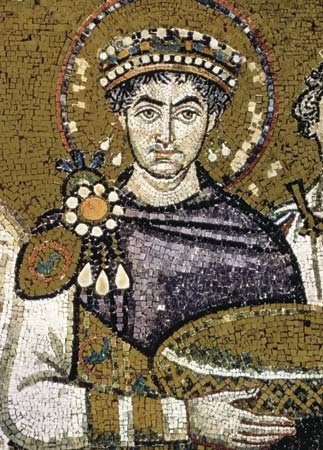 Owing to the site of its capital city, the empire was subject to a complex of influences that were nowhere more marked than in the dress of its ruling classes. Over the centuries there were two notable periods of wealth and prosperity that were reflected in costume. The first period was in the time of the emperor Justinian I, who reigned from 527 to 565 CE. Until this time the influence of Rome was still strong, and dress styles tended to be draped in the fashion of the later years of the empire. There were differences, however, derived in part from Persian and Anatolian designs, such as the use of sewn, closer-fitting garments and richer ornamentation and jewelry. In addition, because of its success as a trade centre between East and West, the Byzantine Empire had become extremely wealthy. This wealth led to a costume of magnificent splendour that became the envy of the known world. Luxury fabrics from Asia, Syria, and Egypt became available in quantity and were utilized, despite the high cost, by the leading members of society.
Owing to the site of its capital city, the empire was subject to a complex of influences that were nowhere more marked than in the dress of its ruling classes. Over the centuries there were two notable periods of wealth and prosperity that were reflected in costume. The first period was in the time of the emperor Justinian I, who reigned from 527 to 565 CE. Until this time the influence of Rome was still strong, and dress styles tended to be draped in the fashion of the later years of the empire. There were differences, however, derived in part from Persian and Anatolian designs, such as the use of sewn, closer-fitting garments and richer ornamentation and jewelry. In addition, because of its success as a trade centre between East and West, the Byzantine Empire had become extremely wealthy. This wealth led to a costume of magnificent splendour that became the envy of the known world. Luxury fabrics from Asia, Syria, and Egypt became available in quantity and were utilized, despite the high cost, by the leading members of society.The domestic textile industry was also stimulated. Its development was greatly aided by the introduction of sericulture into Constantinople. The Chinese had guarded secrets of the manufacture of silk for hundreds of years, but by about 1000 BCE silkworm culture and silk manufacture had been established in northern India, and the knowledge later percolated through to Korea, Japan, Persia, and Central Asia. Justinian had tried early in his reign to divert the silk trade (international trade) from its route from Persia but without success. He was presented with a tremendous opportunity when two Persian monks, who had worked as missionaries in China and had studied the process of sericulture and the weaving of the filaments, agreed to smuggle this knowledge, as well as the necessary silkworm (silkworm moth) eggs, to Constantinople in exchange for a large monetary reward. Silkworms flourished in Constantinople, and the authorities there, like the Chinese and others before them, guarded the secrets of the process and controlled their monopoly in Europe until, inevitably, in the early Middle Ages, the knowledge and means were once more disseminated, this time to Anatolia and Sicily and from there gradually to Italy and France.
 During Justinian's reign, Byzantine textile manufacturers produced beautiful, glamorous fabrics, mainly of silk interwoven with gold and silver metallic threads and interspersed with pearls and jeweled embroideries. The use of these heavy lustrous fabrics gradually altered the style of dress; the stiff, ornate materials lent themselves to a simpler cut with only a few folds to break up the often allover, large-motif designs. For both men and women a more fitted, sewn tunic, cinched at the waist by a richly decorated wide belt and hanging straight to knee or ankle, replaced the Roman draped tunica (tunic). A rich, deep decorative collar, like the preceding Egyptian and Etruscan versions, covered the shoulders. The influence of the Christian church could be seen in the fact that the limbs were generally covered by long, usually fitted sleeves and cloth or silken hose. Cloaks, pinned at the shoulder, were worn outdoors. Imperial dress was characterized by the extensive use of purple and gold. Garments for the wealthy were vividly coloured in reds, yellows, and greens. Such attire is depicted in the 6th-century mosaics and the Ravenna churches of San Vitale and Sant'Apollinare Nuovo, which include portraits of Justinian and his wife, Theodora.
During Justinian's reign, Byzantine textile manufacturers produced beautiful, glamorous fabrics, mainly of silk interwoven with gold and silver metallic threads and interspersed with pearls and jeweled embroideries. The use of these heavy lustrous fabrics gradually altered the style of dress; the stiff, ornate materials lent themselves to a simpler cut with only a few folds to break up the often allover, large-motif designs. For both men and women a more fitted, sewn tunic, cinched at the waist by a richly decorated wide belt and hanging straight to knee or ankle, replaced the Roman draped tunica (tunic). A rich, deep decorative collar, like the preceding Egyptian and Etruscan versions, covered the shoulders. The influence of the Christian church could be seen in the fact that the limbs were generally covered by long, usually fitted sleeves and cloth or silken hose. Cloaks, pinned at the shoulder, were worn outdoors. Imperial dress was characterized by the extensive use of purple and gold. Garments for the wealthy were vividly coloured in reds, yellows, and greens. Such attire is depicted in the 6th-century mosaics and the Ravenna churches of San Vitale and Sant'Apollinare Nuovo, which include portraits of Justinian and his wife, Theodora.The second period of expansion and prosperity came between the 9th and 11th centuries. Court dress became richer than ever, encrusted with jeweled embroideries and dyed in deep colours, especially purples and reds. Imperial dress included a long panel of gold-embroidered material, which was wrapped around the body with the end hung over one arm. The classical line had completely given place to an Eastern form of dress. For example, the caftan had been adopted as formal wear. Open down the centre front, this coatlike garment was shaped to fit at the back. For both sexes the caftan was accompanied by trousers, not full like the Middle Eastern chalvar but more elegantly and closely cut, especially on the lower limbs where they were tucked into boot tops or worn over shoes.
Byzantine dress strongly influenced that of eastern Europe, especially the Balkans and Russia. Some of the bejeweled silk formal garments were gradually adopted by the church to become vestments in the Middle Ages.
Men tended to prefer leather boots in footwear, black for normal use and red at court. Women sometimes wore sandals but more often were found in soft, ankle-height shoes, brightly coloured and embroidered.
Masculine hairstyles were short, and men were mostly clean-shaven. Outdoors they adopted the Phrygian cap or a hood. Women wore veils and often encased their long hair in a silk cap or a pearl net. Elaborate jewelry was characteristic of all Byzantine dress of the upper classes. Perfume was liberally applied but cosmetics less so.
Medieval (Middle Ages) Europe
 The dress of Europeans during the years from the collapse of the western part of the Roman Empire in the 5th century CE to about 1340 was slow to change and was largely standardized over a wide area. Clothes for men and women were similar, being sewn albeit crudely and loosely cut. A shirt or chemise and braies—that is, a roughly fitting kind of drawers—constituted underwear. These were of a natural coloured linen. The shirt was hip-length for men, longer for women. It had a round neck, slit in front for ease of donning, and was tied with a drawstring; the braies were similarly fastened at the waist. On top of this was worn one or more tunics—knee- or ankle-length for men and ground-length for women. The tunic had a round neckline and long sleeves cut in one with the garment; it was loose fitting but girded at the waist. Tunics were made from coloured linen or wool and were decorated with embroidered bands at the neck, wrists, and hem. Legs were covered with ill-fitting hose, which were cut from cloth in two vertical sections and sewn together. They were held up by banding or garters.
The dress of Europeans during the years from the collapse of the western part of the Roman Empire in the 5th century CE to about 1340 was slow to change and was largely standardized over a wide area. Clothes for men and women were similar, being sewn albeit crudely and loosely cut. A shirt or chemise and braies—that is, a roughly fitting kind of drawers—constituted underwear. These were of a natural coloured linen. The shirt was hip-length for men, longer for women. It had a round neck, slit in front for ease of donning, and was tied with a drawstring; the braies were similarly fastened at the waist. On top of this was worn one or more tunics—knee- or ankle-length for men and ground-length for women. The tunic had a round neckline and long sleeves cut in one with the garment; it was loose fitting but girded at the waist. Tunics were made from coloured linen or wool and were decorated with embroidered bands at the neck, wrists, and hem. Legs were covered with ill-fitting hose, which were cut from cloth in two vertical sections and sewn together. They were held up by banding or garters.Thirteenth-century dress was noted for its plainness. There was little or no decoration, and garments were unbelted. A sleeveless surcoat was generally worn over the tunic. This had derived in the late 12th century from the tabard, a garment worn by crusading knights (knight) over their armour to prevent the sun from reflecting off the metal and making them visible to an enemy. The surcoat, which was worn by both men and women, often had slits (called fitchets) on each hip so that the waist belt underneath with purse attached could be reached without fear of thieves.
Men's hair might be long or short; some men were clean-shaven, while others had beards. Women wore their hair long, parted in the centre, and plaited and then pinned up at the sides; they then pinned a white linen neckcloth to the plaits on each side (the wimple), concealing the hair, and on top of this wore a veil, a white linen crown, or a pillbox cap. Such headdresses were known by a variety of names, including barbette, fillet, and touret.
 Toward 1350 a great change occurred in costume. Clothes increasingly were tailored to fit and display the human figure. The ability to tailor garments improved. More and better fabrics were now reaching the West from Italy and farther east. But perhaps the most important reason for sartorial change was the spread of the Renaissance movement from Italy. A movement both spiritual and secular, the Renaissance was dedicated to reviving Classical concepts and to celebrating the dignity and importance of human beings. This was expressed in costume by the beautification and display of the human figure.
Toward 1350 a great change occurred in costume. Clothes increasingly were tailored to fit and display the human figure. The ability to tailor garments improved. More and better fabrics were now reaching the West from Italy and farther east. But perhaps the most important reason for sartorial change was the spread of the Renaissance movement from Italy. A movement both spiritual and secular, the Renaissance was dedicated to reviving Classical concepts and to celebrating the dignity and importance of human beings. This was expressed in costume by the beautification and display of the human figure.During the remainder of the medieval period, men wore close-fitting, modish clothes, such as the fitted tunic, which was cut into four sections that were seamed at the centre back and at the sides and fastened with buttons centre front. By 1340–45 this tunic was hip-length with a heavy leather belt decorated with metal and jeweled brooches encircling the hips only a few inches above the hem. Sleeves were elbow-length. The undertunic, of similar cut, had long sleeves, buttoned to fit closely from elbow to wrist.
The hose (hosiery) were now fitted more closely also. These stockings were cut from velvet, silk, or woolen cloth in four sections and extended from the foot to the upper thigh, where they were attached by points (laces with metal tag ends) to the lower edge of the undertunic. By 1370–80 the hose grew longer to become tights and were laced by points all around the body to the by-then waist-length undertunic. As outer tunics also became increasingly short in the early 15th century, a codpiece became necessary. This was a bag covering the front opening between the two legs and was attached by points to the hose. (The name derives from the medieval term cod, meaning bag.)
Women's dresses also changed form. The neckline was lowered and was cut straight across at shoulder level. The bodice, which extended to the hips, was fitted like the men's tunic, and a similar heavy belt encircled the hips. Below the hips the skirt was gored, very full, and long. Sleeves resembled men's styles. Another gown, called a sideless surcoat, was often worn on top. This had no sleeves but had a very large armhole to display the gown beneath; the armholes and a front panel (known as the plastron) were often trimmed with fur.
There were several new forms of decoration at this time. One was parti-colouring, in which all garments, including hose, could be of one colour down one side and a different hue on the other, the dividing line thus delineating the form of the figure. Counterchange designs—heraldic, floral, or geometric in motif—were introduced where the ground colour and design colour were interchanged. Edges of garments were cut into various shapes; these were called dagges (Middle English: dags).
During the 15th century these trends developed further. Men's hose became still better-fitting. Tunics were shorter, often only waist-length. Fabrics were richer and beautifully patterned. For older men, for whom displaying the figure was less suitable, a long gown was introduced to wear over the tunic. At first (in the 14th century) it was full and long like a dressing gown (the houppelande), but it gradually became more tailored and formal, with vertical pleats in back and front. All garments, for both sexes, were fur-edged and, often, fur-lined—for both warmth and appearance.
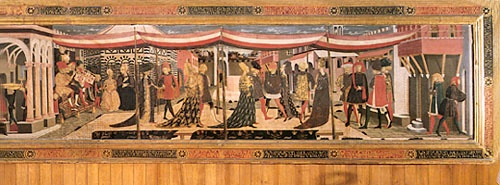 By the 15th century, styles, accessories, decoration, and fabrics were beginning to vary from area to area. The fashion-setter in the years 1430–75 was Burgundy, a duchy that controlled Flanders and much of modern France. It was the wealthiest region in Europe, and the fabrics it manufactured—velvets, silks, gold and silver materials, and embroideries—were of the highest quality. After Burgundy's defeat in 1477 at Nancy, Italy became the fashion centre of Europe. Italian fabrics were equally beautiful to those from Burgundy but were less heavy and with less fur. Colours were gay and bright, and the emphasis for both sexes was on an elegant, natural human form with a gracious ease of movement.
By the 15th century, styles, accessories, decoration, and fabrics were beginning to vary from area to area. The fashion-setter in the years 1430–75 was Burgundy, a duchy that controlled Flanders and much of modern France. It was the wealthiest region in Europe, and the fabrics it manufactured—velvets, silks, gold and silver materials, and embroideries—were of the highest quality. After Burgundy's defeat in 1477 at Nancy, Italy became the fashion centre of Europe. Italian fabrics were equally beautiful to those from Burgundy but were less heavy and with less fur. Colours were gay and bright, and the emphasis for both sexes was on an elegant, natural human form with a gracious ease of movement.Men's hairstyles varied greatly during this long period. In general, they were short until the later 15th century, and men were mostly clean-shaven. The main head covering was the hood with an attached shoulder cape and a long extended point, or tail, known as a liripipe. By the 1420s a new way of wearing this hood was tried. The face portion was placed on the head, then the cape was arranged in folds like a cockscomb and tied into place with the liripipe, the end of which trailed over the shoulder (a style immortalized in jester's attire). This was an inconvenient arrangement and so a padded roll evolved—the roundlet—with the separate shoulder cape sewn in place to one side and the liripipe to the other. Toward the end of the century, various styles of tall or broad-brimmed hats, decorated by coloured plumes, replaced the hood.
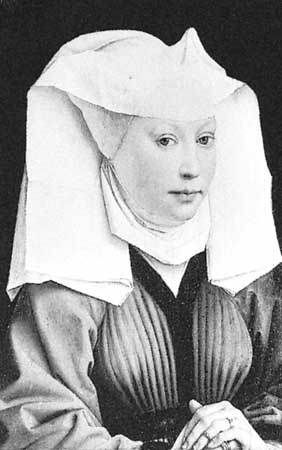 Women's headdresses were extremely varied. Hair was still long, plaited, and coiled over the ears. These coils might be enclosed in metal mesh jeweled nets called cauls and were worn with a veil. In the 15th century turbans—a Byzantine style that had been introduced in Italy—were fashionable. Wimples had also gained popularity, as did steeple headdresses resembling dunce caps and shorter fezlike caps. All were made of rich fabrics and accompanied by veils, either in a soft flowing mode or formed into winglike shapes by wire framework underneath.
Women's headdresses were extremely varied. Hair was still long, plaited, and coiled over the ears. These coils might be enclosed in metal mesh jeweled nets called cauls and were worn with a veil. In the 15th century turbans—a Byzantine style that had been introduced in Italy—were fashionable. Wimples had also gained popularity, as did steeple headdresses resembling dunce caps and shorter fezlike caps. All were made of rich fabrics and accompanied by veils, either in a soft flowing mode or formed into winglike shapes by wire framework underneath.Footwear was similar for both men and women. Hose might be soled for indoor wear. Outdoors shoes could be worn with wood and cork pattens strapped on to keep the elegant fabrics out of the mud of the streets. Men wore boots for traveling. Long toes were fashionable in the late 14th century, the ends being padded to keep the shape.
Europe, 1500–1800
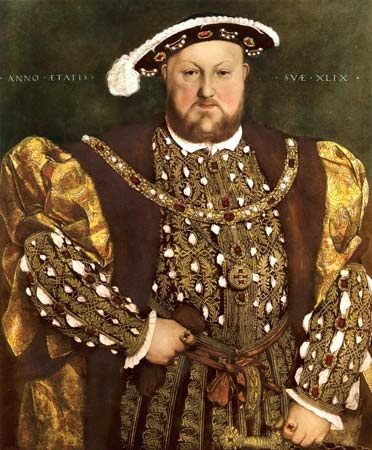 The 16th century witnessed further changes occurring in Europe. The limitations bounding medieval society were gradually being breached, and the concepts of the Renaissance were being accepted farther west, in France, Flanders, England, and Spain. People expected a higher standard of living, and there was an expanding middle class. Europe was also looking outward. From Portugal, Spain, and Italy especially, sailors were voyaging to explore both east and west. Their journeys brought the acquisition of riches, new materials, and precious metals. Costume, as always, reflected all this.
The 16th century witnessed further changes occurring in Europe. The limitations bounding medieval society were gradually being breached, and the concepts of the Renaissance were being accepted farther west, in France, Flanders, England, and Spain. People expected a higher standard of living, and there was an expanding middle class. Europe was also looking outward. From Portugal, Spain, and Italy especially, sailors were voyaging to explore both east and west. Their journeys brought the acquisition of riches, new materials, and precious metals. Costume, as always, reflected all this.The chief centres of wealth were the pacesetters in fashion. Until about 1510 the style was generated from Italy. After this the Germans and Flemish set the pattern, but from about mid-century it was Spain that dominated the scene. Styles of the first two decades were a development and expansion of the Italian modes of the late 15th century. Young men wore white silk shirts, frilled and embroidered at the neck and wrists. Over this they wore an abbreviated tunic and close-fitting hose, which were often striped to delineate the masculine limbs. Older men covered the tunic and hose with a long gown, open down the centre front, the edges turned back to display the contrasting lining. Men's hairstyles were long and flowing. Their hats, which were set at a jaunty angle, were made of black velvet and decorated with brooches and plumes. Ladies' gowns had square necklines and were cut low enough to reveal the frilled chemise worn underneath. Sleeves were wide and full, and skirts were held or pinned up to display the undergown. From about 1520 to 1545 the fashionable shape was governed by the addition of padded puffs, decoratively slashed. This idea is thought to have been derived from the dress of Swiss and Bavarian mercenaries. Each garment was slashed to show the contrasting colour of the material of the one beneath.
 Whereas the humanist concept of the Renaissance had led to figure display and elegance, the new modes were influenced by the Reformation of northern Europe, giving rise to darker colours, heavier materials, and bulky garments padded to conceal the figure. The masculine tunic—now called a doublet—had a knee-length, gored skirt that was open in front to display the now padded protruberant codpiece. Over this was worn a rich velvet gown with fur collar and padded sleeves. Shoes and boots had broad toes and, like all other garments, were decoratively slashed. Short hair styles, small beards, and flat velvet caps worn at an angle were fashionable.
Whereas the humanist concept of the Renaissance had led to figure display and elegance, the new modes were influenced by the Reformation of northern Europe, giving rise to darker colours, heavier materials, and bulky garments padded to conceal the figure. The masculine tunic—now called a doublet—had a knee-length, gored skirt that was open in front to display the now padded protruberant codpiece. Over this was worn a rich velvet gown with fur collar and padded sleeves. Shoes and boots had broad toes and, like all other garments, were decoratively slashed. Short hair styles, small beards, and flat velvet caps worn at an angle were fashionable. The feminine figure was artificially controlled by a tight underbodice with metal or whalebone strips in the seams to give a small waist and slender torso. This was the precursor of the corset. In contrast, the skirt was shaped into a cone or inverted-V silhouette by being draped over a petticoat made from canvas and inset at intervals with circular hoops (hoop skirt) of wicker. This fashion had originated during the previous century in Spain, and by 1500 it had become high fashion there. The Spanish skirt, called a verdugado, was bell-shaped, however. About 1530 the cone-shaped hoop was introduced into France, where it was popularized by the queen and called a vertugade. The style soon appeared in England, where it was known as a farthingale.
The feminine figure was artificially controlled by a tight underbodice with metal or whalebone strips in the seams to give a small waist and slender torso. This was the precursor of the corset. In contrast, the skirt was shaped into a cone or inverted-V silhouette by being draped over a petticoat made from canvas and inset at intervals with circular hoops (hoop skirt) of wicker. This fashion had originated during the previous century in Spain, and by 1500 it had become high fashion there. The Spanish skirt, called a verdugado, was bell-shaped, however. About 1530 the cone-shaped hoop was introduced into France, where it was popularized by the queen and called a vertugade. The style soon appeared in England, where it was known as a farthingale.The fashionable lady's headdress was a hood made of dark velvet, with long flaps or folds hanging down the back and sides. The face was framed in front by a jeweled metal frame shaped like a pyramid (the English hood) or a horseshoe (the French hood). Under this was worn a decorative cap that almost concealed the hair.
The costume worn from mid-century until about 1620 was the richest ever seen in the history of European dress. It was made from beautiful fabrics heavily encrusted with embroidery, pearls, and jewels. Fine lawns and lace were employed, and all garments were extensively patterned. During these years Spain was enjoying the wealth yielded by the New World, and Spanish dress—which was elegant and tasteful, formal and restrictive, and doubtlessly uncomfortable to wear—was paramount. Paradoxically, when other nations adopted Spanish modes they mostly took them to excess, the Spaniards themselves remaining restrained in their dignified black garments.
The masculine doublet was fitted to the waist and buttoned centre front. Its skirt had now been replaced by trunk hose, which were loose mid-thigh-length breeches gathered into a tight waist and thigh bands; decoration was by embroidered strips called panes. Embroidered clocks decorated the now knitted silk stockings. Shoes had returned to the natural foot form. The dashing Spanish cape had replaced the cumbersome gown. These capes displayed great variety in size, shape, and method of wearing.
Women's fashions became more constricted and elaborate as the boned bodice evolved into the first true corset. The farthingale became wider and, by the 1580s, was extended by a padded sausage known as a bum roll or barrel, which was tied around the waist under the skirt. Later the French introduced the wheel farthingale, which was drum-shaped with radiating spokes on top. The gown neckline became very décolleté, almost displaying the breasts. From the 1570s to the 1770s a stomacher—a stiff, V- or U-shaped panel heavily decorated with jewels and embroidery—was often worn over the centre front bodice of the gown.
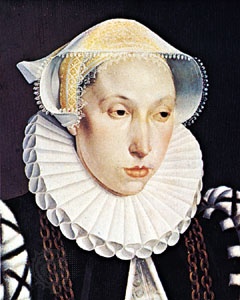 A characteristic feature of dress of this time for both sexes was the ruff collar (ruff), introduced from Spain. Called a band (ruffs laundered and ready to wear were kept in band boxes), it was a strip of material tied around the neck. Another, ruched strip was sewn on to it. After 1565, with the introduction of starch, ruffs became larger and were often edged with embroidery and lace. The very large “cartwheel” ruffs were not worn in Spain, nor was the wheel farthingale. It was in the Netherlands (Netherlands, The), Germany, France, and England that the extremes of these fashions, which lasted until about 1620, were seen.
A characteristic feature of dress of this time for both sexes was the ruff collar (ruff), introduced from Spain. Called a band (ruffs laundered and ready to wear were kept in band boxes), it was a strip of material tied around the neck. Another, ruched strip was sewn on to it. After 1565, with the introduction of starch, ruffs became larger and were often edged with embroidery and lace. The very large “cartwheel” ruffs were not worn in Spain, nor was the wheel farthingale. It was in the Netherlands (Netherlands, The), Germany, France, and England that the extremes of these fashions, which lasted until about 1620, were seen.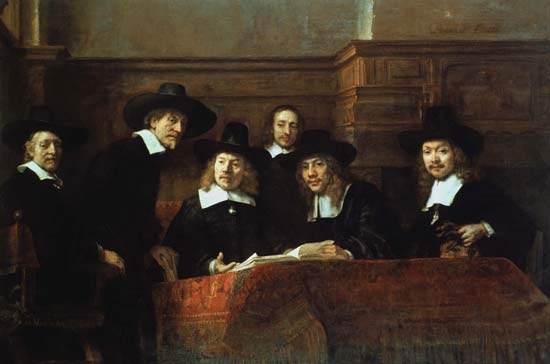 By the 1620s the Netherlands was emerging from Spanish control and extending its trade dramatically to become wealthy and influential. The garments worn by the well-to-do were still made from beautiful fabrics, but these now included fine wools as well as velvets and silks. The material that above all was characteristic of these years was lace, seen especially in the falling bands—large collars covering the shoulders, which had replaced the 16th-century ruffs—and their elegant matching cuffs.
By the 1620s the Netherlands was emerging from Spanish control and extending its trade dramatically to become wealthy and influential. The garments worn by the well-to-do were still made from beautiful fabrics, but these now included fine wools as well as velvets and silks. The material that above all was characteristic of these years was lace, seen especially in the falling bands—large collars covering the shoulders, which had replaced the 16th-century ruffs—and their elegant matching cuffs.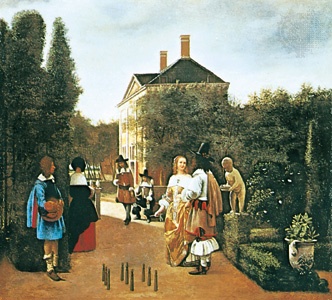 The years between 1630 and perhaps 1680 (depending on location) have been aptly dubbed by some costume historians as the time of “long locks, lace, and leather.” Men grew their hair long and wore it, beautifully cared for, falling naturally onto the shoulders and down the back. Complementary to this coiffure was a large beaver, felt, or velvet hat, dramatically ornamented by coloured ostrich plumes. The leather refers to the fact that the fashionable footwear was a boot rather than a shoe. These boots were made of soft leather; they had heels with platform soles and immense bucket tops, over the edge of which frothed lace-edged boot hose. The doublet had become an elegant hip-length jacket, and the trunk hose were replaced by knee-length breeches tied with a ribbon sash at the knee. Women's dresses had a full skirt that fell naturally from a raised waistline; the shoulders were covered by a band of lace. The hair was dressed high on the crown in a bun decorated with pearl ropes and with ringlets at the sides and brow.
The years between 1630 and perhaps 1680 (depending on location) have been aptly dubbed by some costume historians as the time of “long locks, lace, and leather.” Men grew their hair long and wore it, beautifully cared for, falling naturally onto the shoulders and down the back. Complementary to this coiffure was a large beaver, felt, or velvet hat, dramatically ornamented by coloured ostrich plumes. The leather refers to the fact that the fashionable footwear was a boot rather than a shoe. These boots were made of soft leather; they had heels with platform soles and immense bucket tops, over the edge of which frothed lace-edged boot hose. The doublet had become an elegant hip-length jacket, and the trunk hose were replaced by knee-length breeches tied with a ribbon sash at the knee. Women's dresses had a full skirt that fell naturally from a raised waistline; the shoulders were covered by a band of lace. The hair was dressed high on the crown in a bun decorated with pearl ropes and with ringlets at the sides and brow. The grand règne of Louis XIV of France lasted from 1643 to 1715. In this time the king established France as a great European power, and from about 1660 France became the unchallenged leader of European fashion, a position it held until 1939 and even later. The mode was set in Paris, and new styles were disseminated by mannequin dolls sent out to European capitals and by costume plates drawn by notable artists from Albrecht Dürer (Dürer, Albrecht) to Wenceslaus Hollar (Hollar, Wenceslaus).
The grand règne of Louis XIV of France lasted from 1643 to 1715. In this time the king established France as a great European power, and from about 1660 France became the unchallenged leader of European fashion, a position it held until 1939 and even later. The mode was set in Paris, and new styles were disseminated by mannequin dolls sent out to European capitals and by costume plates drawn by notable artists from Albrecht Dürer (Dürer, Albrecht) to Wenceslaus Hollar (Hollar, Wenceslaus).In men's dress the mid-century years represented a transitional period when ribbon and lace ornamentation dominated the whole attire, which consisted of a white shirt, an open, waist-length jacket, and full breeches that resembled a skirt. These breeches were known as petticoat breeches or rhinegraves.
Between 1665 and 1670 came a quite different masculine style that presaged the three-piece suit of modern times. Initiated in France, this began as a knee-length coat called a justaucorps, an idea deriving from the Persian caftan. It had no collar and was worn open in front. The short sleeves ended in cuffs. By 1680 the sleeves were longer, and under the coat was worn a slightly shorter waistcoat together with close-fitting knee-breeches. At the neck the falling band had been succeeded by an elegant, lace-edged cravat.
Women's styles changed less noticeably at this time. The gown neckline was lowered, and the waistline was also lowered. Skirts were fuller and longer but were draped up on each side and fastened with ribbon bows to display the petticoat underneath.
 In the last decade of the century both sexes wore a high coiffure. In the case of the men it was a wig. The periwig (peruke) or peruke had been fashionable since about 1670. It was made of naturally coloured hair—human where possible—and consisted of a great curtain of curls and ringlets cascading over shoulders and back, while above the brow the curls rose high on either side of the centre parting. With these full-bottomed wigs the hat, now a three-cornered tricorne, was usually carried under the arm. Ladies wore a tall headdress—the fontange—consisting of tiers of wired lace decorated by ribbons and lappets.
In the last decade of the century both sexes wore a high coiffure. In the case of the men it was a wig. The periwig (peruke) or peruke had been fashionable since about 1670. It was made of naturally coloured hair—human where possible—and consisted of a great curtain of curls and ringlets cascading over shoulders and back, while above the brow the curls rose high on either side of the centre parting. With these full-bottomed wigs the hat, now a three-cornered tricorne, was usually carried under the arm. Ladies wore a tall headdress—the fontange—consisting of tiers of wired lace decorated by ribbons and lappets.Until the early 1770s, French control of fashion was complete. It was in France where the trades and professions vital to fashion were established: dressmaking, tailoring, wig making, haberdashery, millinery. Textiles for these crafts were varied and luxurious. They were beautiful but, unlike their 16th-century counterparts, were painted, embroidered, or printed with dainty rather than large-motif designs and were decorated not with jewels but with lace ruffles, ruching, and ribbon bows. Silks, satins, taffetas, and velvets were preferred until the last three decades of the 18th century when—as a consequence of the infamous “triangular trade” of manufactured goods, slaves, and raw cotton carried on by Europeans, Africans, and Americans—fine cottons became readily available.
The Enlightenment caused fundamental changes in society during the 18th century. Men, for hundreds of years the peacocks of fashion, gradually ceded their position; men's garments became less ornamental and changeable while women's dress became the vehicle for fashionable display. As capitalism and ideas of democracy burgeoned, so did the middle classes, which were increasing in numbers and influence. These developments lead to a wave of egalitarianism in dress and a gradual end to the idea that richness and high fashion were the prerogative of the aristocracy.
Thus, during the 18th century men continued to dress elegantly, but changes in their costume style were gradual and limited. The habit à la française, the French term for the suit consisting of coat, waistcoat, and knee breeches, had become accepted wear. There was a trend away from brightly coloured satins and velvets toward darker, more sombre cloth materials. The cut of the habit also became subdued; there was less decoration, and the style fitted the figure more closely. Wigs were worn through the 1780s, in many and varied styles, but became smaller and less elaborate as time passed; powder was used for much of this time. The tricorne hat remained the style of this century.
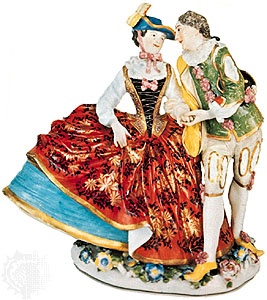 A rigid corset continued to slenderize the waist and a framework petticoat to define the shape of the skirt. In the early decades this was a hoop skirt, circular in section and very full. A popular style of gown worn over this was the sack (sacque), which had been derived from the informal house dress of the early years of the century. In France this style was often called the robe volante. From a low, wide neckline the gown flared out freely over the hoop petticoat. By 1720–25 the fullness was concentrated at the back in two deep box pleats sewn to the neckband, while the gown was waisted at the front. This was the robe à la française.
A rigid corset continued to slenderize the waist and a framework petticoat to define the shape of the skirt. In the early decades this was a hoop skirt, circular in section and very full. A popular style of gown worn over this was the sack (sacque), which had been derived from the informal house dress of the early years of the century. In France this style was often called the robe volante. From a low, wide neckline the gown flared out freely over the hoop petticoat. By 1720–25 the fullness was concentrated at the back in two deep box pleats sewn to the neckband, while the gown was waisted at the front. This was the robe à la française. Toward mid-century the hoop framework gradually changed shape to become oval. Then known as a panier (“basket”), it consisted of a basket form on each hip tied in at the waist by tapes. Soon the frame became so wide that women found it difficult to negotiate a doorway or a sedan chair, so a collapsible folding panier was devised, made only of whalebone hoops connected together by tapes. The years 1750–75 saw the most elaborate and outrageously decorated panier gowns, a riot of ruffles, flounces, and ribbon bows. It was also the time of ridiculously high, overdecorated, and powdered wigs (wig). Cosmetics of all forms, many containing white lead, mercury, and other injurious chemicals, were copiously used, a reintroduction of the 16th-century practice.
Toward mid-century the hoop framework gradually changed shape to become oval. Then known as a panier (“basket”), it consisted of a basket form on each hip tied in at the waist by tapes. Soon the frame became so wide that women found it difficult to negotiate a doorway or a sedan chair, so a collapsible folding panier was devised, made only of whalebone hoops connected together by tapes. The years 1750–75 saw the most elaborate and outrageously decorated panier gowns, a riot of ruffles, flounces, and ribbon bows. It was also the time of ridiculously high, overdecorated, and powdered wigs (wig). Cosmetics of all forms, many containing white lead, mercury, and other injurious chemicals, were copiously used, a reintroduction of the 16th-century practice.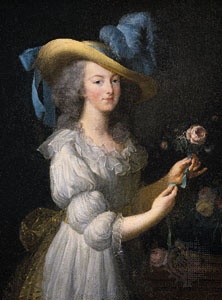 By the 1770s a reaction to this excess was beginning in England, where simpler gowns with a framework petticoat were worn, and the fullness of the skirt was drawn to the back. A sash encircled a high waistline, and a soft fichu, or light scarf, was draped around the neck. These gentler yet elegantly feminine styles gradually spread throughout Europe and were finally accepted in France, although a 1783 portrait of Marie-Antoinette in such a gown angered the public, who claimed that her use of muslin—a fabric not produced in France—undermined the French textile industry.
By the 1770s a reaction to this excess was beginning in England, where simpler gowns with a framework petticoat were worn, and the fullness of the skirt was drawn to the back. A sash encircled a high waistline, and a soft fichu, or light scarf, was draped around the neck. These gentler yet elegantly feminine styles gradually spread throughout Europe and were finally accepted in France, although a 1783 portrait of Marie-Antoinette in such a gown angered the public, who claimed that her use of muslin—a fabric not produced in France—undermined the French textile industry.For centuries children (childhood) had been dressed as miniature adults, but in the 1770s there was a marked divergence from this established custom. Children, especially boys, began to be dressed in more comfortable garments suited to their age. Girls' dresses were rather like the easier styles of their mothers at this time, but boys were dressed in a shirt and ankle-length trousers, the waistband of which was buttoned to the shirt. This costume, in which the wearing of trousers as fashionable dress antedated its introduction for adults by a generation, was oddly entitled a skeleton suit.
Colonial America
North America was colonized by settlers from northern and western Europe. These settlers brought with them habits and ideas in dress that were characteristic of their places of origin, but their clothes were also influenced by the climate of the part of the country to which they had come. For example, the earliest settlers, the Spanish, arrived in Florida in 1565. There, as well as in their later settlements in Texas and California, the climate was not very different from that of Spain, so that the colonists continued to wear Spanish styles. In contrast, colonists farther north in New England experienced harsher winters than they had been accustomed to and so found a greater need than they had in England to wear furs and skins.
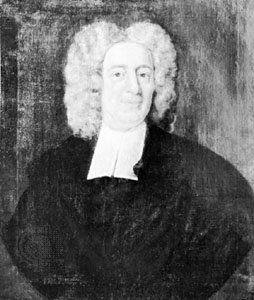 Many colonists thought it important to preserve class distinctions in all areas. Because of this, they passed many sumptuary laws (sumptuary law) that proscribed what members of the different classes could purchase or own; protocol in dress was a visible expression of their determination to maintain their heritage. Similar laws restricting dress were also passed for religious reasons, reflecting some of the areas of conflict that led to the English Civil Wars (1642–51). In America, as in England, plain dress and rich dress became, in effect, the respective symbols of the Puritan (Puritanism) and the Cavalier, respectively. Many Virginia colonists leaned toward the Cavalier; Puritan ideas prevailed in Massachusetts (Massachusetts Bay Colony). The Puritan penchant for simpler dress had begun before their departure for America. Having moved overseas, they continued to omit such extravagances as fine brocades, rich laces, ribbons, and feathers.
Many colonists thought it important to preserve class distinctions in all areas. Because of this, they passed many sumptuary laws (sumptuary law) that proscribed what members of the different classes could purchase or own; protocol in dress was a visible expression of their determination to maintain their heritage. Similar laws restricting dress were also passed for religious reasons, reflecting some of the areas of conflict that led to the English Civil Wars (1642–51). In America, as in England, plain dress and rich dress became, in effect, the respective symbols of the Puritan (Puritanism) and the Cavalier, respectively. Many Virginia colonists leaned toward the Cavalier; Puritan ideas prevailed in Massachusetts (Massachusetts Bay Colony). The Puritan penchant for simpler dress had begun before their departure for America. Having moved overseas, they continued to omit such extravagances as fine brocades, rich laces, ribbons, and feathers.Probably the greatest change in clothing in America, as opposed to Europe, took place in the everyday working costume, with the Americans wearing heavier and warmer clothing made of stronger and stouter materials. The distinguishing characteristic of all clothes listed in the inventories of the colonization companies is their wearing quality, and the terms “heavy cloth” and “strong durable stuff” are often encountered. Men and boys wore comfortable, durable jackets and breeches, for example, made from deerskin and buckskin tanned to the consistency of fine chamois with the use of animal brains, a process the colonists had learned from the Indians.
For many English colonists the early years were hard. Most people made their own clothes, cultivating flax and cotton and raising sheep for wool. Clothes for everyday wear were plainer versions of those worn back in England. Best clothes were kept for Sundays and holidays; such garments lasted a long time, and most colonists were therefore wearing styles considered old-fashioned in England. For example, men wore breeches full at the waist, a doublet and jerkin, and a hip-length, loose overgarment that had been fashionable in Europe in the later 16th century. This was the mandilion, derived from the medieval tabard. It was now a loose jacket with free-hanging sleeves. It had been adopted by the Puritans, whose version was generally lined with cotton and fastened with hooks and eyes. By mid-century the buff coat had also become a staple garment among colonists in New England. Originally a military coat made of hide, it was durable and warm; it was cut simply in four sections, with or without sleeves.
The everyday dress of women was a short gown of durable material, with a full skirt over a homespun petticoat, covered by a long apron of white linen. The more stylish dress was longer and made of finer material. It often had the virago sleeve—full at elbow and shoulder and drawn in at intervals by strings of narrow ribbon—that appears in most 17th-century portraits of American women and children.
Stockings were either knitted or cut from woven cloth and sewn to fit the leg. They were attached to men's breeches by points, or strings, which were also used to secure other garments; later, sashlike garters replaced points. Both men and women wore stout leather shoes with medium heels. Men also wore French falls, a buff leather boot with a high top wide enough to be crushed down. After 1660 the jackboot, a shiny black leather boot large enough to pull over shoe or slipper, replaced the French falls; oxfords of black leather were worn by schoolchildren.
Both men and women wore a steeple hat of felt or the more expensive beaver. Men also wore the montero cap, which had a flap that could be turned down, and the Monmouth cap, a kind of stocking cap. Women of all ages wore a French hood, especially in winter, when it was made of heavy cloth or fur-lined; this hood, tied loosely under the chin, is seen in many portraits of the time. Sometimes the steeple hat was worn on top of the hood.
Dutch settlements, including New Netherland and New Amsterdam (later New York City (New York)), were founded in the 1620s. The settlers in these areas were industrious and tolerant, mixing harmoniously with colonists from other nations. They created a wealthy community but placed no restrictions on dress for sumptuary or religious reasons. Their attire was, as it had been in the Netherlands, of high quality and fashionable but not ostentatious.
French colonists, like the Dutch, were assisted by their home government with provisions and equipment to found settlements. Eastern Canada was one area of colonization, and another, which the French called Louisiana, was established on the lower reaches of the Mississippi River. Early French settlers made their own fabrics and clothes and bartered with indigenous peoples for animal skins and pelts, with beaver predominating in Canada and deer in Louisiana.
By 1700 Americans were dressing fashionably, and the distinctions between colonists of one nation and another were no longer very noticeable. Americans who were well-to-do followed the current fashions from Europe, and the main differences in attire were between city dwellers and those from rural areas. Many of the latter still made their own clothes from homespun and woven fabrics, but the former could afford to import luxury fabrics and follow the fashion trends. Fashion dolls and costume plates now reached America, and it was possible to be au courant with the latest modes.
In the first half of the 18th century, English colonists tended to follow English fashions, but the American Revolution altered this attitude. During the war there were severe restrictions on imported goods, and, when the war was over and independence had been won, most Americans did not return to buying their clothes from England; they went directly to the source of fashion—Paris.
The Ottoman Empire
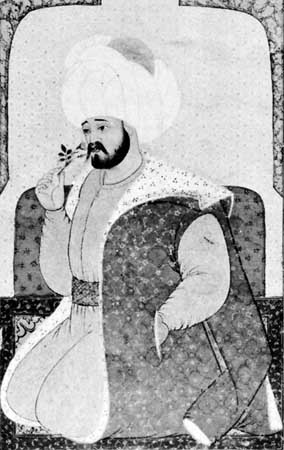 From the early 12th century the Byzantine Empire had begun its slow decline in the face of the Turkish advance. In 1324 or 1326 the Ottoman Turks captured Bursa, on the opposite side of the Sea of Marmara from Constantinople (Istanbul), and this city became the first capital of the Ottoman Empire. In 1453, Constantinople itself fell to the Turks. By then the fashions of each culture had been influencing one another for many years. From the Turks had come the wearing of the caftan and trousers; the Byzantines contributed beautiful silks, jeweled embroideries, and cloth of gold. The Turks adopted this richness of attire with such enthusiasm that, by the 16th century, sultans were trying to stem the tide of luxury in dress, as western Europe had long been attempting to do, by the passing of sumptuary laws (sumptuary law) forbidding the wearing of these materials and decoration except by the privileged few.
From the early 12th century the Byzantine Empire had begun its slow decline in the face of the Turkish advance. In 1324 or 1326 the Ottoman Turks captured Bursa, on the opposite side of the Sea of Marmara from Constantinople (Istanbul), and this city became the first capital of the Ottoman Empire. In 1453, Constantinople itself fell to the Turks. By then the fashions of each culture had been influencing one another for many years. From the Turks had come the wearing of the caftan and trousers; the Byzantines contributed beautiful silks, jeweled embroideries, and cloth of gold. The Turks adopted this richness of attire with such enthusiasm that, by the 16th century, sultans were trying to stem the tide of luxury in dress, as western Europe had long been attempting to do, by the passing of sumptuary laws (sumptuary law) forbidding the wearing of these materials and decoration except by the privileged few.From the 15th century until the modernization of Turkey soon after 1918, the basic garments of the general population changed comparatively little. Although a Europeanization movement had begun about the middle of the 19th century, this was a slow process, affecting mainly the dress of the upper strata of society and that of the urban population. For many years such attire was a blend of styles from western Europe worn together with traditional Ottoman garments.
Traditional men's dress comprised a shirt, trousers, jacket, and boots. The trousers were of the very full, baggy type (similar to the Middle Eastern chalvar), fitting tightly only on the lower leg. A deep waist sash, the kuşak, bound the body over the junction between trouser and shirt. The jacket was a short one, worn open, and was decoratively embroidered. In cold weather a caftan would be worn on top of these garments. The only difference between the clothing worn by the average member of the population and those in a higher social class was that the garments of the latter would be made from richer, more decorative fabrics and that a long caftan would be worn on top. Sometimes more than one such coat was worn, with or without sleeves.
The traditional Turkish cap, the tarboosh, resembles an inverted flower pot and is made of cloth or felt. Similar to the fez, a term believed to have derived from the Moroccan town of that name, this cap was for centuries under the Ottoman Empire bound around the brow with a turban. The cap was made part of the national dress of the Turks during the 19th century and remained so until it was proscribed when Turkey became a republic in 1923. It is still worn by Muslims (Islām) of both sexes in the Middle East.
The dress for women in the Ottoman Empire was very similar to that worn by Muslim women in the Middle East. It consisted of a knee-length, white, sleeved chemise (gömlek) and long drawers tied at the waist (dislik). The usual full trousers (chalvar) were accompanied, as in men's dress, by a decorative waist sash (kuşak). Over these garments a waistcoat (yelek) and long gown (anteri) were worn. Backless slippers were worn indoors. Outdoors the enveloping cloak (tcharchaf) and veil (yashmak) were obligatory, and decorative pattens (kub-kobs) kept the elegant slippers out of the mud of the streets.
The Ottoman Empire extended its control westward in Europe over the Balkans and as far as Hungary, where masculine dress was strongly influenced by Turkish styles. Until well into the 18th century men in these non-Muslim areas wore the dolman over the mente (both are styles of caftan), together with trousers, boots, and a fur-trimmed hat known as the kucsma. Dress for women in these areas, however, followed the current styles of western Europe.
Europe and America (United States): 19th and 20th centuries
The 19th century
 The influence of national features in dress had been declining since about 1675 and by 1800 had become negligible; from then on fashionable dress design was international. The character of the feminine wardrobe stemmed from Paris, the masculine from London (United Kingdom). The English gentleman was established as the best-dressed in Europe, the lead being set by elegants such as Beau Brummell (Brummell, Beau), whose clothes were copied by the prince regent himself (later King George IV (George IV)). Brummell was so concerned with fit that he had his coat made by one tailor, his waistcoat by another, and his breeches by a third. The neckcloth was so elaborate and voluminous that Brummell's valet sometimes spent a whole morning getting it to sit properly.
The influence of national features in dress had been declining since about 1675 and by 1800 had become negligible; from then on fashionable dress design was international. The character of the feminine wardrobe stemmed from Paris, the masculine from London (United Kingdom). The English gentleman was established as the best-dressed in Europe, the lead being set by elegants such as Beau Brummell (Brummell, Beau), whose clothes were copied by the prince regent himself (later King George IV (George IV)). Brummell was so concerned with fit that he had his coat made by one tailor, his waistcoat by another, and his breeches by a third. The neckcloth was so elaborate and voluminous that Brummell's valet sometimes spent a whole morning getting it to sit properly.It was during this period (c. 1811–20) that English modes for men became everywhere accepted as correct, even in Napoleonic France (the top hat, for example, became almost universal). Men's dress slowly became stereotyped, etiquette having laid down detailed regulations for the attire to be worn for different occasions, for different times of day, and by the various social classes. The tailcoat, waisted and padded on the chest, was de rigueur, accompanied by a waistcoat and close-fitting trousers called pantaloons, which were first buckled at the ankle and later, after 1820, strapped under the instep.
French dominance of women's fashion was absolute during the 19th century. Parisian (Paris) designs of garments and accessories were publicized throughout Europe and America by fashion plates and journals. At first originating from England and France, after 1850 they came from all European countries, and the Americans introduced some of the later world-famous journals—for example, Vogue and Harper's Bazaar.
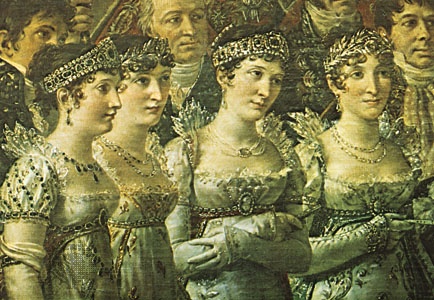 Until about 1820 women's dress continued to reflect the Neoclassical styles initiated in the era of the French Revolution. These fashions were supposedly based upon the Classical dress of ancient Greece. Ladies wore loose, draped, high-waisted gowns in white or pale colours in imitation of those depicted by white marble statuary. Corsets became less restrictive or were abandoned. Hair was dressed in Classical fashion, usually in a chignon bound with ribbons. The Romantic (Romanticism) age of the 1830s brought back more colour, a tighter waistline at a more natural level, fuller skirts, leg-of-mutton sleeves, and complex high coiffures surmounted by large-brimmed hats or bonnets.
Until about 1820 women's dress continued to reflect the Neoclassical styles initiated in the era of the French Revolution. These fashions were supposedly based upon the Classical dress of ancient Greece. Ladies wore loose, draped, high-waisted gowns in white or pale colours in imitation of those depicted by white marble statuary. Corsets became less restrictive or were abandoned. Hair was dressed in Classical fashion, usually in a chignon bound with ribbons. The Romantic (Romanticism) age of the 1830s brought back more colour, a tighter waistline at a more natural level, fuller skirts, leg-of-mutton sleeves, and complex high coiffures surmounted by large-brimmed hats or bonnets. From the 1840s men's dress lost most of its colour: black, shades of gray, blue, and white were the norm. The formal black tailcoat was now reserved for evening attire. For daywear, tailcoats of various types were worn with a waistcoat and the new looser style of trousers over boots. Neckwear was plainer, consisting of a collar with neck scarf. The three-piece lounge suit, with a jacket instead of a tailcoat, was introduced in the 1850s for informal occasions. In the last two decades of the century a more countrified attire consisting of Norfolk jacket and knickerbockers became popular. The name was taken from the nom de plume Diedrich Knickerbocker, which was adopted by Washington Irving (Irving, Washington) for the comic history of New York that he wrote in 1809. In Irving's history, the Knickerbockers were a family of Dutch settlers in 17th-century New Amsterdam who were depicted in George Cruikshank (Cruikshank, George)'s illustrations for the book wearing the fuller style of breeches.
From the 1840s men's dress lost most of its colour: black, shades of gray, blue, and white were the norm. The formal black tailcoat was now reserved for evening attire. For daywear, tailcoats of various types were worn with a waistcoat and the new looser style of trousers over boots. Neckwear was plainer, consisting of a collar with neck scarf. The three-piece lounge suit, with a jacket instead of a tailcoat, was introduced in the 1850s for informal occasions. In the last two decades of the century a more countrified attire consisting of Norfolk jacket and knickerbockers became popular. The name was taken from the nom de plume Diedrich Knickerbocker, which was adopted by Washington Irving (Irving, Washington) for the comic history of New York that he wrote in 1809. In Irving's history, the Knickerbockers were a family of Dutch settlers in 17th-century New Amsterdam who were depicted in George Cruikshank (Cruikshank, George)'s illustrations for the book wearing the fuller style of breeches.The increasing levels of informality extended to hat design, with new styles being introduced. The bowler, also known by such other names as the colloquial British “billycock” and, in America, the derby, was introduced about 1850 by the hatter William Bowler. The straw boater, originally meant to be worn on the river, became popular for all summer activities. The homburg felt hat, introduced in the 1870s and popularized by the Prince of Wales (later King Edward VII), stemmed from the German town of that name. Also popular at this time for sports and country wear in Britain was the deerstalker cap immortalized in the illustration for Sir Arthur Conan Doyle (Conan Doyle, Sir Arthur)'s Sherlock Holmes (Holmes, Sherlock) stories.
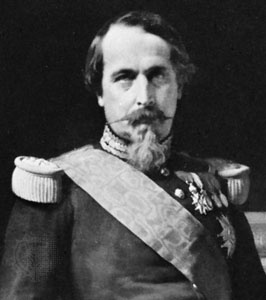 Between about 1840 and 1870, long, bushy side-whiskers were fashionable. These whiskers, which left the chin clean-shaven, were called burnsides or sideburns, after the U.S. Civil War general Ambrose Burnside (Burnside, Ambrose Everett). Other popular beard styles included the imperial, a small goatee named for Napoleon III, and the side-whiskers and drooping mustache known as the Franz Joseph in honour of the head of the Austro-Hungarian Empire. After 1880 men tended to be clean-shaven or to wear a mustache only.
Between about 1840 and 1870, long, bushy side-whiskers were fashionable. These whiskers, which left the chin clean-shaven, were called burnsides or sideburns, after the U.S. Civil War general Ambrose Burnside (Burnside, Ambrose Everett). Other popular beard styles included the imperial, a small goatee named for Napoleon III, and the side-whiskers and drooping mustache known as the Franz Joseph in honour of the head of the Austro-Hungarian Empire. After 1880 men tended to be clean-shaven or to wear a mustache only.The second half of the 19th century was a time of prosperity in Europe. Despite wars and upheavals, the bourgeoisie dressed fashionably and luxuriously. The styles worn by men and women acted as foils to one another—the men's dress (clothing and footwear industry) sombre, dignified, and only slowly changing, the women's dress colourful and changing ever faster in a kaleidoscope of modes. The technical advances and the capability for mass manufacturing that had been brought about by the Industrial Revolution were making fashionable dress available to a rapidly expanding public. The invention of the sewing machine and the Jacquard loom (used for weaving patterned textiles), the development of the ready-to-wear trade, the growth of new marketing techniques, and the establishment of department stores (department store) were revolutionizing the fashion scene.
 In France, haute couture had taken over control of the fashion-design world. The Englishman Charles Frederick Worth (Worth, Charles Frederick), who had emigrated to Paris in 1845, was the first of the great couturiers and one of the most influential. He introduced the practice of preparing a collection of designs, and he was the first to use live models rather than mannequins to display designs to buyers. Although only the rich could afford designer fashions, the styles gradually reached the ready-to-wear market (in a modified form that nonetheless prompted the introduction of new fashions for the upper classes), and haute couture came to lead women's fashions.
In France, haute couture had taken over control of the fashion-design world. The Englishman Charles Frederick Worth (Worth, Charles Frederick), who had emigrated to Paris in 1845, was the first of the great couturiers and one of the most influential. He introduced the practice of preparing a collection of designs, and he was the first to use live models rather than mannequins to display designs to buyers. Although only the rich could afford designer fashions, the styles gradually reached the ready-to-wear market (in a modified form that nonetheless prompted the introduction of new fashions for the upper classes), and haute couture came to lead women's fashions.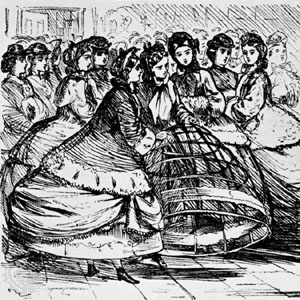 Women's dress from 1840 onward was dominated by a boned corset and framework underskirt. The fullness of the skirt was at first achieved by adding more layers of petticoats (petticoat), leading to the crinoline petticoat of 1850. Named after the materials from which it was originally made (Latin: crinis, “【horse】 hair”; linum, “thread”), this petticoat was, like its predecessors the farthingale and the hoop, a heavy underskirt reinforced by circular hoops (hoop skirt), in this case of whalebone. By 1856 the weight of the petticoats became intolerable, and the cage crinoline was invented. This was a flexible steel framework joined by tapes and having no covering fabric. Sold at two shillings and sixpence, it was immensely popular and worn by most classes of society, at least for Sunday dress. It became the target for cartoonists, who took full advantage of all possible ludicrous situations, but this in no way lessened its popularity.
Women's dress from 1840 onward was dominated by a boned corset and framework underskirt. The fullness of the skirt was at first achieved by adding more layers of petticoats (petticoat), leading to the crinoline petticoat of 1850. Named after the materials from which it was originally made (Latin: crinis, “【horse】 hair”; linum, “thread”), this petticoat was, like its predecessors the farthingale and the hoop, a heavy underskirt reinforced by circular hoops (hoop skirt), in this case of whalebone. By 1856 the weight of the petticoats became intolerable, and the cage crinoline was invented. This was a flexible steel framework joined by tapes and having no covering fabric. Sold at two shillings and sixpence, it was immensely popular and worn by most classes of society, at least for Sunday dress. It became the target for cartoonists, who took full advantage of all possible ludicrous situations, but this in no way lessened its popularity.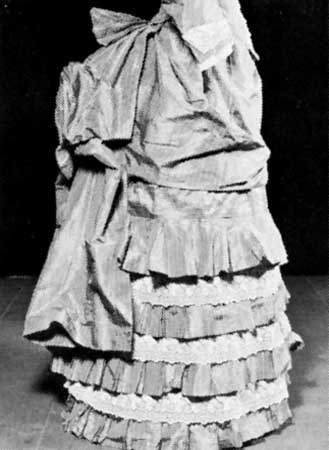 Gradually, in the 1860s, the shape of the crinoline changed, metamorphosing into that of the rear bustle, which was fashionable in the 1870s and '80s. Only in the 1890s did the skirt return to a relatively slender silhouette, but there was no letup in the constrictive corset, which was then at its most painful and harmful stage. In general, the styles of the late 19th century were feminine and elegant but not easy to wear. They restricted natural movement with their multiple layers, extensive decoration, and sheer quantity of material.
Gradually, in the 1860s, the shape of the crinoline changed, metamorphosing into that of the rear bustle, which was fashionable in the 1870s and '80s. Only in the 1890s did the skirt return to a relatively slender silhouette, but there was no letup in the constrictive corset, which was then at its most painful and harmful stage. In general, the styles of the late 19th century were feminine and elegant but not easy to wear. They restricted natural movement with their multiple layers, extensive decoration, and sheer quantity of material.Women's hair, always worn long during the century, was from about 1840 to 1870 dressed in a severe style in which it was drawn back tightly from a centre parting into a bun at the back. Later styles were dressed high on top and in a chignon or ringlets behind. The bonnet in many and varied guises was the chief head covering and was replaced by dainty hats only in the 1870s and '80s. Throughout the 19th century cosmetics were worn mostly by actresses, and rarely if ever by “respectable” women.
Not all the women of the 1880s, however, wore these fashionable clothes. Followers of the Aesthetic (Aestheticism) movement in England wore looser garments with enormous sleeves supposed to resemble those worn by women in early Florentine paintings. The humorous journals of the period made great play with the contrast between fashionable and Aesthetic modes.
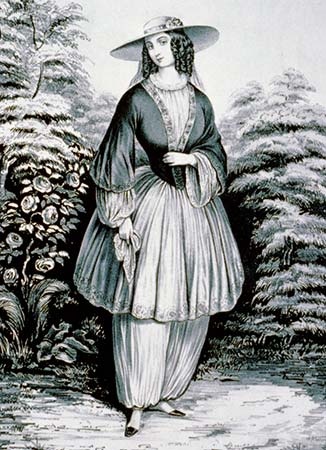 An earlier attempt to introduce a more comfortable, practical attire for women had been made by the American Elizabeth Smith Miller. The costume she designed was enthusiastically advocated by her friend Amelia Jenks Bloomer (Bloomer, Amelia Jenks), a journalist and writer. In 1851 Bloomer traveled to London and Dublin to publicize this dress reform. The outfit, consisting of a jacket and knee-length skirt worn over Turkish-style trousers, was regarded as immodest and unfeminine. It was greeted with horror and disdain, and the idea quickly died. What has survived is the name bloomers, which originally referred to Miller's full trousers but was later applied to long knickers worn as underwear in the early 20th century. Miller's garment was also the inspiration for “rationals” (sometimes also known as bloomers), the knickerbockers worn by women for cycling and sport in the 1890s.
An earlier attempt to introduce a more comfortable, practical attire for women had been made by the American Elizabeth Smith Miller. The costume she designed was enthusiastically advocated by her friend Amelia Jenks Bloomer (Bloomer, Amelia Jenks), a journalist and writer. In 1851 Bloomer traveled to London and Dublin to publicize this dress reform. The outfit, consisting of a jacket and knee-length skirt worn over Turkish-style trousers, was regarded as immodest and unfeminine. It was greeted with horror and disdain, and the idea quickly died. What has survived is the name bloomers, which originally referred to Miller's full trousers but was later applied to long knickers worn as underwear in the early 20th century. Miller's garment was also the inspiration for “rationals” (sometimes also known as bloomers), the knickerbockers worn by women for cycling and sport in the 1890s. Children's (childhood) clothes varied according to their age. Older boys wore clothes similar to those of young men, but some young boys wore so-called “Little Lord Fauntleroy” velvet suits with lace collars and cuffs and with their hair dressed long in curls. Little girls wore dresses that were shorter than those of adult women but otherwise similar.
Children's (childhood) clothes varied according to their age. Older boys wore clothes similar to those of young men, but some young boys wore so-called “Little Lord Fauntleroy” velvet suits with lace collars and cuffs and with their hair dressed long in curls. Little girls wore dresses that were shorter than those of adult women but otherwise similar.The early 20th century
There were dramatic changes in women's dress during the first decade of the 20th century. Men, however, continued to wear a black frock coat with gray striped trousers for formal day wear and a black tailcoat and trousers with a white waistcoat for evening wear if ladies were present. In America, the tuxedo, or dinner, jacket was beginning to provide a more comfortable alternative; the term derives from the fact that the style was introduced in the millionaire district of Tuxedo Park in the state of New York for wear at small dinner parties. Three-piece lounge suits were worn for less formal day functions, and for country and sportswear the Norfolk jacket and knickerbockers remained popular.
 Women's fashions changed considerably between 1900 and 1910. The fashion of 1900 was characterized by an S-shaped silhouette that was achieved mainly by a boned corset that was long and rigid in front and shorter at the rear. The costume was extremely feminine, overdecorated with flounces and lace, frills and embroidery. Picture hats were set upon pompadour coiffures, affixed with hat pins. The neckline was high, and the skirt reached the ground.
Women's fashions changed considerably between 1900 and 1910. The fashion of 1900 was characterized by an S-shaped silhouette that was achieved mainly by a boned corset that was long and rigid in front and shorter at the rear. The costume was extremely feminine, overdecorated with flounces and lace, frills and embroidery. Picture hats were set upon pompadour coiffures, affixed with hat pins. The neckline was high, and the skirt reached the ground.From 1907 important changes began to take place in feminine attire. The French (France) couturier Paul Poiret (Poiret, Paul) led the field in designing an exotic range of glamorous creations in brilliant colours. Poiret claimed that he had freed women from the corset, and he did, in fact, help replace it with the brassiere. However, his skirts were restrictive, making it difficult to walk. His hobble skirt, in which the material was very narrow at the ankle, was particularly aptly named. Poiret's other designs included Eastern-style trousers, Neoclassical gowns, and the so-called lamp shade skirt.
Working women tended to wear a blouse and skirt. During the war years of 1914–18 a minority of women were in uniform, but far more worked in factories, in offices, as postal carriers, and in other jobs previously performed by men. They sometimes wore trousers. Shorter skirts also appeared by 1915, which showed even more of the ankle than Poiret's slit skirts of 1912.
 After the war ended in 1918, styles began to change. Men's dress changed more slowly than women's, but the trend toward informality was accelerated. The tailcoat was reserved for weddings and dances, the lounge suit became the accepted city wear, and sports jackets and gray flannel pants were popular for casual attire. After 1925 trousers commonly featured turnups (cuffs in America), and the legs became increasingly wider; the popular “Oxford bags” measured 20 inches at the hem. Knickerbockers had become fuller and longer, overhanging the kneeband by four inches, and were thus known as plus fours, which remained fashionable until at least 1939. Knitted pullovers (often homemade) in coloured (fair isle) patterns replaced the waistcoat for informal occasions. Technical advances had improved water-repellent fabrics, and most men had a raincoat. A favourite style was the trench coat, a classic design based upon the coats worn by World War I officers in the trenches. Men were mostly clean-shaven, and their hair was short. A peaked cap accompanied leisure wear, and a trilby felt hat the lounge suit. (The latter was named after George du Maurier (du Maurier, George)'s novel; the American term was fedora, named for the heroine of a play.)
After the war ended in 1918, styles began to change. Men's dress changed more slowly than women's, but the trend toward informality was accelerated. The tailcoat was reserved for weddings and dances, the lounge suit became the accepted city wear, and sports jackets and gray flannel pants were popular for casual attire. After 1925 trousers commonly featured turnups (cuffs in America), and the legs became increasingly wider; the popular “Oxford bags” measured 20 inches at the hem. Knickerbockers had become fuller and longer, overhanging the kneeband by four inches, and were thus known as plus fours, which remained fashionable until at least 1939. Knitted pullovers (often homemade) in coloured (fair isle) patterns replaced the waistcoat for informal occasions. Technical advances had improved water-repellent fabrics, and most men had a raincoat. A favourite style was the trench coat, a classic design based upon the coats worn by World War I officers in the trenches. Men were mostly clean-shaven, and their hair was short. A peaked cap accompanied leisure wear, and a trilby felt hat the lounge suit. (The latter was named after George du Maurier (du Maurier, George)'s novel; the American term was fedora, named for the heroine of a play.) For women in the 1920s, freedom in dress reflected the new freedoms opening up for them to take up careers, to study at college, and to enter professions. The skirt hemline rose steadily to become, at its shortest in the years 1925–27, knee-length. With the short skirts, flesh-coloured stockings were introduced, made from expensive silk or more practical lisle or wool (other colours were also worn). Corsets disappeared to be replaced by brassieres and elasticized girdles. Probably the most revolutionary change was in the coiffure. Hair was first cut shorter by trendsetters even before the war, and by the 1920s the shingle and the more severe Eton crop were being adopted by many women. Marcel waving, introduced in the late 19th century, and the later “perm,” or permanent wave, also became popular at this time. The new hairstyles were accompanied by the cloche hat, which closely covered the head.
For women in the 1920s, freedom in dress reflected the new freedoms opening up for them to take up careers, to study at college, and to enter professions. The skirt hemline rose steadily to become, at its shortest in the years 1925–27, knee-length. With the short skirts, flesh-coloured stockings were introduced, made from expensive silk or more practical lisle or wool (other colours were also worn). Corsets disappeared to be replaced by brassieres and elasticized girdles. Probably the most revolutionary change was in the coiffure. Hair was first cut shorter by trendsetters even before the war, and by the 1920s the shingle and the more severe Eton crop were being adopted by many women. Marcel waving, introduced in the late 19th century, and the later “perm,” or permanent wave, also became popular at this time. The new hairstyles were accompanied by the cloche hat, which closely covered the head.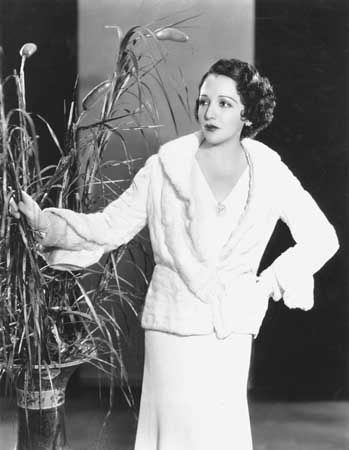 Femininity returned to fashion in the 1930s. The ideal figure was still slim, but the waistline returned to its natural level. The skirt lengthened again until it reached about eight inches above the ground for the daytime and ground length for the evening. For evening styles, the backless dress and halter neckline became fashionable. The bias cut of material, a mode introduced in the 1920s by the French couturiere Madeleine Vionnet, was widely adopted in the 1930s and was very effective with the longer skirts, creating a figure-hugging style which then flared out at the hemline. Brassieres were redesigned to emphasize the breasts.
Femininity returned to fashion in the 1930s. The ideal figure was still slim, but the waistline returned to its natural level. The skirt lengthened again until it reached about eight inches above the ground for the daytime and ground length for the evening. For evening styles, the backless dress and halter neckline became fashionable. The bias cut of material, a mode introduced in the 1920s by the French couturiere Madeleine Vionnet, was widely adopted in the 1930s and was very effective with the longer skirts, creating a figure-hugging style which then flared out at the hemline. Brassieres were redesigned to emphasize the breasts.By this time there was available a great variety of specialized clothing for different occasions, including for sport and leisure or resort activities, such as swimming, skiing, and golfing. The cosmetics (cosmetic) industry had also expanded and became big business in the 1930s; most women routinely carried face powder, lipstick, eye shadow, and tweezers in their handbags for running repairs.
 The high proportion of men and women in uniform in the years 1939–45 strongly influenced the civilian dress style. For women, garments had square padded shoulder lines, and skirts were a practical knee length. Trousers were widely worn by both civilian and military women. After World War II, trousers and trouser suits remained popular, especially between 1945 and 1970. In Europe, the war years meant austerity and clothing coupons; fashion did not have a high priority. Shortages of materials both during and immediately after the war led to the introduction of “utility” styles, especially in Britain, where government rulings insisted on the removal of all superfluous trimmings, including pockets and pleats, and restricted the fullness of garments in order to economize on the amount of fabric used.
The high proportion of men and women in uniform in the years 1939–45 strongly influenced the civilian dress style. For women, garments had square padded shoulder lines, and skirts were a practical knee length. Trousers were widely worn by both civilian and military women. After World War II, trousers and trouser suits remained popular, especially between 1945 and 1970. In Europe, the war years meant austerity and clothing coupons; fashion did not have a high priority. Shortages of materials both during and immediately after the war led to the introduction of “utility” styles, especially in Britain, where government rulings insisted on the removal of all superfluous trimmings, including pockets and pleats, and restricted the fullness of garments in order to economize on the amount of fabric used.Post-World War II
Many changes took place after the late 1940s. The rules of etiquette governing what type of dress should be worn by whom and when had virtually disappeared. Long before the turn of the 21st century, it had become the accepted dictum to “do your own thing,” to choose clothes, whether for day or evening or for formal or holiday wear, according to personal inclination. Wide-scale advertising, especially on television, and modern marketing brought fashion within the reach of all, in both cost and availability. Leading manufacturers and department stores purchased original designs from fashion houses and then manufactured ready-to-wear versions in quantity at various price levels to suit the entire population.
One of the most influential factors in the development of modern fashions was the technological advance in the production of synthetic (synthetic fibre) textile fibres. Permanent pleating, colour-fast dyes, crease resistance, preshrinking, and other easy-care characteristics of synthetics made it possible to manufacture clothing more quickly and less expensively. Although traditional natural fabrics remained popular, they were almost completely replaced by synthetics in the manufacture of some garments. Women's stockings made of nylon, for example, first went on sale about 1940 and, after World War II, soon supplanted all other types. Similarly, the underwear industry was revolutionized when latex thread was employed to fabricate comfortable two-way stretch garments.
The keynote of the changes in men's dress has been casualness. The tailored jacket and vest were steadily ousted and were often replaced by casual jackets and sweaters. Many men accepted little distinction between day and evening attire.
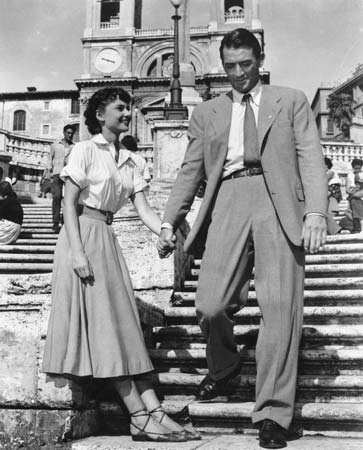 Soon after the war the French designer Christian Dior (Dior, Christian) introduced his 1947 “Corolle” collection, quickly dubbed the “New Look” by the American press. Here was a return to femininity: a long, full skirt with a bouffant ruffled petticoat beneath, a slender waist, and sloping shoulders. This set the style for the next decade or so of feminine fashions and was supplanted only by the rise of the miniskirt in the 1960s. These very short skirts were introduced first in London by Mary Quant (Quant, Mary) and several years later by André Courrèges (Courrèges, André) in Paris. Starting at the knee, the hemline over time crept upward to the upper thigh, a style that had only been made feasible by the introduction of nylon tights (panty hose in the United States). In 1970 other lengths appeared—the midi and the maxi—but neither was as popular as the mini.
Soon after the war the French designer Christian Dior (Dior, Christian) introduced his 1947 “Corolle” collection, quickly dubbed the “New Look” by the American press. Here was a return to femininity: a long, full skirt with a bouffant ruffled petticoat beneath, a slender waist, and sloping shoulders. This set the style for the next decade or so of feminine fashions and was supplanted only by the rise of the miniskirt in the 1960s. These very short skirts were introduced first in London by Mary Quant (Quant, Mary) and several years later by André Courrèges (Courrèges, André) in Paris. Starting at the knee, the hemline over time crept upward to the upper thigh, a style that had only been made feasible by the introduction of nylon tights (panty hose in the United States). In 1970 other lengths appeared—the midi and the maxi—but neither was as popular as the mini.After 1945 much emphasis was placed on clothes for the young. Throughout most of history, children (childhood) and young people had worn basically the same type of clothes as their parents. After 1945 a complete teenage (adolescence) wardrobe evolved, comprising garments that tended to be either extremely tight-fitting or baggy. Blue jeans, once scorned as the attire of prisoners, were popularized by films with young, charismatic stars; perhaps the most important example was Rebel Without a Cause (1955), in which James Dean (Dean, James) played the jeans-clad protagonist.
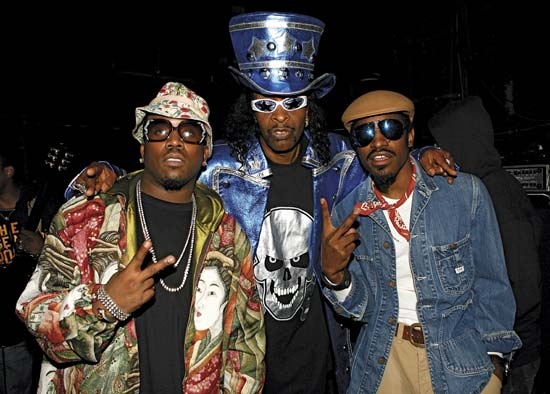 By the late 20th and early 21st century, youth-oriented fashions also included looks inspired by musical styles such as punk rock (punk), glam rock, hip-hop, grunge, heavy metal, and country (country music) (or “roper,” in contrast to the “doper” styles preferred by fans of rock music). Additional influences included Gothic novels (Gothic novel) (“goth”) and science fiction and computers (“geek”). There were also styles typified by wealthy, conservative young adults—“Sloanie” or “Sloane ranger” attire in England (named for the fashionable Sloane Square district of London and initially epitomized by Lady Diana Spencer, the future Diana, princess of Wales); and the “preppie” look in the United States, named for the apparel preferred by students at private college-preparatory schools.
By the late 20th and early 21st century, youth-oriented fashions also included looks inspired by musical styles such as punk rock (punk), glam rock, hip-hop, grunge, heavy metal, and country (country music) (or “roper,” in contrast to the “doper” styles preferred by fans of rock music). Additional influences included Gothic novels (Gothic novel) (“goth”) and science fiction and computers (“geek”). There were also styles typified by wealthy, conservative young adults—“Sloanie” or “Sloane ranger” attire in England (named for the fashionable Sloane Square district of London and initially epitomized by Lady Diana Spencer, the future Diana, princess of Wales); and the “preppie” look in the United States, named for the apparel preferred by students at private college-preparatory schools.The history of Eastern dress
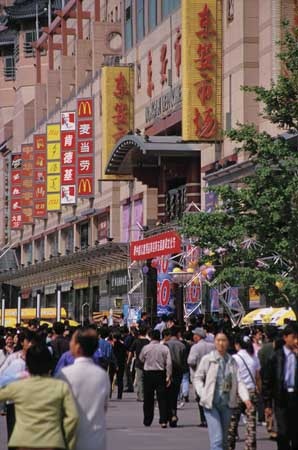 Western-style clothes, which many people find convenient to wear during business hours, are now a common sight in many large cities of eastern and southern Asia. This is particularly so in Japan, which since 1945 has built a reputation as an international fashion centre. However, in Japan, China, and India, traditional dress is often preferred for occasions such as weddings.
Western-style clothes, which many people find convenient to wear during business hours, are now a common sight in many large cities of eastern and southern Asia. This is particularly so in Japan, which since 1945 has built a reputation as an international fashion centre. However, in Japan, China, and India, traditional dress is often preferred for occasions such as weddings.Over the centuries, notably in Korea and Japan, traditional styles of dress have reflected a marked Chinese influence, though both countries developed characteristic styles of their own. In like manner, modes of dress in the South Asian subcontinent have been a source of inspiration to some of the countries of Southeast Asia and of the East Indian archipelago.
China
By the Shang dynasty (c. 1600–1046 BCE) Chinese (China) sericulture—the raising of silk worms and the production of silk—had become very sophisticated. textile production was associated with women; as a proverb put it, “men till, women weave.” Already by the Dong (Eastern) Zhou dynasty (770–256 BCE) the art of weaving complex patterned silks was well advanced.
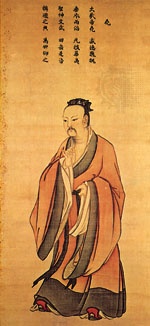 By the end of the Han dynasty (206 BCE–220 CE) virtually every technique of weaving now known had already been invented in China. Han bas-reliefs (bas-relief) and scenes painted on tiles show men and women dressed in wide-sleeved kimono-like garments which, girdled at the waist, fall in voluminous folds around their feet. This pao robe changed form but continued to be worn in China until the end of the Ming dynasty in 1644. Other traditional garments include the tunic or jacket, worn by both sexes over loosely cut trousers. For colder weather, clothing was padded with cotton or silk or lined with fur.
By the end of the Han dynasty (206 BCE–220 CE) virtually every technique of weaving now known had already been invented in China. Han bas-reliefs (bas-relief) and scenes painted on tiles show men and women dressed in wide-sleeved kimono-like garments which, girdled at the waist, fall in voluminous folds around their feet. This pao robe changed form but continued to be worn in China until the end of the Ming dynasty in 1644. Other traditional garments include the tunic or jacket, worn by both sexes over loosely cut trousers. For colder weather, clothing was padded with cotton or silk or lined with fur.Chinese records indicate that at least as early as the Tang dynasty (618–907) certain designs, colours, and accessories were used to distinguish the ranks of imperial, noble, and official families; the earliest visual evidence of these emblematic distinctions in dress is to be found in Ming portraits. In some of these, emperors are portrayed in voluminous dark-coloured pao on which are seen the 12 symbols—dragon, pheasant, sun, moon, constellation, fire, mountain, axe, chalice, water weed, millet, and fu—that from time immemorial had been designated as imperial insignia. Other Ming portraits show officials clothed in red pao that have large bird or animal squares (called “mandarin squares,” or pufang) on the breast, as specific bird and animal emblems to designate each of the nine ranks of civil and military officials had been adopted by the Ming in 1391.
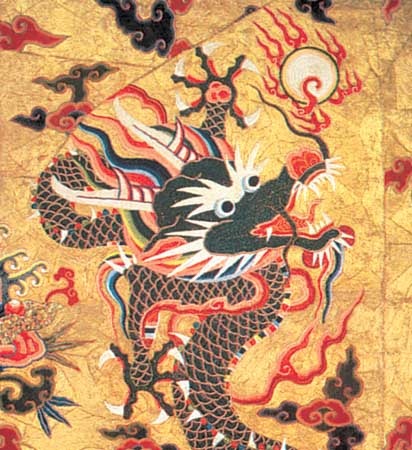 When the Manchus (Manchu) overthrew the Ming and established the Qing dynasty (1644–1911/12), it was decreed that new styles of dress should replace the pao costume. The most formal of the robes introduced by the Manchus was the chaofu, designed to be worn only at great state sacrifices and at the most important court functions. Men's chaofu had a kimono-style upper body, with long, close-fitting sleeves that terminated in the “horsehoof” cuff introduced by the Manchus, and a closely fitted neckband over which was worn a detached collar distinguished by winglike tips that extended over the shoulders. Below, attached to a set-in waistband, was a full, pleated or gathered skirt. Precisely stipulated colours and pattern arrangements of five-clawed dragons and clouds, waves, and mountains were specified for the chaofu of emperors, princes, nobles, and officials; the emperor's lofty rank was clearly identified by the bright yellow of his robe and the 12 imperial symbols emblazoned on it. All other ranks wore “stone blue” chaofu decorated in accordance with prescribed rules about the number, type, and arrangement of dragon motifs.
When the Manchus (Manchu) overthrew the Ming and established the Qing dynasty (1644–1911/12), it was decreed that new styles of dress should replace the pao costume. The most formal of the robes introduced by the Manchus was the chaofu, designed to be worn only at great state sacrifices and at the most important court functions. Men's chaofu had a kimono-style upper body, with long, close-fitting sleeves that terminated in the “horsehoof” cuff introduced by the Manchus, and a closely fitted neckband over which was worn a detached collar distinguished by winglike tips that extended over the shoulders. Below, attached to a set-in waistband, was a full, pleated or gathered skirt. Precisely stipulated colours and pattern arrangements of five-clawed dragons and clouds, waves, and mountains were specified for the chaofu of emperors, princes, nobles, and officials; the emperor's lofty rank was clearly identified by the bright yellow of his robe and the 12 imperial symbols emblazoned on it. All other ranks wore “stone blue” chaofu decorated in accordance with prescribed rules about the number, type, and arrangement of dragon motifs.Only women of very high rank were permitted to wear chaofu. Women's robes were less commodious than the men's and were cut in long, straight lines with no break at the waist. The narrow sleeves with horsehoof cuffs of these chaofu robes and the arrangement of their dragon, cloud, mountain, and wave patterns were essentially the same as those of the so-called dragon robes discussed below. They were clearly differentiated from the dragon robes, however, by their capelike collars and by flaring epaulets that gradually narrowed as they continued downward and under the arms. Stole-like vests, always worn over women's chaofu, were also a distinguishing feature of this costume.
Qifu, or “dragon robes” (longpao) as they were usually called, were designed for regular court wear by men and women of imperial, noble, and official rank. The qifu was a straight, kimono-sleeved robe with a closely fitted neckband that continued across the breast and down to the underarm closing on the right side, the long tubular sleeves terminating in horsehoof cuffs. The skirt of the qifu cleared the ground to permit easy walking and in men's garments was slit front and back as well as at the sides to facilitate riding; the extra slits were the only feature that distinguished the qifu of men below the rank of emperor from those of their wives. All qifu were elaborately patterned with specified arrangements of dragons, clouds, mountains, and waves, to which were added Buddhist (Buddhism), Daoist (Daoism), or traditionally auspicious motifs. Distinctions in rank were indicated by the colours of the robes and by slight variations in the basic patterns; however, because of the large number of personages who wore qifu, these distinctions were not always easily recognizable. Emperors' qifu, either yellow or blue, were always distinguished by the 12 imperial symbols.
The informal Manchu changfu, a plain long robe, was worn by all classes from the emperor down, though Chinese women also continued to wear their Ming-style costumes, which consisted of a three-quarter-length jacket and pleated skirt. Men's changfu, cut in the style of the qifu, usually were made of monochrome patterned damask or gauze; women's changfu had wide, loose sleeves finished off with especially designed sleevebands decorated with gay woven or embroidered patterns.
The declining Qing dynasty was swept aside in 1912, and China began to emulate the world outside its boundaries. Gradually this was reflected in dress. By the 1920s upper-class women, in particular, had adopted a compromise attire. This was the qipao, better known in the West by its Cantonese name, cheongsam, or as a “mandarin dress.” The qipao had developed from the changfu. A close-fitting dress made from one piece of material, the qipao was fastened up the right (or more rarely, the left) front side. It had a high mandarin collar, and its skirt was slit up the sides to the knee. It was made of traditional Chinese fabrics, padded in winter for warmth. At first it was a long dress, but the hemline gradually rose.
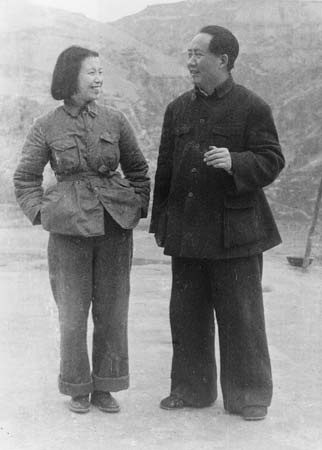 In mainland China the communist revolution of 1949 brought strict directives on dress. Styles were to be the same for everyone, whether man or woman, intellectual or manual labourer. The drab uniform that resulted, often known as a “Mao suit” because it was favoured by Mao Zedong, was a blend of peasant and military design. It consisted of a military-style high-collared jacket and long trousers. Men's hair was short and usually covered by a peaked cap. Women's hair was longer and uncurled. Shoes had flat heels. No cosmetics or jewelry were permitted. Traditional Chinese cotton was used to make the garments; colour designated worker, soldier, or cadre. After about 1960 a small degree of Westernization set in, permitting a variation in colour and fabric. Dresses were introduced for women.
In mainland China the communist revolution of 1949 brought strict directives on dress. Styles were to be the same for everyone, whether man or woman, intellectual or manual labourer. The drab uniform that resulted, often known as a “Mao suit” because it was favoured by Mao Zedong, was a blend of peasant and military design. It consisted of a military-style high-collared jacket and long trousers. Men's hair was short and usually covered by a peaked cap. Women's hair was longer and uncurled. Shoes had flat heels. No cosmetics or jewelry were permitted. Traditional Chinese cotton was used to make the garments; colour designated worker, soldier, or cadre. After about 1960 a small degree of Westernization set in, permitting a variation in colour and fabric. Dresses were introduced for women.After Mao's death in 1976, China experienced a distinct, if gradual, loosening of communist (communism) directives. In terms of fashion, the increasingly entrepreneurial economy created both the desire for and the financial means to obtain a wider variety of dress, especially in urban areas.
Japan
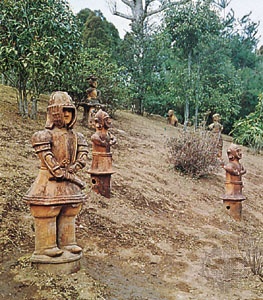 The earliest representations of dress styles in Japan are to be found in 3rd- to 5th-century CE clay grave figures ( haniwa), a few of which show men and women wearing meticulously detailed two-piece costumes consisting of crossed-front jackets that flare out over the hips, the men's worn over full trousers, which, banded above the knees, hang straight and loose beneath; women's jackets were worn over pleated skirts.
The earliest representations of dress styles in Japan are to be found in 3rd- to 5th-century CE clay grave figures ( haniwa), a few of which show men and women wearing meticulously detailed two-piece costumes consisting of crossed-front jackets that flare out over the hips, the men's worn over full trousers, which, banded above the knees, hang straight and loose beneath; women's jackets were worn over pleated skirts.Two-piece costumes appear to have been worn regularly during the 7th and 8th centuries, the jackets of this period being called kinu, the men's trousers hakama, and the women's skirts mo.
However, during the Nara period (710–784) Japanese court circles adopted Chinese court dress, the most characteristic feature of which was the long kimono-style pao garment. It is clear that emblematic colours and patterns as well as the pao style were borrowed from China because modern court dress in Japan, which has been little changed since the 12th century, has many purely Chinese characteristics.
The most important court costumes of Japan are the sokutai of the emperor and the jūni-hitoe of the empress, which are worn only at coronations and at important ceremonial functions. Similar costumes are worn by the crown prince, by princes and princesses of the blood, by high officials, and by ladies-in-waiting.
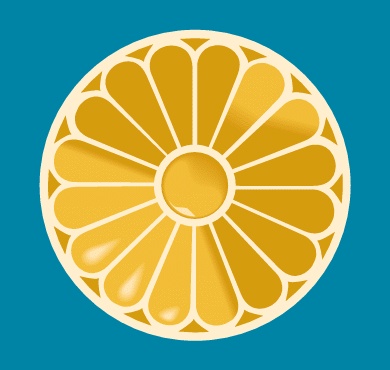 The sokutai ensemble begins with a cap-shaped headdress of black lacquered silk (the kammuri), which includes an upright pennon decorated with the imperial chrysanthemum crest. The voluminous outer robe (ho) is cut in the style of the Chinese pao but is given a distinctively Japanese look by being tucked up at the waist so that the skirt ends midway between the knees and the floor. This ho robe is yellow (the colour worn only by emperors and their families in China), and it is patterned with hō-ō birds and kilin (Japanized versions of the mythical Chinese fenghuang and qilin). The outer and most important of three kimonos (kimono) worn under the ho is the shitagasane, which has an elongated back panel that forms a train some 12 feet (4 metres) long. The shitagasane is made of white damask, as are the baggy white trousers (ue-no-hakama) that are a characteristic feature of the sokutai costume. All these garments are purely Japanese in style. However, the ivory tablet (shaku) carried by the emperor when wearing the sokutai was undoubtedly inspired by tablets of jade that Chinese emperors carried as symbols of their imperial power.
The sokutai ensemble begins with a cap-shaped headdress of black lacquered silk (the kammuri), which includes an upright pennon decorated with the imperial chrysanthemum crest. The voluminous outer robe (ho) is cut in the style of the Chinese pao but is given a distinctively Japanese look by being tucked up at the waist so that the skirt ends midway between the knees and the floor. This ho robe is yellow (the colour worn only by emperors and their families in China), and it is patterned with hō-ō birds and kilin (Japanized versions of the mythical Chinese fenghuang and qilin). The outer and most important of three kimonos (kimono) worn under the ho is the shitagasane, which has an elongated back panel that forms a train some 12 feet (4 metres) long. The shitagasane is made of white damask, as are the baggy white trousers (ue-no-hakama) that are a characteristic feature of the sokutai costume. All these garments are purely Japanese in style. However, the ivory tablet (shaku) carried by the emperor when wearing the sokutai was undoubtedly inspired by tablets of jade that Chinese emperors carried as symbols of their imperial power.The outermost garment of the empress's jūni-hitoe costume is a wide-sleeved jacket (karaginu) that reaches only to the waist and has a pattern of hō-ō bird medallions brocaded in colours of the empress's choice. Attached to the waist at the back of the karaginu is a long, pleated train (mo) of sheer, white silk decorated with a painted design. The outer kimono (uwagi) is very large to accommodate the many layers of kimono worn under it, and it has an abnormally long skirt that is worn swirling out around the wearer's feet. This, too, is made of rich brocade, its design and colours being a matter of personal taste. Under the uwagi is a plain purple kimono, and under that is a robe known as the itsutsu-ginu. The itsutsu-ginu has multiple bands of coloured silks (usually five) attached at the edges of the sleeves, at the neckline, and at the hem, giving the appearance of several robes worn one over another.
No special interest attaches to the hitoe kimono worn under the itsutsu-ginu or to the kosode worn next to the body, but the divided skirt (naga-bakama) that completes the costume is an extremely picturesque garment. Made of stiff, red cloth and fastened high up under the breasts, the naga-bakama covers the feet in front and is carried out in a train in back. Worn with the jūni-hitoe is an elaborate coiffure known as suberakashi, and affixed directly over the forehead are special hair ornaments (hairdressing) consisting of a lacquered, gold-sprinkled comb surmounted by a gold lacquered chrysanthemum crest.
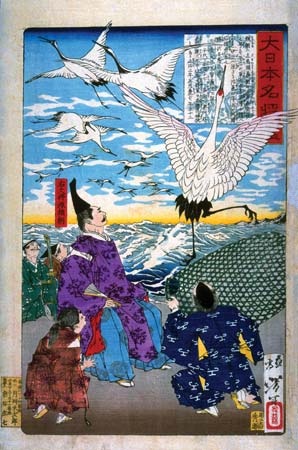 Other types of dress formalized in the 12th century were the noshi (courtiers' everyday costumes) and the kariginu, worn for hunting. Both of these garments were voluminous hip-length jackets worn with baggy trousers tied at the ankles. As political control shifted from the emperor to the newly formed shogunate, it became necessary to devise special costumes for the samurai, the caste from which the shogun drew his power. The hitatare, the formal court robe of samurai, and the suo, a crested linen robe designed for everyday wear, were characterized by V-shaped necklines accentuated by inner-robe neckbands of white.
Other types of dress formalized in the 12th century were the noshi (courtiers' everyday costumes) and the kariginu, worn for hunting. Both of these garments were voluminous hip-length jackets worn with baggy trousers tied at the ankles. As political control shifted from the emperor to the newly formed shogunate, it became necessary to devise special costumes for the samurai, the caste from which the shogun drew his power. The hitatare, the formal court robe of samurai, and the suo, a crested linen robe designed for everyday wear, were characterized by V-shaped necklines accentuated by inner-robe neckbands of white.Several centuries later the samurai adopted the kamishimo, a striking jumperlike garment, with extended shoulders and pleated skirt-trousers, which was worn over the hitatare. This costume probably inspired a later fashion of wearing skirt-trousers (hakama) over a full-length black kimono, which, together with the short black haori coat, was until fairly recently the approved formal attire for Japanese men.
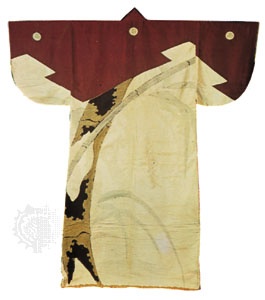
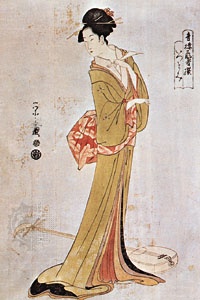 The basic kimono style adopted by Japanese women during the Nara period has remained amazingly close to that of the pao robes worn by the women of Tang China. The practice of wearing a short-sleeved kimono (kosode) as an outer garment and belting it in with a narrow sash ( obi) originated during the Muromachi period (Ashikaga shogunate; 1338–1573), when samurai women began to wear a voluminous outer kimono (uchikake) as a kind of mantle. Eventually, the kosode came to be worn only by married women, the long-sleeved furisode being reserved for young unmarried girls. The wide obi, tied in a variety of ways and fastened with an often intricately carved toggle ( netsuke), was adopted in the early 18th century, and it was at this time also that women first began to wear the short haori coat, which has come to be an important feature of Japanese women's dress.
The basic kimono style adopted by Japanese women during the Nara period has remained amazingly close to that of the pao robes worn by the women of Tang China. The practice of wearing a short-sleeved kimono (kosode) as an outer garment and belting it in with a narrow sash ( obi) originated during the Muromachi period (Ashikaga shogunate; 1338–1573), when samurai women began to wear a voluminous outer kimono (uchikake) as a kind of mantle. Eventually, the kosode came to be worn only by married women, the long-sleeved furisode being reserved for young unmarried girls. The wide obi, tied in a variety of ways and fastened with an often intricately carved toggle ( netsuke), was adopted in the early 18th century, and it was at this time also that women first began to wear the short haori coat, which has come to be an important feature of Japanese women's dress.The yukata, which is worn by both men and women, is a cotton kimono with stencil-dyed (dye) patterns (usually done in shades of indigo) that was originally designed for wear in the home after a bath. Because it has become accepted practice to wear yukata on the street on warm summer evenings, the cottons designed for them have become increasingly handsome.
Traditional Japanese footwear includes sandals, slippers, and wooden clogs (geta) worn with the tabi, a sock with a separate section for the big toe.
Korea
Some of the basic elements of modern traditional dress in Korea, the chŏgori (jacket), paji (trousers), and turumagi (overcoat), were probably worn at a very early date, but the characteristic two-piece costume of today did not begin to evolve until the period of the Three Kingdoms (Three Kingdoms period) (c. 57 BCE–668 CE). During the early part of this period both men and women wore tight, waist-length jackets and short, tight trousers; and it is believed that the Koreans' traditional fondness for white clothing dates from this period.
Korean records state that special costumes for court wear modeled after those of Tang China were adopted during the 7th century; but Chinese influence on Korean dress at this period is verifiable only in changes that occurred in the everyday costumes of the nobility. Noblewomen formerly had worn tight trousers and jackets (which continued to be worn by the poorer classes); now they began to appear in wide-sleeved, hip-length jackets, belted at the waist, and in full-length skirt-trousers. The corresponding dress for noblemen was a narrower, tunic-style jacket, cuffed at the wrists, belted, and worn with roomy trousers bound in at the ankles. The most striking evidence of Chinese influence at this time is to be seen in the style of the turumagi overcoat worn by noblemen, pictured in fresco paintings as a voluminous full-length garment made almost exactly like the pao robe of Tang China. One-piece robes were not worn in Korea until the late 13th century, when the court was forced to adopt Mongol dress; after Mongol domination ended in 1364, Koreans wore the one-piece robe only at wedding ceremonies.
In the 15th century, Korean women began to wear pleated skirts (chima) and longer chŏgori, a style that was undoubtedly introduced from China. Noblewomen wore full-length chima to indicate their social standing and began gradually to shorten the chŏgori until eventually it attained its present length, just covering the breast. This style made it necessary to reduce the fullness of the skirt somewhat in order to make it possible to extend it almost up to the armpits, which remains the fashion.
The adoption of Chinese-style mandarin squares as emblems of rank for civil and military officials (who wore them on their turumagi) appears to have been the only notable example of Chinese influence on men's dress at this period. Otherwise, few changes were made until 1894, when class distinctions were relaxed by government decree. It was at this time that the turumagi was shortened and narrowed to its present form.
The most picturesque costume of modern Korea is that of men of leisure, yangban, who are past 60 years of age. The yangban wear white almost exclusively, their costumes consisting of full trousers tied at the ankles with ribbons, over which is worn a short chŏgori and a fitted vest and, over all, a loose turumagi, which falls just below the knees and is tied at the breast. The patriarchal appearance of the yangban (who is usually bearded) is accentuated by a black horsehair hat, its flat brim and high crown giving him somewhat the appearance of an American colonial Pilgrim Father (Pilgrim Fathers). Younger men wear a similar costume (though not the hat) in gray, light blue, or light brown.
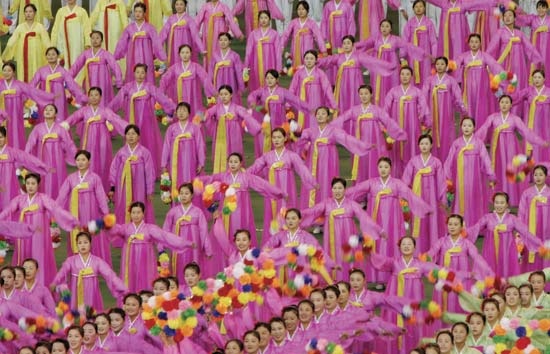 Women's costumes feature a bolero-style white chŏgori, finished off at the neck by a figured band or ribbon that ties from left to right, and overlaid by high-waisted chima, which, in formal costumes, is a full, billowing garment made of beautifully patterned silk.
Women's costumes feature a bolero-style white chŏgori, finished off at the neck by a figured band or ribbon that ties from left to right, and overlaid by high-waisted chima, which, in formal costumes, is a full, billowing garment made of beautifully patterned silk.South Asia
The Hindu (Hinduism) population of South Asia (Sri Lanka) comprises about 2,000 castes (caste), each of whose members wear distinct clothes and ornaments. Thus, the subject of dress cannot be dealt with satisfactorily in a few paragraphs. Some of the principal features of upper-class Hindu (Hinduism) and Muslim (Islām) dress and the history of their development can, however, be sketched briefly.
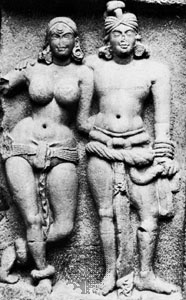 The ancient origin of two of the most characteristic garments of modern India, the dhoti worn by men and the sari worn by women, is verifiable in sculptured reliefs as far back as the 2nd century BCE. Both men and women are pictured wearing a long piece of cloth wrapped around the hips and drawn between the legs in such a fashion that it forms a series of folds down the front. The upper bodies of both men and women were unclothed, though women sometimes wore a narrow cloth girdle around the waist. Men are pictured wearing large turbans, women with head scarves that fall to the hips. Women also wore a great amount of jewelry—bracelets, anklets, and girdles—but men's ornaments consisted solely of bracelets.
The ancient origin of two of the most characteristic garments of modern India, the dhoti worn by men and the sari worn by women, is verifiable in sculptured reliefs as far back as the 2nd century BCE. Both men and women are pictured wearing a long piece of cloth wrapped around the hips and drawn between the legs in such a fashion that it forms a series of folds down the front. The upper bodies of both men and women were unclothed, though women sometimes wore a narrow cloth girdle around the waist. Men are pictured wearing large turbans, women with head scarves that fall to the hips. Women also wore a great amount of jewelry—bracelets, anklets, and girdles—but men's ornaments consisted solely of bracelets.No major change in costume appears to have been made until the 12th century, when the Muslims conquered northern and central India. In this part of the subcontinent, radical new dress styles were adopted to conform with Muslim practice, which required that the body be covered as completely as possible. Men's costumes thereafter consisted of the jamah, a long-sleeved coat that reached to the knees or below and was belted in with a sash, and wide trousers known as isar. These garments and the farji, a long, gownlike coat with short sleeves, which was worn by priests, scholars, and high officials, were made of cotton or wool, silk being forbidden to men by the Qurʾān. Somewhat modified, these traditional styles continue to be worn by upper-class men of Pakistan and Bangladesh.
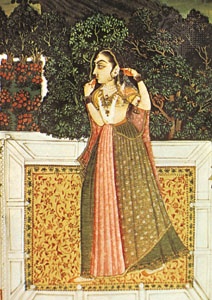 Women's garments (purdah) consisted of wide-topped trousers snugly fitted around the calves of the legs, a long shirtlike garment, and a short, fitted outer jacket. Silk was not forbidden to women; and highborn women, forced to spend their lives in seclusion, devoted much time and money to their costumes. During the Mughal Dynasty (c. 1526–1748), emperor Akbar's Rajput (Rājput) wives became inspired by the profusion of luxurious fabrics available in India and designed a graceful new style of dress that Muslim women adopted forthwith. This costume consisted of an open-front pleated skirt, or ghaghra, worn with a long apronlike panel over the front opening, and a short-sleeved, breast-length blouse called a coli. The ghaghra and coli continue to be basic elements of Muslim women's dress, the loose front panel replaced by the traditional sari, which is worn as an overgarment, one end draped around the hips, the other carried up over the shoulder or head.
Women's garments (purdah) consisted of wide-topped trousers snugly fitted around the calves of the legs, a long shirtlike garment, and a short, fitted outer jacket. Silk was not forbidden to women; and highborn women, forced to spend their lives in seclusion, devoted much time and money to their costumes. During the Mughal Dynasty (c. 1526–1748), emperor Akbar's Rajput (Rājput) wives became inspired by the profusion of luxurious fabrics available in India and designed a graceful new style of dress that Muslim women adopted forthwith. This costume consisted of an open-front pleated skirt, or ghaghra, worn with a long apronlike panel over the front opening, and a short-sleeved, breast-length blouse called a coli. The ghaghra and coli continue to be basic elements of Muslim women's dress, the loose front panel replaced by the traditional sari, which is worn as an overgarment, one end draped around the hips, the other carried up over the shoulder or head.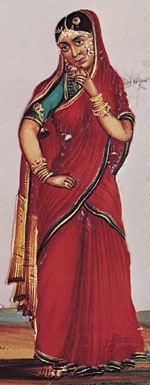 Dress in southern India was little affected by Muslim rule in the north. The dhoti continued to be worn by most Hindu men (it was traditionally forbidden to some castes) and the sari by women. Some additions to these traditional costumes have been adopted. On formal and semiformal occasions many Hindu men wear a long, full-skirted, white cotton coat, which reaches to the knees and buttons down the front from top to bottom, over jodhpur-style white trousers; most Hindu women wear a short coli-style blouse under a sari or with a long skirt under a loose waist-length bodice.
Dress in southern India was little affected by Muslim rule in the north. The dhoti continued to be worn by most Hindu men (it was traditionally forbidden to some castes) and the sari by women. Some additions to these traditional costumes have been adopted. On formal and semiformal occasions many Hindu men wear a long, full-skirted, white cotton coat, which reaches to the knees and buttons down the front from top to bottom, over jodhpur-style white trousers; most Hindu women wear a short coli-style blouse under a sari or with a long skirt under a loose waist-length bodice.The nature and purposes of dress
Perhaps the most obvious function of dress is to provide warmth and protection. Many scholars believe, however, that the first crude garments and ornaments worn by humans were designed not for utilitarian but for religious or ritual purposes. Other basic functions of dress include identifying the wearer (by providing information about sex, age, occupation, or other characteristics) and making the wearer appear more attractive. Although it is clear why such uses of dress developed and remain significant, it can often be difficult to determine how they are achieved. Some garments thought of as beautiful offer no protection whatsoever and may in fact even injure the wearer. Items that definitely identify one wearer can lose their meaning in another time and place. Clothes that are deemed handsome in one period are declared downright ugly in the next, and even uniforms—the simplest and most easily identified costume—are subject to change. What are the reasons for such changes? Why do people replace garments before they are worn out? In short, why does fashion, as opposed to mere dress, exist?
There are no simple answers to such questions, of course, and any one reason is influenced by a multitude of others, but certainly one of the most prevalent theories is that fashion evolved in conjunction with capitalism and the development of modern socioeconomic (social status) classes (social class). Thus, in relatively static societies with limited movement between classes, as in many parts of Asia until modern times or in Europe before the Middle Ages, styles did not undergo a pattern of change. In contrast, when lower classes have the ability to copy upper classes, the upper classes quickly instigate fashion changes that demonstrate their authority and high position. During the 20th century, for example, improved communication and manufacturing technology enabled new styles to trickle down from the elite to the masses at ever faster speeds, with the result that fashion change accelerated.
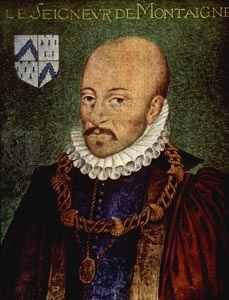 Furthermore, the idea that fashion is a reflection of wealth and prestige can be used to explain the popularity of many styles throughout costume history. For example, royal courts have been a major source of fashion in the West, where clothes that are difficult to obtain and expensive to maintain have frequently been at the forefront of fashion. Ruffs (ruff), for example, required servants to reset them with hot irons and starch every day and so were not generally worn by ordinary folk. As such garments become easier to buy and care for, they lose their exclusivity and hence much of their appeal. For the same reason, when fabrics or materials are rare or costly, styles that require them in excessive, extravagant amounts become particularly fashionable—as can be seen in the 16th-century vogue for slashing outer garments to reveal a second layer of luxurious fabric underneath.
Furthermore, the idea that fashion is a reflection of wealth and prestige can be used to explain the popularity of many styles throughout costume history. For example, royal courts have been a major source of fashion in the West, where clothes that are difficult to obtain and expensive to maintain have frequently been at the forefront of fashion. Ruffs (ruff), for example, required servants to reset them with hot irons and starch every day and so were not generally worn by ordinary folk. As such garments become easier to buy and care for, they lose their exclusivity and hence much of their appeal. For the same reason, when fabrics or materials are rare or costly, styles that require them in excessive, extravagant amounts become particularly fashionable—as can be seen in the 16th-century vogue for slashing outer garments to reveal a second layer of luxurious fabric underneath. Similarly, it has been thought that impractical fashions demonstrate that the wearer does not need to work, and indeed would find it difficult to do so. Examples include the Chinese practice of binding women's feet, making it difficult for the women to walk far. Yet this did not prevent working-class Chinese families from binding their daughters' feet. In Europe, corsets (corset) were worn not only by aristocratic women but also by middle-class and working-class women. Contrary to popular belief, 19th-century women's clothing does not prove that a woman's husband or father could afford to hire servants to work for her. Men have also worn their share of impractical apparel; notable examples include the necktie and the high, powdered wig.
Similarly, it has been thought that impractical fashions demonstrate that the wearer does not need to work, and indeed would find it difficult to do so. Examples include the Chinese practice of binding women's feet, making it difficult for the women to walk far. Yet this did not prevent working-class Chinese families from binding their daughters' feet. In Europe, corsets (corset) were worn not only by aristocratic women but also by middle-class and working-class women. Contrary to popular belief, 19th-century women's clothing does not prove that a woman's husband or father could afford to hire servants to work for her. Men have also worn their share of impractical apparel; notable examples include the necktie and the high, powdered wig.The foregoing discussion does not attempt to be a comprehensive introduction to even one influence on fashion; it merely tries to suggest some of the ways in which costume can be analyzed and interpreted. Similar treatments of four other factors affecting fashion follow.
Display of the human physique
Male display
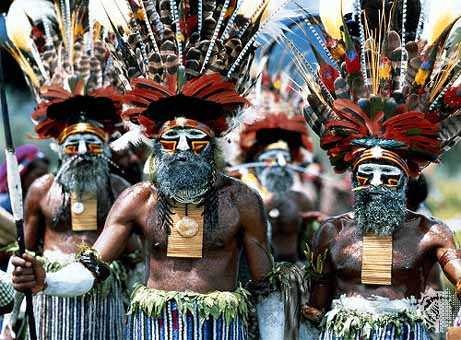 Male sexual display at its most blatant can be seen in parts of Papua New Guinea, where the men wear penis sheaths (usually made from a dried gourd) that may be 15 inches long or in some cases even longer. The purpose is to impress both women and enemies, by showing that the warriors are more virile than their opponents. The competition between warriors has led to a great variety of additional adornments such as boars' tusks, animal skins, animal teeth, claws, feathers, shells, metal pieces, bamboo, and the use of paint. In general, the more naked a society is, the more body paint, tattoos (tattoo), or scarification is employed to denote the warriors and the chiefs, with each rank having its individual pattern. In addition, in many societies, only after an individual has reached a certain age or satisfied some other requirements is he allowed to wear certain colours or decorations. Sometimes each item of adornment represents a specific achievement, so that the more decorations a man wears, the better, braver, or more powerful he is shown to be.
Male sexual display at its most blatant can be seen in parts of Papua New Guinea, where the men wear penis sheaths (usually made from a dried gourd) that may be 15 inches long or in some cases even longer. The purpose is to impress both women and enemies, by showing that the warriors are more virile than their opponents. The competition between warriors has led to a great variety of additional adornments such as boars' tusks, animal skins, animal teeth, claws, feathers, shells, metal pieces, bamboo, and the use of paint. In general, the more naked a society is, the more body paint, tattoos (tattoo), or scarification is employed to denote the warriors and the chiefs, with each rank having its individual pattern. In addition, in many societies, only after an individual has reached a certain age or satisfied some other requirements is he allowed to wear certain colours or decorations. Sometimes each item of adornment represents a specific achievement, so that the more decorations a man wears, the better, braver, or more powerful he is shown to be.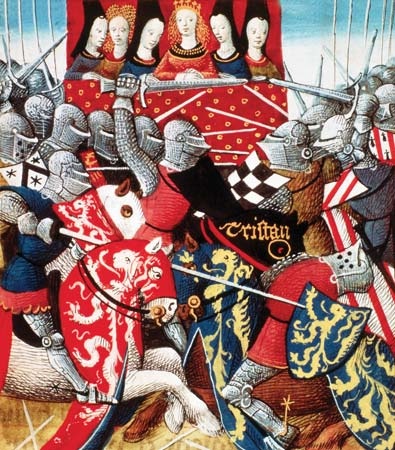 Martial display in Europe reached its apex with the tournaments (tournament) of the Middle Ages. The participants spent fortunes on enameled armour, ostrich plumes, pearl-embroidered tabards, ornate saddles and horsecloths, fine mounts, a retinue of grooms and squires, weapons, tents, and other materials. It was a formalized kind of warfare, and foreign ambassadors were invited to be impressed by the martial display of the king or prince. An audience of women was also essential, as they had to confer favours on the knights (knight), and the lady of the tournament had to present the bejeweled prize to the overall victor.
Martial display in Europe reached its apex with the tournaments (tournament) of the Middle Ages. The participants spent fortunes on enameled armour, ostrich plumes, pearl-embroidered tabards, ornate saddles and horsecloths, fine mounts, a retinue of grooms and squires, weapons, tents, and other materials. It was a formalized kind of warfare, and foreign ambassadors were invited to be impressed by the martial display of the king or prince. An audience of women was also essential, as they had to confer favours on the knights (knight), and the lady of the tournament had to present the bejeweled prize to the overall victor.In terms of its blatant attempt to draw attention to the phallus, the European codpiece was analogous to the penis sheath of New Guinea. During the 14th century men started shortening their tunics until they reached the crotch. A special pouch, the codpiece, had to be created to fill in the gap between the hose, as the latter comprised a pair of individual cloth tubes—one for each leg—that tied directly to a belt at the waist. Initially the codpiece was not padded, but it grew larger until by the 1540s the Spanish (Spain) were wearing a vertical, or erect, codpiece. This style—and its spread to other parts of Europe—may be seen to be a reflection of Spain's new dominance in the Western world and its new wealth.
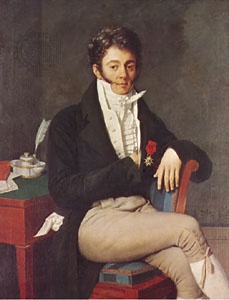 A covered-up look dominated male attire from the 17th until the late 18th century, when the Neoclassical movement led to tighter, more revealing clothes. Skin-coloured knee breeches in buckskin became the rage, and waistcoats shrank, so that from the waist downward the male form was again on show. A naked style affected the army too; uniforms became skintight, and the male form was displayed most obviously in the Napoleonic period. Under Queen Victoria the frock coat concealed all such shocking elements as legs, waist, and genitals, which remained concealed until after World War II, when skintight jeans became the means for a renewal of male sexual display. By the 1990s, Lycra had entered at least some men's wardrobes in the form of leisure wear, its clinging characteristics providing even more extreme “naked” outlines. Thus, since the 14th century in the West, the degree of exposure of the male body has alternated between total concealment and complete display.
A covered-up look dominated male attire from the 17th until the late 18th century, when the Neoclassical movement led to tighter, more revealing clothes. Skin-coloured knee breeches in buckskin became the rage, and waistcoats shrank, so that from the waist downward the male form was again on show. A naked style affected the army too; uniforms became skintight, and the male form was displayed most obviously in the Napoleonic period. Under Queen Victoria the frock coat concealed all such shocking elements as legs, waist, and genitals, which remained concealed until after World War II, when skintight jeans became the means for a renewal of male sexual display. By the 1990s, Lycra had entered at least some men's wardrobes in the form of leisure wear, its clinging characteristics providing even more extreme “naked” outlines. Thus, since the 14th century in the West, the degree of exposure of the male body has alternated between total concealment and complete display.Female display
Views on female display have also changed dramatically. In “primitive” societies living in hot climates, almost total nudity was acceptable for both sexes. However, with the rise of Christianity, and 600 years later of Islam (Islām), covering of the female form became compulsory. Meant to simultaneously demonstrate and inculcate modesty, both religions exhorted women to be clothed from head to foot. St. Paul (Paul, the Apostle, Saint) wrote to Timothy “that women should adorn themselves modestly and sensibly in seemly apparel, not with braided hair or gold or pearls or costly attire but by good deeds, as befits women who profess religion.” St. Peter expressed similar views, and St. Augustine (Augustine, Saint) of Hippo censured makeup as well, although he allowed that a woman might adorn herself slightly to please her husband if the practice was carried out in private. Traditions of modest dress are expressed today in the apparel worn by women who are conservative Muslims or members of “plain” Christian groups such as the Amish and Mennonites (Mennonite).
From 381, when Theodosius I made Christianity compulsory in the Roman Empire, Christian views on modesty dominated women's apparel. These views not only mandated the covering of the body and hair but also maintained that the fabric and fasteners of the covering itself should be modest. Later, Diocletian divided the Roman Empire into two parts, and Constantine I the Great (Constantine I) founded another capital, Constantinople (Istanbul). Eastern Rome on the Bosporus adopted the Eastern taste for coloured and patterned fabrics, and after 552, when the emperor Justinian I established the first silk-manufacturing industry in Europe in Constantinople, the city became renowned for its luxurious silks (silk) and brocades (brocade).
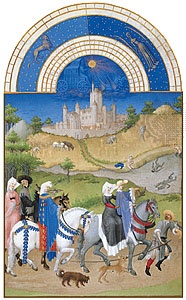 Meanwhile, western Rome suffered barbarian invasions and centuries of disorder until it broke up into separate kingdoms. Once these new courts had established themselves, they, too, started trying to outdress and outshine one another. The Anglo-Saxons (Anglo-Saxon), for example, wore loose clothes, but after the Norman Conquest (1066) members of the court started wearing tighter-fitting clothes. This was achieved by cutting the garments on the bias and lacing them under the arm, with the result that the female figure in particular was outlined very obviously. Although abbots (abbot) and bishops objected vehemently, the new fashion for displaying the physique continued unabashed. This style, which also featured exaggerated cuffs reaching the ground, dominated the 1100s. By the 1340s necklines had become so wide that they were almost off the shoulder. Moreover, the adoption of buttonholes from the Moors (Moor) around 1250 had introduced the art of tailoring. Clothes could now be cut very tight and still be easily removed. Shaped seams evolved, and the possession of a shapely figure was essential for both men and women. By 1400 women's waistlines were higher, emphasizing the bosom and making the differences between the sexes obvious. The exposure of the female neck became almost permanent in court circles thenceforth.
Meanwhile, western Rome suffered barbarian invasions and centuries of disorder until it broke up into separate kingdoms. Once these new courts had established themselves, they, too, started trying to outdress and outshine one another. The Anglo-Saxons (Anglo-Saxon), for example, wore loose clothes, but after the Norman Conquest (1066) members of the court started wearing tighter-fitting clothes. This was achieved by cutting the garments on the bias and lacing them under the arm, with the result that the female figure in particular was outlined very obviously. Although abbots (abbot) and bishops objected vehemently, the new fashion for displaying the physique continued unabashed. This style, which also featured exaggerated cuffs reaching the ground, dominated the 1100s. By the 1340s necklines had become so wide that they were almost off the shoulder. Moreover, the adoption of buttonholes from the Moors (Moor) around 1250 had introduced the art of tailoring. Clothes could now be cut very tight and still be easily removed. Shaped seams evolved, and the possession of a shapely figure was essential for both men and women. By 1400 women's waistlines were higher, emphasizing the bosom and making the differences between the sexes obvious. The exposure of the female neck became almost permanent in court circles thenceforth.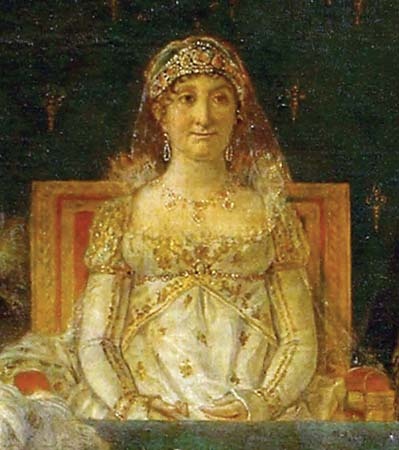 It was not until the end of the 18th century, when Neoclassical taste came to the fore, that the exposure of the female form was again a major issue. When the English novelist Fanny Burney (Burney, Fanny) visited Paris in April 1802, her modest wardrobe was found too full: “Three petticoats! no one wears more than one! Stays? everybody has left off even corsets! Shift-sleeves? not a soul now wears even a chemise.” In an homage to the styles of Classical Greece and Rome, women adopted high-waisted, diaphanous gowns.
It was not until the end of the 18th century, when Neoclassical taste came to the fore, that the exposure of the female form was again a major issue. When the English novelist Fanny Burney (Burney, Fanny) visited Paris in April 1802, her modest wardrobe was found too full: “Three petticoats! no one wears more than one! Stays? everybody has left off even corsets! Shift-sleeves? not a soul now wears even a chemise.” In an homage to the styles of Classical Greece and Rome, women adopted high-waisted, diaphanous gowns.With the end of the Napoleonic Wars, a more covered-up style developed. But the Victorians were not as prudish as people think. Crinolines (crinoline) revealed the ankles, and corsets emphasized female curves. Evening dresses had very low necklines. The narrower skirts of the 1870s and 1880s allowed the outline of a woman's legs to be seen.
Also influential in the late 19th century was the vogue for women's sports, and some freer clothes evolved in consequence. Amelia Bloomer's reformed trousers (“ bloomers”) for women did not become fashionable, but they were adopted by women gymnasts, sea bathers, and cyclists. Shorter skirts were designed for walking, golfing, shooting, and tennis.
 The acceptance of less cumbersome costumes for sports affected swimwear (swimsuit), and, once the designer Coco Chanel (Chanel, Coco) made suntans the rage, exposure of the female form became almost total. Sunbathing suits revealed more of the female anatomy than any costume since antiquity: whereas in the past ladies had gone to great lengths to avoid being browned by the sun (for a sunburned complexion was the mark of a peasant), there was an almost universal vogue for sun worship in the West from the 1920s until the 1980s, when heavy sun exposure began to be warned against, with doctors stressing the dangers of skin cancer. The backless evening dresses of the 1920s and '30s required a suntan to display and in cut were practically bathing costumes with skirts. The 1950s launched the Bikini, which provided minimal coverage for women and was followed by the acceptance of even total nudity on some designated beaches.
The acceptance of less cumbersome costumes for sports affected swimwear (swimsuit), and, once the designer Coco Chanel (Chanel, Coco) made suntans the rage, exposure of the female form became almost total. Sunbathing suits revealed more of the female anatomy than any costume since antiquity: whereas in the past ladies had gone to great lengths to avoid being browned by the sun (for a sunburned complexion was the mark of a peasant), there was an almost universal vogue for sun worship in the West from the 1920s until the 1980s, when heavy sun exposure began to be warned against, with doctors stressing the dangers of skin cancer. The backless evening dresses of the 1920s and '30s required a suntan to display and in cut were practically bathing costumes with skirts. The 1950s launched the Bikini, which provided minimal coverage for women and was followed by the acceptance of even total nudity on some designated beaches. government regulation of dress
Sumptuary laws (sumptuary law)
For thousands of years governments have tried to control spending by employing sumptuary laws (sumptuary law). The first such law under the Roman Republic (Roman Republic and Empire), the Lex Oppia, was enacted in 215 BCE; it ruled that women could not wear more than half an ounce of gold upon their persons and that their tunics should not be in different colours. Most Roman sumptuary laws tried to control spending on funerals, banquets, and festivals; there were no further laws on dress until the emperor Tiberius ruled that no silken clothing should disgrace men. Such a soft fabric as silk was considered fit only for women; the Roman male was to be a tough and severe character who did not wear Eastern imports. By 303 CE, however, Diocletian's (Diocletian) Edict on Maximum Prices mentions the sarcinator, a professional tailor who made only silk clothing, and so the business seems to have expanded despite Tiberius's efforts to contain it.
It was not until the 1300s, when national governments had been established in France and England and city-states formed in Italy, that sumptuary laws appear in any number in the rest of Europe. In 1322 Florence forbade the wearing of silk and scarlet cloth by its citizens outside their houses. In 1366 Perugia banned the wearing of velvet, silk, and satin within its boundaries. The impact of such legislation can be seen in the wardrobe of Francesco di Marco Datini (Datini, Francesco), a merchant of Prato. Despite the fact that he had business houses from Avignon to Spain as well as in Italy and was the equivalent of a modern millionaire, his finest gowns in 1397 were made of woolen cloth, their only hint of luxury provided by a taffeta lining. The law did not permit the commercial classes to own garments made of velvet, brocade, silk, or other rich fabrics.
 Whereas Roman sumptuary law had applied equally to all women and all men, in western Europe the laws were more discriminatory, restricting the richest fabrics, furs, and jewels to the aristocracy. Thus, in England in 1337 Edward III ruled that no one below the rank of knight could wear fur. The same law also decreed that only English-made cloth could be worn in England. This dual role of ensuring class distinctions and banning imported goods was common in sumptuary law. In 1362 Edward III issued another edict aimed at preventing people from dressing above their station. Merchants could wear the same clothes as an esquire or knight, but only if they were five times wealthier. Yeomen and below could not wear silk, cloth of silver, chains, jewels (jewelry), or buttons (which were then made of expensive materials or gems). They were not to wear the short coats or tunics worn by noblemen. Carters, plowmen, shepherds, oxherds, cowherds, swineherds, dairymen, and farm labourers were to wear only russet cloth at a shilling a yard and undyed blanket cloth. Thus, farming folk were restricted to natural wool tone and russet, and they continued wearing such colours into the 20th century. Only lords might wear cloth of gold and sable furs. Esquires and gentlemen were not allowed velvet, satin, ermines (ermine), or satin damask unless they were sergeants of the royal household. Women could not wear gold or silver girdles, nor foreign silk head covers.
Whereas Roman sumptuary law had applied equally to all women and all men, in western Europe the laws were more discriminatory, restricting the richest fabrics, furs, and jewels to the aristocracy. Thus, in England in 1337 Edward III ruled that no one below the rank of knight could wear fur. The same law also decreed that only English-made cloth could be worn in England. This dual role of ensuring class distinctions and banning imported goods was common in sumptuary law. In 1362 Edward III issued another edict aimed at preventing people from dressing above their station. Merchants could wear the same clothes as an esquire or knight, but only if they were five times wealthier. Yeomen and below could not wear silk, cloth of silver, chains, jewels (jewelry), or buttons (which were then made of expensive materials or gems). They were not to wear the short coats or tunics worn by noblemen. Carters, plowmen, shepherds, oxherds, cowherds, swineherds, dairymen, and farm labourers were to wear only russet cloth at a shilling a yard and undyed blanket cloth. Thus, farming folk were restricted to natural wool tone and russet, and they continued wearing such colours into the 20th century. Only lords might wear cloth of gold and sable furs. Esquires and gentlemen were not allowed velvet, satin, ermines (ermine), or satin damask unless they were sergeants of the royal household. Women could not wear gold or silver girdles, nor foreign silk head covers.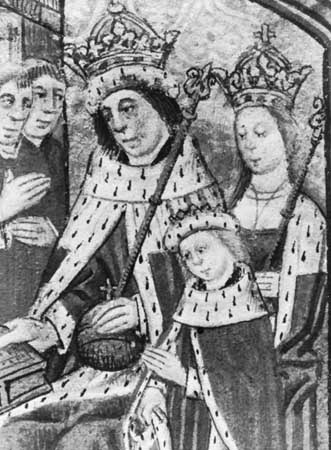 Similar laws explicitly stipulating the fabrics, styles, and colours (colour) to be worn by men and women of particular social or economic standing were issued in Spain and France as well. Furthermore, in France and England it was often claimed that such laws were issued for moral or religious reasons. For example, in 1583 Henry III of France decreed that in order to regularize and reform clothing, which was dissolute and superfluous, the wearing of precious stones and pearls on garments was restricted to princes. The richest fabrics allowed were velvet, satin, damask, and taffeta, all without any enrichment beyond silk linings. Bands of embroidery in gold and silver were banned. Henry III stressed that God was angry because he could not recognize a person's quality from his clothes. A similar excuse had been given in England in 1463 when Edward IV issued a sumptuary law on the grounds that God was displeased by excessive and inordinate apparel.
Similar laws explicitly stipulating the fabrics, styles, and colours (colour) to be worn by men and women of particular social or economic standing were issued in Spain and France as well. Furthermore, in France and England it was often claimed that such laws were issued for moral or religious reasons. For example, in 1583 Henry III of France decreed that in order to regularize and reform clothing, which was dissolute and superfluous, the wearing of precious stones and pearls on garments was restricted to princes. The richest fabrics allowed were velvet, satin, damask, and taffeta, all without any enrichment beyond silk linings. Bands of embroidery in gold and silver were banned. Henry III stressed that God was angry because he could not recognize a person's quality from his clothes. A similar excuse had been given in England in 1463 when Edward IV issued a sumptuary law on the grounds that God was displeased by excessive and inordinate apparel.In the 17th century sumptuary laws were increasingly used to restrict foreign imports and had begun to have less to do with status than with trade wars. France, for example, was trying to set up its own silk industry and therefore banned Italian silks and English cloth. Italy and Spain, however, continued issuing class restrictions on dress until 1800.
Other types of legislation
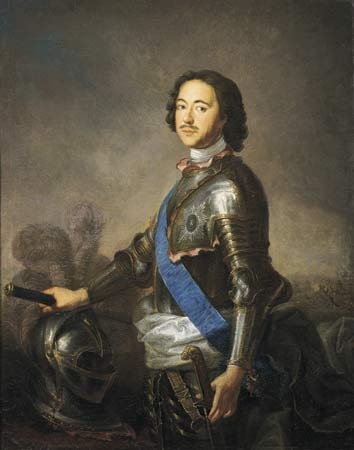 In Russia, laws regarding apparel were used to modernize the country. As soon as Tsar Peter I the Great returned from working in the dockyards of Amsterdam and London in 1697–98, he began requiring his princes to shave their beards. Then in 1701 he ruled that his subjects must adopt Western dress. Peter's command applied to both men and women but at first affected only members of the court and government officials. Merchants and peasants continued to wear traditional garments into the 19th and sometimes even the 20th century.
In Russia, laws regarding apparel were used to modernize the country. As soon as Tsar Peter I the Great returned from working in the dockyards of Amsterdam and London in 1697–98, he began requiring his princes to shave their beards. Then in 1701 he ruled that his subjects must adopt Western dress. Peter's command applied to both men and women but at first affected only members of the court and government officials. Merchants and peasants continued to wear traditional garments into the 19th and sometimes even the 20th century.A similar attempt to modernize a nation through its clothing was made by Kemal Atatürk (Atatürk, Kemal) (Mustafa Kemal) in Turkey in 1925. Laws were passed banning the fez and requiring Panama hats to be worn. To some Turks, wearing Western attire instead of traditional garments was akin to heresy, but Atatürk succeeded in changing dress, in the cities at least. With the rise of fundamentalist Islam in the late 20th century, Western styles of dress again became a subject of controversy in Turkey. Some Turks demanded that women be required to cover their heads and men to wear beards. The government responded by imposing fines on women who wore head scarves as a Muslim gesture.
In other countries, clothing legislation has been passed to ensure the preservation of local identity and dress in the face of encroaching foreign cultures. In Iran, for example, following the Islamic revolution in the late 1970s, laws that had encouraged Western customs and clothing were replaced by ones that enforced traditional Islamic codes of dress and behaviour (see Shariʾa (Sharīʿah)).
In the West the most recent government restrictions of clothing occurred during World Wars I and II, when shortages prompted the establishment of clothes- rationing systems.
Rebellion
Rebellion against the established or dominant fashion has been a constant theme in the history of costume. The reasons prompting such rebellion are various: to shock, to attract attention, to protest against the traditional social order, to avoid current trends and thereby avoid looks soon considered dated or outmoded. One of the earliest forms such rebellion has taken—and continues to take—has been that of women adopting male dress (transvestism). By donning men's clothing, women have been able to challenge the status quo and participate in activities or roles traditionally perceived as masculine.
There are several examples of women in antiquity who put on male armour to go to war. Herodotus cites Queen Tomyris of the Massagetai, who led her troops against Cyrus II the Great of Persia and killed him in 529 BCE. The ancient author also records Queen Artemisia I, who commanded her own ships in 480 BCE when she sailed with the navy of Xerxes I, who valued her opinions highly. Queen Boudicca of the Iceni tried to drive the Romans out of Britain in 61 CE. The Saxon king Alfred appointed his daughter Aethelflaed commander in chief of the west, and she successfully liberated Derby and Leicester from the Danes in 917–918. In 1080 Duchess Gaita of Lombardy rode in full male armour alongside her husband.
The practice of women wearing male dress has not always been accepted (etiquette), however. In 1429 Joan of Arc (Joan of Arc, Saint) adopted male clothes, and this wearing of male dress was included among the charges against her when she was tried by the bishop of Beauvais. The bishop said her claim that God, angels, and saints had told her to don male attire was contrary to the modesty of women, was prohibited by divine law, and was forbidden by ecclesiastical censure on pain of anathema. If her voices had told her to dress as a man, why had she chosen such short, tight, and dissolute garments as tabards, cottes, and elaborate hats, and why had she cut her hair like a man, with a shaved neck? Joan confessed to error and was ordered to wear women's clothing. Nevertheless, she reverted to male dress in prison, which the bishop claimed was a sign that she had reneged on her confession. On further questioning, Joan recanted her confession and was condemned to be burned.
It has not been only for reasons of war or to defend their homes that women have adopted men's clothing. British historian Henry Knighton (Knighton, Henry) complained in 1348 that some 40 or 50 English ladies were arriving at tournaments in male dress and armour to parade in the intervals, so that they might share in the glory of a tourney. Knighton claimed that God so was incensed at this behaviour that he sent thunderstorms to drive the women indoors.
Women also have found men's clothing more suitable for certain types of work. The women pirates (piracy) Mary Read and Ann Bonney donned trousers when at sea until their capture in 1720. In 1745 Britain's Hannah Snell joined the marines and served in India for five years, wearing a male uniform all the time. It was not only a wish for action that made some women adopt male clothing. In the 19th century there were several examples of women doing so in order to earn a man's wages, which were higher than a woman's. In 1818 Helen Oliver in Scotland met a plowman who turned out to be a woman, so she copied the idea and, borrowing her brother's suit, went off to work as a plasterer. By 1866 Helen Bruce had been working in male dress since she was 17, as an errand boy, shop lad, ship's stoker, tallyman at a mine, and clerk. As women were not allowed to become doctors, Miranda Barry dressed as a man and obtained a degree in medicine at the University of Edinburgh (Edinburgh, University of). She then became an army surgeon and ended her career as inspector general of military hospitals in Canada in 1857, after serving in the Crimean War.
Cultural rebels have often chosen to adopt antique fashions in order to reject, or at least distance themselves from, their own time or to identify with what they believed to be a superior age. Sometimes such borrowings from the past become a widely accepted fashion, as in the late 18th and early 19th centuries, when Neoclassicism was at its height and women's gowns were supposed to be based on ancient Greek and Roman styles. More frequently, however, the practice remains on fashion's fringes. It has nevertheless persisted since ancient times.
 The Roman empress Messalina Valeria led a revolt against Roman dress by wearing Greek clothes herself (coloured Ionic chitons (chiton) fastened down the arms with bejeweled brooches) and by wearing her hair in Greek hairnets and tiaras (tiara). Her male friends similarly wore coloured Greek cloaks instead of the chalky white Roman toga. More recently, in the 1960s and '70s, many young men and women in the United States adopted the “granny” look. By wearing garments that had been popular 100 years before, such as collarless shirts, long, high-waisted cotton dresses, and small, metal-rimmed “granny” glasses, the wearers expressed their disdain for the contemporary adult establishment and their dress.
The Roman empress Messalina Valeria led a revolt against Roman dress by wearing Greek clothes herself (coloured Ionic chitons (chiton) fastened down the arms with bejeweled brooches) and by wearing her hair in Greek hairnets and tiaras (tiara). Her male friends similarly wore coloured Greek cloaks instead of the chalky white Roman toga. More recently, in the 1960s and '70s, many young men and women in the United States adopted the “granny” look. By wearing garments that had been popular 100 years before, such as collarless shirts, long, high-waisted cotton dresses, and small, metal-rimmed “granny” glasses, the wearers expressed their disdain for the contemporary adult establishment and their dress.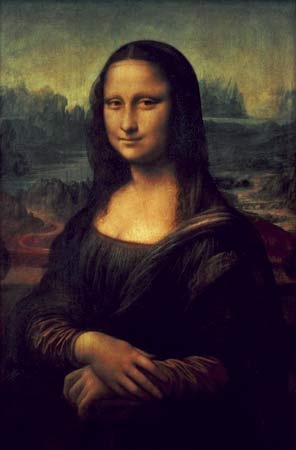 Artists have similarly often preferred older fashions, but this is usually because they wish to achieve an effect of timelessness. Leonardo da Vinci wrote in his Treatise on Painting, published long after his death, that art should avoid the fashion:As far as possible avoid the costumes of your own day. . . . Costumes of our period should not be depicted unless it be on tombstones, so that we may be spared being laughed at by our successors for the mad fashions of men and leave behind only things that may be admired for their dignity and beauty.
Artists have similarly often preferred older fashions, but this is usually because they wish to achieve an effect of timelessness. Leonardo da Vinci wrote in his Treatise on Painting, published long after his death, that art should avoid the fashion:As far as possible avoid the costumes of your own day. . . . Costumes of our period should not be depicted unless it be on tombstones, so that we may be spared being laughed at by our successors for the mad fashions of men and leave behind only things that may be admired for their dignity and beauty.He showed how to tackle the problem in his portrait Mona Lisa, by dressing her in a coloured shift that is loosely pleated at the neck instead of the tight clothes that were then popular.
This concept spread through western Europe over the following centuries. In the 17th century many rulers were depicted as Roman emperors in Roman armour, considered the ideal symbol for the age of absolute monarchy, and it became a sign of sophistication to look Roman in one's portrait, even if the sitter was wearing a periwig at the same time. (People were reluctant to change their hairstyles to an antique manner, as they had to wear them to and from the artists' studios.) In the 18th century, aristocrats had copies made of the clothes in their ancestors' portraits to wear at masquerades and in their own portraits. Although the practice was a cultural revolt against the tyranny of contemporary fashion, the clothing was generally expressed with current tastes in mind.
 Artistic reform of dress in the 19th century was initiated by the Pre-Raphaelite Brotherh (Pre-Raphaelite Brotherhood)ood in 1848, and by the 1860s the “Aesthetic” dress they promoted began to be adopted in sophisticated societies. The invention and widespread use of photography (photography, history of) has effectively abolished any further need for the establishment of a specific clothing policy for art in opposition to that of high fashion. It has become acceptable for painters and sculptors—like photographers—to render contemporary fashions accurately. Extreme trends are still usually avoided, however, and portraitists of royalty often use uniforms and robes of orders of knighthood to confer a historical character.
Artistic reform of dress in the 19th century was initiated by the Pre-Raphaelite Brotherh (Pre-Raphaelite Brotherhood)ood in 1848, and by the 1860s the “Aesthetic” dress they promoted began to be adopted in sophisticated societies. The invention and widespread use of photography (photography, history of) has effectively abolished any further need for the establishment of a specific clothing policy for art in opposition to that of high fashion. It has become acceptable for painters and sculptors—like photographers—to render contemporary fashions accurately. Extreme trends are still usually avoided, however, and portraitists of royalty often use uniforms and robes of orders of knighthood to confer a historical character.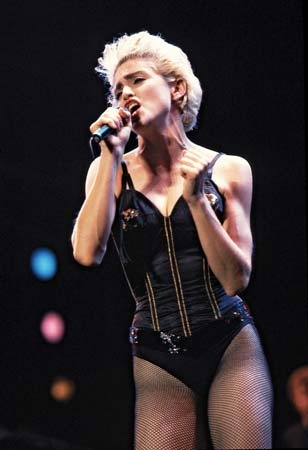 In 1783 Queen Marie-Antoinette was painted wearing a white muslin chemise (smock) dress—to the horror of the French silk industry (which considered the use of muslin an affront) and to the elderly and conservative, who considered the chemise an undergarment. Such use of underwear as outerwear has been recurrent in fashion history and has continued into modern times, as can be seen by the popularity of the bustier among young women in the 1980s and the slip dress among young women of the early 21st century.
In 1783 Queen Marie-Antoinette was painted wearing a white muslin chemise (smock) dress—to the horror of the French silk industry (which considered the use of muslin an affront) and to the elderly and conservative, who considered the chemise an undergarment. Such use of underwear as outerwear has been recurrent in fashion history and has continued into modern times, as can be seen by the popularity of the bustier among young women in the 1980s and the slip dress among young women of the early 21st century.Similarly, the desire to shock has remained a constant, especially among the young, who since World War II have had a significant influence on the fashion scene. Postwar teenagers have had both the money and the leisure time necessary to reject the established order and to devise a look of their own. Included among the styles they introduced are the T-shirts and jeans of the 1950s, the long-haired hippie look of the 1960s, the punk rock (punk) look of the late 1970s, the conservative preppie or Sloanie look of the 1980s, the grunge rock (grunge) look of the 1990s, and, in the 2000s, looks based on the musical styles of emo and hip-hop.
Exotica
Like rebellion, the adoption of foreign elements has been a constant theme in the history of dress, and it too dates to antiquity. The first exotic fabric to reach the West was silk from China, which the Persians introduced to the Greeks and Romans and which has remained popular to the present. Another early import was the caftan coat, which is believed to have originated in Central Asia and which appeared among the Hittites (Hittite), the Assyrians, and the Medes (Mede) and Persians by 700 BCE. During the Hellenistic Age Greek tunics were introduced into the Middle East, but the caftan continued to be worn in Persia. The caftan eventually made its way to Russia, where it was described by the Arab traveler Ibn Fadlan in 922 CE when he saw a Viking chief's funeral on the Volga (Volga River); the chief's body was dressed in a caftan of cloth of gold with golden buttons and a gold cap trimmed with sable (fur). The Turks also adopted caftans, and they then brought the style to Hungary and Poland when they conquered those lands. Subsequently, there were occasional vogues for Turkish dress in Italy, Germany, and England, and the caftan became the model for later Western garments featuring fitted backs and open fronts.
 The Japanese kimono entered the Western wardrobe in the 17th century. The English called the garments “Indian gowns,” probably because the East India Company imported them, but the Dutch more accurately called them “Japanese coats.” The garment was also termed a nightgown and a banyan and became fashionable for undress. The diarist Samuel Pepys (Pepys, Samuel) bought himself an Indian gown on July 1, 1661, for 34 shillings. He further recorded that on Nov. 21, 1666, “I to wait on Sir Ph. Howard, whom I find dressing himself in his night-gown and Turban like a Turke.” Strictly speaking, the Indian gown was meant to be worn for informal, private occasions, but a superior like Sir Philip Howard could wear such clothing to receive underlings, though they had to be fully dressed to attend him. The first nightgowns were cut loose like the Japanese originals, but in the late 18th century they became more fitted and tailored like coats. Such dressing gowns have remained fashionable and are now known as housecoats, bathrobes, wraps, and negligees depending on the material used. Indian pajamas, a soft cotton suit consisting of trousers and a loose, fitted jacket fastened down the front, were also introduced into Europe in the early 17th century. They, too, have remained popular for undress, although the style has sometimes also been adopted for more formal wear.
The Japanese kimono entered the Western wardrobe in the 17th century. The English called the garments “Indian gowns,” probably because the East India Company imported them, but the Dutch more accurately called them “Japanese coats.” The garment was also termed a nightgown and a banyan and became fashionable for undress. The diarist Samuel Pepys (Pepys, Samuel) bought himself an Indian gown on July 1, 1661, for 34 shillings. He further recorded that on Nov. 21, 1666, “I to wait on Sir Ph. Howard, whom I find dressing himself in his night-gown and Turban like a Turke.” Strictly speaking, the Indian gown was meant to be worn for informal, private occasions, but a superior like Sir Philip Howard could wear such clothing to receive underlings, though they had to be fully dressed to attend him. The first nightgowns were cut loose like the Japanese originals, but in the late 18th century they became more fitted and tailored like coats. Such dressing gowns have remained fashionable and are now known as housecoats, bathrobes, wraps, and negligees depending on the material used. Indian pajamas, a soft cotton suit consisting of trousers and a loose, fitted jacket fastened down the front, were also introduced into Europe in the early 17th century. They, too, have remained popular for undress, although the style has sometimes also been adopted for more formal wear.Many foreign garments are copied or borrowed of necessity. For example, when the Europeans invaded the Americas, the English and the French were quick to adopt Native American moccasins (moccasin) because few of the settlers knew how to make shoes. Similarly, in Canada the indigenous snowshoe was essential footwear, and many hunters and trappers adopted fringe on their deerskin tunics (tunic) as a practical embellishment that helped rain to run off the garment. When winter sports became fashionable in the 20th century, the padded boots and parkas (parka) of the Arctic peoples (Arctic) were copied.
The modern Western wardrobe can include elements of Asian, African, and Native American dress. Similarly, non-Western cultures have adopted some Western garments, particularly the Western-style business suit. As improved transportation and communication technology effectively shrink the size of the world, foreign influences on dress will no doubt continue to be introduced with increasing speed and influence.
Additional Reading
General works
Broad histories of Western dress and clothing accessories, spanning many centuries of development, include François Boucher and Yvonne Deslandres, 20,000 Years of Fashion: The History of Costume and Personal Adornment, new ed. (1987; also published as A History of Costume in the West; originally published in French, 1983); Millia Davenport, The Book of Costume, 2 vol. (1948, reissued in 1 vol., 1976); Phyllis G. Tortora and Keith Eubank, Survey of Historic Costume, 4th ed. (2004); James Laver and Christina Probert, Costume and Fashion: A Concise History, new ed. (1982); Richard Corson, Fashions in Makeup: From Ancient to Modern Times (1972), and Fashions in Hair: The First Five Thousand Years (1969, reissued 1984); Alfred Rubens, A History of Jewish Costume, new and enlarged ed. (1973, reissued 1981); and Christopher Breward, The Culture of Fashion: A New History of Fashionable Dress (1995). More thematically oriented studies include Margot Hamilton Hill and Peter A. Bucknell, The Evolution of Fashion: Pattern and Cut from 1066 to 1930 (1967, reprinted 1987); C. Willett Cunnington and Phillis Cunnington, The History of Underclothes, new rev. ed., by A.D. Mansfield and Valerie Mansfield (1981); Diana De Marly, Working Dress: A History of Occupational Clothing (1986); and Penelope Byrde, The Male Image: Men's Fashion in Britain, 1300–1970 (1979).
Ancient dress
Clothes of the early period of civilization are studied in Mary G. Houston, Ancient Egyptian, Mesopotamian & Persian Costume and Decoration, 2nd ed. (1954, reprinted 1972), and Ancient Greek, Roman, and Byzantine Costume & Decoration, 2nd ed. (1947, reprinted 1966); Lillian M. Wilson, The Clothing of the Ancient Romans (1938), and The Roman Toga (1924); Hans C. Broholm and Margrethe Hald, Costumes of the Bronze Age in Denmark, trans. from Danish (1940); and Erhard Klepper, Costume in Antiquity (1964; originally published in German, 1963).
Medieval dress
Readable and well-illustrated accounts of the developments in Western fashion include Stella Mary Newton, Fashion in the Age of the Black Prince: A Study of the Years 1340–1365 (1980); Mary G. Houston, Medieval Costume in England & France: The 13th, and 14th, and 15th Centuries (1939, reprinted 1965); and Joan Evans, Dress in Mediaeval France (1952).
Modern Europe
Histories of the fashion of various countries and stylistic trends include Valerie Steele, Paris Fashion: A Cultural History, 2nd ed., rev. and updated (1998); Ailene Ribeiro and Valerie Cummings, The Visual History of Costume (1989); Anne Buck, Dress in Eighteenth-Century England (1979), and Victorian Costume: And Costume Accessories, rev. 2nd ed. (1984); Norah Waugh, Corsets and Crinolines (1954, reissued 1987); Madge Garland, Fashion (1962); Diana De Marly, The History of Haute Couture, 1850–1950 (1980); Elizabeth Ewing, History of Twentieth Century Fashion, rev. ed. (1986); and Farid Chenoune, A History of Men's Fashion (1993).For insights into the work of fashion designers, see Caroline Rennolds Milbank, Couture (1985); Irving Penn and Diana Vreeland, Inventive Paris Clothes, 1909–1939: A Photographic Essay (1977). See also such biographies and autobiographies as Diana De Marly, Worth: Father of Haute Couture, 2nd ed. (1990); Palmer White, Poiret (1973); Christian Dior, Christian Dior and I (1957; originally published in French, 1956; also published as Dior: The Autobiography of Christian Dior); Mary Quant, Quant by Quant (1966, reissued 1974); Elsa Schiaparelli, Shocking Life (1954); and Jane Mulvagh, Vivienne Westwood (1998).
American dress
Histories of American costume include Diana De Marly, Dress in North America: The New World, 1492–1800 (1990); Elisabeth Mcclellan, Historic Dress in America, 1607–1800 (1904), and Historic Dress in America, 1800–1870 (1910), reprinted together as Historic Dress in America, 1607–1870, 2 vol. (1990); Alice Earle, Two Centuries of Costume in America, 1620–1820, 2 vol. (1903, reprinted 1974); Estelle Ansley Worrell, Children's Costume in America, 1607–1910 (1980); R. Turner Wilcox, Five Centuries of American Costume (1963, reissued 1988); and Caroline Rennolds Milbank, New York Fashion (1989, reissued 1996).
Asian dress
Asian clothing is explored and illustrated in Valerie Steele and John S. Major, China Chic: East Meets West (1999); Alan Priest, Costumes from the Forbidden City (1945, reissued 1974); Schuyler V.R. Cammann, China's Dragon Robes (1952); A.C. Scott, Chinese Costume in Transition (1958); Seiroku Noma, Japanese Costume and Textile Arts (1974; originally published in Japanese, 1965); Helen Benton Minnich, Japanese Costume and the Makers of Its Elegant Tradition (1963); G.S. Ghurye, Indian Costume, 2nd ed. (1966); and S.N. Dar, Costumes of India and Pakistan: A Historical and Cultural Study (1969).
Nature and purpose of dress
Social and psychological aspects of dress and the place of fashion in human culture are the subject of many works representing various disciplines. See John C. Flügel, The Psychology of Clothes (1930, reissued 1976); Quentin Bell, On Human Finery, 2nd ed., rev. and enlarged (1976); Anne Hollander, Seeing Through Clothes (1978, reissued 1988); Elizabeth Wilson, Adorned in Dreams: Fashion and Modernity (1985); and Mary Ellen Roach-Higgins, Joanne B. Eicher, and Kim K.P. Johnson, Dress and Identity (1995).
- Camerata
- Cameron
- Cameron, David
- Cameron, Duncan
- Cameron Highlands
- Cameronian
- Cameron, James
- Cameron, Julia Margaret
- Cameron, Richard
- Cameron, Simon
- Cameron, Sir Ewen
- Cameron, Verney Lovett
- Cameroon
- Cameroon, flag of
- Cameroon, history of
- Cameroon, Mount
- Camiguin
- Camilla
- Camilla Collett
- Camilla, duchess of Cornwall
- Camilla Urso
- Camille Chamoun
- Camille Chautemps
- Camille Claudel
- Camille Corot